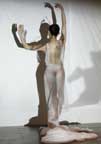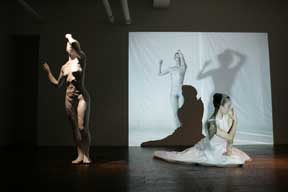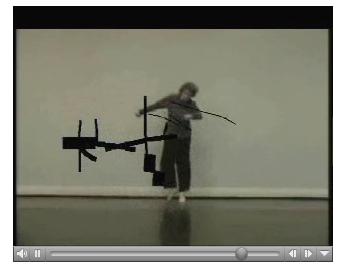« August 2005 | Main | October 2005 »
September 30, 2005
The Spectrascope
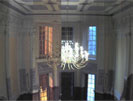
Haunted Pixels
Spectrascope, by Susan Collins, collects an image via a camera at the rate of one pixel a second from a haunted manor house - South Hill Park in Berkshire, England - and transmits it to the exhibition in Manchester, via the Internet, where it is projected onto a 6 ft screen. The image works its way across the room from top left to bottom right in vertical lines. At a resolution of 320 x 240 pixels each complete image represents the previous 21.33 hours of time and is updated continuously, with peculiar changes in light and fluctuations and inevitable 'ghosts in the machine' creating a sense of suspense.
The Spectrascope also introduces the 'fear frequency' to the gallery. This audio frequency of 19hz is just below the range of normal hearing, but it has been linked to distorted vision (including spectral images), discomfort, and "irrational" fear and has been found to be present at sites of "haunted locations". Introducing this frequency to the gallery invites the viewer to question whether the frequency itself is creating the disturbance or whether the site of haunting is creating the frequency.
The installation explores how images can be coded and decoded using both light and time as building blocks for the work. In the Spectrascope time is counted across the room from top left to bottom right in vertical lines.
The installation is part of the StoryRoom exhibition. 11 October 2005 - 15 January 2006 at the Museum of Science and Industry, Manchester, UK. [blogged by Regine on we-make-money-not]
Posted by jo at 12:41 PM | Comments (0)
International SMS Chatwall
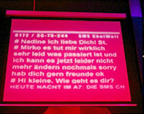
Outdoor Public Chat
The SMS projector system developed by Haase & Martin GbR is published in an English version. Short text messages, sent by any mobile phone, are received by the SMS Chatwall and shown on TV and by projector systems. Being developed for German speaking countries first, including Austria and Switzerland, the SMS Chatwall is offered to the international event sector now.
The SMS Chatwall receives short text messages, sent by any mobile phone and shows it on TV and projector systems. It is a new media event and promotion tool, separated into an administration and a visualization module. The administration module allows to look over incoming text messages before broadcasting them via projector system. All messages can be accepted, declined or edited by the administrator. Additionally all messages can be accepted automatically. Misuse is prevented. Together with the event organizer the administrator can display own messages or pictures to support an event with multi media screen content. [via]
Posted by jo at 12:14 PM | Comments (0)
motione
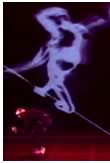
Bridging the Phyical-Digital Divide
motione: Using state of the art, real time motion capture technologies and motion analysis techniques, the movement of the dancers and the structures of the choreography are analyzed in real time. Through novel artificial intelligence and human-computer interaction systems, the results of the analysis informs the creation of digital graphics and sound environments that react to, accompany, enhance and comment on the choreography.
The works investigate future possibilities for interactive art works while exploring the effects of the new digital sensing, processing and creation possibilities on the human condition. They propose integrations paths that will allow these technologies to enhance and promote humanism.
The motione project of the Arts, Media and Engineering (AME) program at ASU, brings together choreographers Trisha Brown and Bill T. Jones; media artists Paul Kaiser, Shelley Eshkar and Marc Downie; composers Roger Reynolds and Curtis Bahn; lighting designer Robert Weirzel with AME artists and engineers for the creation of two ground breaking, interactive multimedia works, new motion analysis systems and interactive technologies. motione premieres on April 9th 2005 at ASU 's Galvin Playhouse.
motione is a joint project of the Arts, Media and Engineering Program through the Herberger College of Fine Arts, the Fulton School of Engineering. It is co-presented by ASU Public Events. We are grateful for support from the National Endowment for the Arts, the National Science Foundation, Motion Analysis Corporation, Lincoln Center, Arizona Public Service (APS) and City of Tempe Cultural Services.
[...]
The physical-digital divide in art
Today, a large percentage of content that is shaping our society reaches us through digitally enabled media (computers, cell phones, TV, movies). Yet, the majority of the established arts, creation, education and presentation communities concentrate solely on physical art manifestations presented in traditional venues (theaters, concert halls, galleries).
We still struggle to find effective ways to connect new forms of digital content to the maturity and sensitivity of traditional art forms. Addressing this divide by successfully integrating physical and digital art forms could raise the level of digital content and end the marginalization of traditional art.
The physical-digital divide in life
Our civilization is currently undergoing major changes. Traditionally, human beings acquired knowledge through experiential interactions with the physical world. That knowledge allowed them to better adapt to their reality and evolve.
Today, the electronic networked world is rapidly becoming an integral aspect of human reality. Our interactions with almost every element of our lives, from the weather, to our habitat, our bodies, our friends and relatives involve computation and mediated information.
However, as any dictionary would point out, knowledge results from experience. To adapt to this new world, we must bridge the gap between computational information and physical experience. We need unified experiences of the physical and computational forces that are shaping our reality.
Integrating the physical and the digital at multiple levels and dimensions
We experience the world concurrently at many different, interconnected levels, from the level of manifestation, to the level of operational structure and the level of semantics. It follows that a convincing physical-digital experience must be integrated at all those levels. All participating elements must contribute to a structurally, aesthetically and semantically coherent experience.
We also experience the world at multiple levels of time. Real time perception, short term memory, long term memory and social memory contribute to our experience. Our structural, aesthetic and semantic integrations must hold true across the multilayered dimension of time.
Finally, we experience the world in an interactive manner where our actions explore and influence our environment. Integrated physical-digital experiences require interactive digital media that allow for exploration while exhibiting adaptability.
Digital media are based on computation and our current society is deeply intertwined with computational infrastructures. It follows that structural integration of digital media into the physical world would have to rely on computation.
Creating embodied hybrid experiences
The music and visual arts communities have been working for the past two decades on creating hybrid physical digital music compositions, visual art works and installations. However, human experience of the world is embodied and multi-modal. Arts can best investigate and depict our current hybrid reality through multi-modal, interactive works that include movement. The main drawback for such works has been the difficulty of digitizing and analyzing movement.
Sampling, digital analysis and digital synthesis of sound and image are already fairly advanced. Complex processing of sound and image can be realized with good accuracy in real time. User-friendly software for interactive analysis and synthesis of sound and image are readily available.
Some of those packages (i.e. Max/MSP/Jitter) allow for the simultaneous processing of both image and sound. The tools for coherent, digital, sound-image interactive compositions are available and increasingly used in all types of settings--from installations in galleries, to jam sessions in music bars, symphonic concerts, educational settings and biodesign experiments.
Documentation and analysis of motion has until recently relied on 2D video capture that provides limited information on the spatial and kinesthetic aspects of movement and has limited capabilities in real time use.
The development of motion capture technology in the past two decades has opened up many possibilities for advanced digitization and analysis of movement. The motione project is developing techniques for advanced real time capture and analysis of movement. These motion analysis systems are being integrated with real time systems for image and sound analysis and synthesis to create unified platforms for the creation of multimodal physical-digital works. [...]
Posted by jo at 11:00 AM | Comments (0)
Here For You
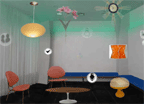
Redirect Surveillance, Control and Distance
Internet participants are invited to participate in a live network performance project opening Friday September 22nd at 7pm online and at the XINDUSTRIA exhibition at CAFKA 05, Kichener, Ontario. Here For You--by Will Pappenheimer--is a prototypical internet controlled space which allows virtual participants to adjust room lighting, see into the space, move objects, time clocks, upload messages and sound from your computer play it for the sound system. The guideline is to redirect surveillance, control and distance into channels of giving for physical visitors in the exhibition space. The exhibition continues through September 30.
This is a large ongoing project with dual physical and virtual levels and the challenges of connectivity and mechanics. It will begin simply develop as the exhibition proceeds.
“Here For You” will create a series of IP controlled conventional and fanciful domestic objects to comprise a network livingspace. Exhibition participants will be invited to relax in a living/domestic space constructed in or modified from available exhibition space. Appliances, both practical and artistic, can be controlled by anyone accessing the Internet from anywhere in the world. . The project hopes to create an environment where telepresence meets presence, remote control meets lifestyle, distance becomes proximity, surveillance becomes community and network becomes living room.
Posted by jo at 09:57 AM | Comments (0)
Mapping New Territories
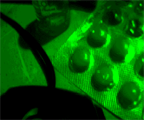
LOL (laughing out loud)
LOL: On jan 12th 2003, in Phoenix (USA), a 21-year old computer addict (called hereafter by his nickname "ripper") died of an overdosis of prescription drugs while chatting on the internet. Soon after this tragic event, a text file containing a transcription of the dialogs that occured in the chatroom appeared on numerous websites. Re-processing the dialogs recorded before, during and after his death, the N3KROZOFT MORD multimedia group expands the network tragedy into a caustic ectoplasmic seance.
"...N3krozoft Mord, a collective of media artists based in Geneva, have used the chat log as the script for a re-enactive performance. "The idea was to run this through again, like the film that runs before your eyes just before you die." The title LOL – the online acronym for "laughing out loud" – takes the chat’s commonest statement and uses it to describe the reactions of the participants as they sway between cynicism and helplessness..."
From the Mapping New Territories we site:
PERFORMANCE: 12.03.05, 19:00
The Fatal Failure of Telecommunications
LOL – a performance by N3krozoft Mord
[02:03:40]
[02:03:46]
[02:03:51]
These are the opening lines of an internet chat on 12 January 2003. Ripper is the code name of 21-year-old Brandon Vedas, who was to die at his home in Phoenix that night after taking a cocktail of prescription drugs while chatting with online acquaintances who were watching him on webcam. This tragic incident made the daily papers all over the world and within days, several websites had posted a chat log.
N3krozoft Mord, a collective of media artists based in Geneva, have used the chat log as the script for a re-enactive performance. "The idea was to run this through again, like the film that runs before your eyes just before you die." The title LOL – the online acronym for "laughing out loud" – takes the chat’s commonest statement and uses it to describe the reactions of the participants as they sway between cynicism and helplessness. Actor Nicolas Goulart plays Ripper, going through the actions that can be deduced from the text: Ripper sits, seems restless, drinks, smokes. He swallows pills. He broadcasts himself on webcam and, above all, he types intermittently at the keyboard. The actor replaces the original webcam footage, which was not recorded, and at the same time is the fictitious embodiment that recalls the lost presence of the dead man.
All the while, the chat log is screened in real time like film credits rolling: for 80 harrowing minutes the time code of the dialogue determines our sense of time. Life Images from a webcam focused on the actor are also screened. The authors of N3krozoft Mord intervene subtly in this sober yet obsessive repetition of the event. The footage of a second, moving camera is manipulated in situ as though mirroring the dying man’s drug-fuelled mental state. A troubling live sound track of booming sub-bass and high-frequency dissonance by the musician, 10111.org, underpins the moving image. The grim setting of Ripper’s desk, covered in equipment, paper, ashtrays, pizza boxes and glasses, is adapted from the opening scene of the film Matrix.
N3krozoft Mord’s manipulation of sound and image has a subliminal impact. It heightens the hypnotic magnetism of the authentic text, creating a mental space that acts as a resonator. Soon we find ourselves reacting as the participants did in the chat of January 2003, watching the bright green text unfold on the darkness of the screen, so mesmerised that we forget the reality unfolding in the room.
The virtual room in which Ripper and others are chatting is mainly about the abuse of prescription drugs. Press researchers have put the average age of the participants at 16. Ripper lists the drugs and the amounts and invites the others to watch him on webcam. Within 4 minutes and 9 seconds Phalaris has posted the cynical diagnosis: "attempted suicide # 84". At first, Ripper is egged on: "You pussy, you pussy, eat more." He takes it as a challenge, and boasts about his drug consumption and sexual exploits: "this is usual weekend behaviour, I told u fucks, u all said I was lying." Once it becomes clear that he is heading for a lethal overdose, some of them try to reason with him. Smoke2k writes: "look dude fucking cram it up your ass ... thats crazy ya know ... don't eat it... your already numb." Others send urgent virtual cries: "riipper ... RIPPER :((((" They even discuss whether to call the emergency services. But then they have their doubts – maybe Ripper is just acting out a suicide scene. Can the webcam be believed? Oea tries to call his bluff, then tries to coax Ripper back to life with a declaration of love. The medium heightens the kind of inaction that sometimes sets in among witnesses to a road accident. "you will never know if he died unless he get back on here," writes theKat, and grphish replies: "i know ... thats kinda freaky."
Another media-specific factor confuses matters: Pnutbot, who enters the conversation repeatedly at certain keywords, is not a human being capable of decision and action, but an automated chat robot. It remains a moot point whether Ripper himself programmed Pnutbot to throw in the poison control emergency number in a vain attempt to create some security within the casual framework of the chatroom. The kids in the chatroom are smart enough to find out, within seconds, the IP of the server and, with that the actual address of the anonymous Ripper. They have details – the lethal dose, the home address, the fact that his mother is in the room next door killing time with crosswords. But they do not add the bits together to a conclusive or binding narrative. Still less do they manage to translate them into the reality of the outside world and actually intervene.
In the chatroom, the gulf between simultaneous presence and absence offers protection, the liberty of risk-free intimate communication and a sense of belonging. In this serious situation, however, the same gulf becomes an insurmountable barrier. The young people are held back by the question as to what is real about what is happening in the virtual room. Or, to put it another way, what is fictional about the reality of what is happening. And quite a few of them cannot resist the temptation of simply withdrawing from their masked existence with impunity, from a chat that usually leaves only data trails, rarely corpses.
The simultaneity of presence and absence is mirrored in the setting of the performance without moral judgement. The audience is given a glimpse into both rooms, which cannot be brought together – neither in the actual incident nor in the performance. The gap between physical room and chatroom, between body and language, seals Ripper’s fate.
The N3krozoft Mord group, whose name itself combines computer and death, is interested in the subconscious, darker sides of telecommunication: "In the case of this chatroom protocol, what is unique is that the trail of the event itself describes the event. And it is a text that would not exist without the technical tools by which we communicate. It records and witnesses the death of a young man, but at the same time it is a statement about the vehicle of communication. ... The notion of telecommunication has always been linked with death. Even Edison’s phonographs were meant to record the voices of people so that they could still be heard after their deaths." The morbid aspect of telecommunication is also the subject of N3krozoft Mord’s latest audio work. Ubik is based on the sci-fi novel of the same name by Philip K. Dick, which describes how technology is used to retain the consciousness of the dead. With proper treatment, individuals become "half-lifers" and can communicate by voice from this semi-dead state, a kind of technically generated limbo. Fiction infiltrates our experience, whereas in Laughing out Loud, it is exactly the opposite: the fact of death tries in vain to penetrate the surface tension of a virtual community.
[02:55:32]
[02:55:46]
Text: Raffael Dörig und Annina Zimmermann
Credits
LOL – a performance by N3krozoft Mord
Idea & concept: N3krozoft Mord
Video projection, programming, installation: N3krozoft Mord
Audio: 10111.org
With support of: Bundesamt für Kultur/sitemapping.ch
www.n3krozoft.com
www.10111.org
Posted by jo at 09:47 AM | Comments (0)
New Media Art: Embodied Praxis
We are seeking submissions for the first edition of the journal New Media Art: Embodied Praxis. This journal will build dialogue about work that explores the intersections between emerging technologies and body, place, space & culture.
We are seeking art works, articles (research oriented or reflection on artistic process), interviews or art reviews that can be displayed in a online context for this debut edition. Work from researchers, academics and artists working with the body, space and new technologies are welcome.
We will consider all article abstracts of not more than one page and original art works received by October 24th 2005 for selection. Completed articles will need to be received by Nov 30th 2005. For consideration, please submit your work with a short (one paragraph) biography in electronic form by e-mail to this address: journal[at]liu.edu
Please also note, that if your work is accepted, the journal requires either a hard copy of your work or high-resolution files uploaded to the internet. For hard copy submissions, please send a CD or DVD to the address below:
New Media : Embodied Praxis Journal
Sita Frederick
Comm/Perf/Theater
Long Island University
1 University Plaza
Brooklyn
NY 11201 5372
Posted by jo at 09:34 AM | Comments (0)
OpenStreetMap
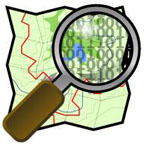
Cartographic Resistance
OpenStreetMap (OSM) is a project aimed squarely at providing free geographic data such as street maps to anyone who wants them. This is because most maps you might think of as free actually have legal or technical restrictions on their use, holding back people from all walks of life who would like to use a map for one reason or another.
OpenStreetMap is (or is almost) a free editable map of the whole world. It is still being written. OpenStreetMap allows you to view, edit and use geographical data in a collaborative way from anywhere on Earth. It comes in three major flavours: 1. Viewer--allows you to browse a map like any other; 2. Applet Editor--allows you to enter new data in your browser. Streets, points and areas can be entered and given metadata like names and whether cars or bikes can travel on them. You can upload GPS traces you've made and also edit the types of data you associate with the geographical data. You have to log in for this, so that the server can keep track of things; and 3. Home editor--this is for more advanced users who want more flexibility and prefer a dedicated application for editing data. [via]
Posted by jo at 09:23 AM | Comments (0)
Second International Conference

Digital Technologies and Performance Arts
School of Intermedia and Performance Arts Second International Conference for Digital Technologies and Performance Arts, Doncaster, UK, June 26, 27, 28, 2006; Call for Papers, Workshops, Performances
www.don.ac.uk/ipa/frameset/index2.html.
Following the success of the 1st International Conference for Digital Technologies and Performance Arts, the School of Intermedia and Performance Arts at Doncaster College announces DTPA 2006. This interdisciplinary conference provides a forum for those in the field of theatre, dance, music and performance (researchers, practitioners, educators, systems developers) for a dynamic and exciting exchange of approaches surrounding the use of new media technologies in live performance.
Proposals are invited for papers, performances, presentations/workshops, and poster presentations on the following topics:
• Live performance and interactive systems
• Motion capture/motion-sensing technologies
• Performance pedagogy, education and new media
• HCI and live performance
• Web based performance and virtual performance spaces
• Realtime music control
• Gesture and interactive multimedia
• Interdisciplinarity and new media
• Performance software/hardware development
Apart from papers in conventional format (30 minutes) there will be the opportunity for practitioner-researchers to offer
i) performances with corresponding documentation for post-production peer discussion,
ii) performance workshops
iii) digital technologies workshops
iv) performative installations with related paper (all 60 minutes).
Presenters may also wish to submit written papers for publication prior to, or following the conference, in the new International Journal of Digital Media and Performance Arts.
Proposals for research papers should be about 200-300 words.
Proposals for performances and installations should be submitted with an outline of about 200-300 words and either audio CD or DVD, as well as full details of technical and spatial requirements.
Workshop proposals should also be about 200-300 words with additional full details of technical and spatial requirements.
Notification of acceptance of papers will be sent out by the end of March 2006.
Performing arts companies and independent artists may have conference fees waived, but will be responsible for their own travel and accommodation fees.
Contact: School of Intermedia & Performance Arts, Doncaster College
Dr Dave Collins, Reader
High Melton
DN5 7SZ Doncaster, UK
david.collins[at]don.ac.uk
www.don.ac.uk/ipa
Posted by jo at 08:48 AM | Comments (0)
With Hidden Numbers
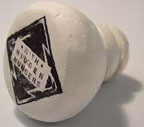
RFID Audio Mixer
With Hidden Numbers, by Meghan Trainor, uses embedded RFID tags to trigger an audio database and illustrate a technology that promises to become more prevalent in the coming years.
Dozens of handmade objects created with plaster, rubber and other traditional sculpting materials, each contain a unique number broadcast with a passive RFID tag. In addition the artist herself had a RFID tag embedded in her arm.
The system allows the audience to handle and scan the objects to activate audio triggers. Depending on the objects selected the result can be like a physical audio mixer, sometimes like a physical database query. The artist could trigger events with the tag in her arm as well, even when physically separated from the installation.
From the article The Accidental DJ in the WW Daily:
"When Trenor holds one of the objects near a scanner, it triggers a recording of an authoritative male voice reading numbers. When she waves the scanner over her arm, it plays "Hey Mamy, you sexy, you beautiful" from the rap song by Fannypack. Soon, she's holding two objects at once, dancing and interweaving samples of sound like a DJ scratching on vinyl."
The title references Marcel Duchamps’ 1916 sculpture With Hidden Noise which examined the concept of mass-production and was inserted with a noise making object unknown to Duchamp.
See also her Junkie's Little Helper. [blogge by Regine on we-make-money-not]
Posted by jo at 08:30 AM | Comments (0)
September 29, 2005
RADICAL CARTOGRAPHY
"If we were able to take as the finest allegory of simulation the Borges tale where the cartographers of the Empire draw up a map so detailed that it ends up exactly covering the territory (but where the decline of the Empire sees this map become frayed and finally ruined, a few shreds still discernible in the deserts--the metaphysical beauty of this ruined abstraction, bearing witness to an Imperial pride and rotting like a carcass, returning to the substance of the soil, rather as an aging double ends up being confused with the real thing)--then this fable has come full circle for us, and now has nothing but the discrete charm of second-order simulacra.
Abstraction today is no longer that of the map, the double, the mirror or the concept. Simulation is no longer that of a territory, a referential being or substance. It is the generation of models of a real without origin or reality: a hyperreal. The territory no longer precedes the map, nor survives it. Henceforth, it is the map that precedes the territory--PRECESSION OF SIMULACRA--it is the map that engenders the territory and if we were to revive the fable today, it would be the territory whose shreds are slowly rotting across the map. It is the real, and not the map, whose vestiges subsist here and there, in the deserts which are no longer those of the Empire but our own: The desert of the real itself."
Jean Baudrillard, "The Precession of Simulacra" [about RADICAL CARTOGRAPHY via]
Posted by jo at 12:02 PM | Comments (0)
empyre
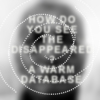
translation and minding the gaps
"...The most basic of which is this puzzlingly persistent notion that the net itself is a borderless state, a kind of endless public domain, open to intervention from anyone, anytime, any place. I think it's important to think through the ways in which this utopian ideal is in fact less than true: the net is amorphous but it's not limitless. Forgive me if all of this is extremely obvious.
First: how many web programming languages exist that are not based in the English language? Almost every web page out there, no matter what its surface linguistics (or how dynamic they may be in the service of hyperconsumerism), has an understructure with some percentage of English through which it must pass before entering machine translation and passing its packets to the network. Its programmer has had to learn some percentage of English in order to master the technical skills to communicate through the network.
It's no accident that in Lebanon, for example, a once rabidly Francophile and Francophone country has become almost totally Anglophone (and bi- instead of tri-lingual) in one generation - the IM generation.
Second, as we all probably know from our own experiences, as online communities grow and build up histories, they develop their own border policies and politics of exclusion. It's not just the governmental and corporate web that's under watch, but also each little group building fences and policing itself.
Third, cash limits access to domains, domain names, server space, and so on for web producers, just as it limits access to computers, training, high-speed service, good cable and phone lines, and so on for web consumers. People without economic resources can contribute to communities or collective projects like wikis or folksonomies, but may not be able to work as individuals.
I bring all this up not to be depressing and cynical, but to suggest that perhaps the most productive way to bring the idea of site-specific or community-based practice online is to engage with the places, communities and histories of the net itself - or to make a deliberate effort to discover the gaps in the network - the sites of absence, where voices are missing or elided, or the online border zones, places of transition, translation and in-between, parallel to sites like San Diego/Tijuana - and use those spaces to launch mediations between on and offline practice."--Mariam Ghani [read entire post >>; read entire September archive >>]
Posted by jo at 11:41 AM | Comments (0)
[UpStage]
![]()
Next UpStage Walk-thru, October 7
Kia ora koutou: this is a reminder about the monthly UpStage walkthru's [the next one is next week!]--Wed 5 October: California, USA: 2pm; New York, USA: 5pm; UK: 10pm; Western Europe: 11pm; Finland: 12 midnight; Australia (NSW/QLD): 7am [thurs]; NZ: 10am [thurs]; or check -http://www.timeanddate.com [for your local time].
The format will be newbies in the introduction stage [over view of the tools and tricks in the UpStage performative space]. While other crew will be devising with members of Avatar body Collision [please come to the introduction stage first for directions :)]; To take your place as a player please email colliders[at]avatarbodycollision.org for a login and password. Audience members please proceed to http://upstage.org.nz:8081/stages/presentation.
Posted by jo at 10:05 AM | Comments (0)
Interface [s] Montréal
![]()
[Immersion and Virtual Reality]
[Immersion and Virtual Reality] Beyond reality and interactive reality experience--From aerospace to surgery, and in all things game related, the simulators and immersion environments developed to serve humankind are indispensable tools that significantly improve human knowledge and enhance our reality experience.
Speakers: Yves Gonthier - Canadian Space Agency; Jean-Claude Artonne - Immervision; Jocelyn Faubert - Université de Montréal, École d’optométrie; Carl-Éric Aubin - École Polytechnique de Montréal, Dép. génie mécanique & CHU Sainte-Justine; Luc Courchesne - Université de Montréal et Ideaction.
TUESDAY, 4th October 2005 Interface [s] Montréal :: [Immersion and Virtual Reality]; 5:30pm - $30 at the door - package deals available.
[Yves Gonthier] Canadian Space Agency: A Real-Time Simulator for 3D Mental Image Reconstruction On-Board the International Space Station--The operations of manned and unmanned space vehicles and their associated supporting docking and robotics systems require significant crew training both on ground and on orbit. A number of psychological and physiological factors are known to affect the crew on-board performance. Therefore, skills degrade over time and the frequency, depth of proficiency and refresher training need to be studied. Currently a new experiment is designed in order to study the 3D mental image reconstruction for tasks involving the operation of all robotic components of the Mobile Servicing System of the International Space Station. The long-term goal of this research project is to gather data to study skill degradation and recovery of psychomotor and cognitive skills. This data will be analyzed to help define metrics that could be used to assess the level of readiness of an operator to perform complex tasks.
To study performance degradation and skill recovery, a highly efficient simulator is required in order to ensure on-orbit real time simulation and fast feedback to the operator. In this project, the challenge is the real-time simulation of Canadarm2 and Dextre while performing graphics rendering of the worksite environment using just a single computer, in particular a P4 1.8Ghz IBM ThinkPad. The simulator relies on the modeling technology from SGDL to generate highly realistic images. For the graphics rendering of the models, the SGDL models are transformed into an approximate polygonal representation. This minimizes the computational load on the CPU and optimizes the rendering rate by using graphics card hardware acceleration. At the same time, a collision detection algorithm is applied to the exact SGDL model to monitor any collision event.
It is planned that the experiment will be launched on the space station in April 2006.
[Jean-Claude Artonne] Immervision: Panoramic technologies in everyday applications--During the last ten years computer and optical sciences have evolved to open possibilities and create opportunities for new applications. Thanks to these technological advances today we can experience a new “Immersive” dimension.
With today’s panoramic imaging technologies we can digitalise and visualise in real-time a whole 360 degrees environment. Hosting a panoramic videoconference from your mobile phone, keeping an eye on every room of your house, preventing transportation accidents thanks to 360 degrees dynamic analysis, caring for your loved ones from distance and virtually immerging yourself inside the human body will soon all be panoramic imaging technology’s applications as common as today’s ultrasound, radar, telephone and many other technologies developed during the past 50 years.
A new 360 degrees technology invented and patented by Jean-Claude Artonne and developed by ImmerVision meet the quality, flexibility and performance required by today’s rich multimedia applications and most rigorous security and aerospace applications. It is a combination of both hardware and software that run on today’s video camera and computer technology from the smallest pocket PC to the most powerful system. The hardware includes the new panomorph lenses with increasable resolution on specific areas combined with software based on advance imaging algorithms.
[Jocelyn Faubert] Université de Montréal, département optométrique, Chair NSERC-Essilor on presbytia and visual perception: Understanding human behavior with immersive virtual environments--Full-immersive displays such as the CAVE system have been originally developed for visualization and industrial uses. Using such an environment for the study of human performance involves a number of challenges, as it was not originally designed for such a purpose. For several years now our laboratory has adapted the CAVE technology to help us understand human behavior. We are interested in determining the effect of age-related changes on perception, posture and visual-motor control in ecological environments. In particular, we try to understand how prebyopes cope with visual deformations that are induced by corrective lenses. Presbyopia is an age-related change that affects our capacity to focus at near. The first signs usually appear in the 40s and almost 100% of individuals in the 50s are presbyopic. Our initial results are extremely promising and demonstrate that a full-immersive environment is a very powerful tool for assessing human performance but this is a technology that still requires enormous resources in both initial cost and maintenance and may not be generally accessible in the near future.
[Carl-Éric Aubin] École Polytechnique de Montréal, Dép. génie mécanique & CHU Sainte-Justine: Surgical Simulator for the Virtual Prototyping of the Surgical Instrumentation of the Scoliotic Spine--Prof. Carl-Eric Aubin Ph.D., ing.; Ecole Polytechnique de Montréal, département génie mécanique & CHU Sainte-Justine; Collaborateurs : Profs. H. Labelle, B. Ozell, F. Cheriet.
[Luc Courchesne] Université de Montréal and Ideaction: Panoscope 360°--Enter the Panoscope 360° to be fully immersed in a 3D world. A 3-axis joystick placed at the center of the viewing platform will let you and your friends (up to 8) fly through the space as in dreams. This single channel immersive display uses a PC and a custom designed hemispheric projector above your head to project in real time a rendering of your entire horizon onto the hemispheric screen."
Posted by jo at 09:47 AM | Comments (0)
Interactive Performance
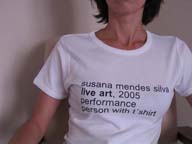
T-shirts as Software
Susana Mendes Silva keeps creating interactive performances and by (in) doing so continues to investigate the nature of social relations. After Artphone and art_room, two performances in which the spectator (user, to be more accurate) had to interact with the device created by the artist, a technologically mediated question-answer situation about contemporary art, Silva developed Live Art.
The assumptions are the same. Even the name of this new performance reminds us of the previous ones and how much she enjoys questioning the boundaries of traditional art, or at least of a commodified, object driven art. In this project there is again a device the artist created, but not a digital one, or at least not one at first sight. It is a t-shirt with information concerning the performance. The information, the technical details of the work of art, functions as the instructions manual for the performance, defining how it is supposed to work.
The user, he or she who buys the t-shirt, will have to perform a determined action, wear it (or not), thus making the device work, interact with it. This performance consists in a set of rules materially formalized in an inexplicit manner in a t-shirt, . The course of action is unpredictable and is completely out of the artist’s control. Once again, through such a procedure, Silva questions how spectator and contemporary art interact, playing with concepts as artistic phenomenon or authorship.
A t-shirt, a simple, implicit set of rules. An open, modifiable, autonomous device. If we look at the user’s role as secondary, if we look at the device, and how it works and changes, the concept of generative art isn’t that far away. Thinking of it as “any kind of artistic practice in which the artist uses a system and makes it function with a certain degree of autonomy in order to create complete work of art”. Live art is put in motion and the outcome is unpredictable (as was art_room’s) being the result of chance and the limitations of the set of rules defined.
But how accurate, how realistic is comparing the human system here described with the procedures of autonomous systems responsible for generative art? What of meaning? Part of this system is made of a user to whom this whole situation in which he sees himself has a meaning and that guides his action. Not only is he influenced by what is written on the t-shirt, but also by his interpretation of the event and that has to be accounted for.
There is usefulness in another comparison. If the focus in the spectator-user’s expectations and in his reaction to the piece, in how the action unfolds and meaning is created from the interaction with the set of rules defining the performance, if the focus is in the procedures rather than in the outcome, we are clearly facing what can be called software art. Even though not recurring to digital tools or the like, Silva is, ideologically, walking through digital art’s grounds, for she is exploring communication procedures, processes over objects, relations over subjects. She is doing analogically immaterial works of art and her tools are concepts such as interactivity, software or self-organization.
Susana Mendes Silva
live art, 2005
performance
person with t-shirt
for the exhibition
private t'shirt
30.09 to 27.10
a loja do lopes
lisbon
Read An Artist in the Chatroom, a text discussing Silva's performance art_room
Posted by luis at 09:24 AM | Comments (0)
Electrode Cap
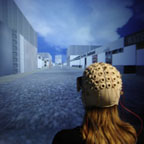
Computer Users Move Themselves with the Mind
"Computer scientists have created a hat that can read your thoughts. It allows you to stroll down a virtual street. All you have to do is think about walking.
Called a brain-computer interface, the device detects activity in certain brain areas linked to movement, and uses the signals to mimic that movement in a virtual world. The technology could one day help paralysed patients to move robotic arms, or help sufferers of motor neuron disease to type out words on a virtual keyboard.
"Just thinking about movement activates the same neurons as actually moving," explains Gert Pfurtscheller of Graz University of Technology in Austria, who has been working on the device for around four years. By picking up on these bursts of nerve activity, the computer can decide whether you are thinking about moving your hands or feet, and react accordingly..." From Computer users move themselves with the mind by Michael Hopkin, nature.com, 27 September 2005.
Posted by jo at 09:05 AM | Comments (0)
Free Radio SAIC
![]()
Special Broadcast w/Eric Leonardson & Inge Hoonte
Friday, September 30, 1:00 PM--2:00 PM (GMT-6/US Central Time). Listen on-line to the live audio stream, QuickTime required.
This 1-hour webcast--by students of Eric Leonardson and Inge Hoonte's First Year Program Core Studio Time Group at The School of the Art Institute of Chicago--is the result of 13 individual site investigations of specific city spaces in the downtown Chicago area. All sounds and voices are produced through a month-long process of mapping, scoring, field recording, historical research, writing and improvisation. References for this project include the ideas and works of R. Murray Schafer, John Cage, Robert Smithson, John Smith, Graeme Miller, Goat Island, and Inge Hoonte.
Phone in. Studio: 312-345-3804; on-air: 312-345-3805. Past radio performances and more can heard in the Free Radio SAIC archives .
Posted by jo at 08:45 AM | Comments (0)
ResonanCity
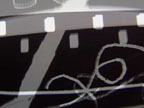
@ the Dutch Film Festival
Live performance ResonanCity by Sara Kolster and Derek Holzer, October 3, 20.00 uur; Dutch Film Festival/Re:visie, Centraal Museum [Post CM building], Utrecht NL.
Many sounds and images in our everyday lives slip past our notice simply because they are too small, or because we lack the proper receivers to pick them up. ResonanCity is an ongoing project to gather these microscopic sounds and images from various cities, and to amplify and transform them. The goal is to build a new city of sound and visuals inside the old one, and to inspire curiosity and exploration of one's own environment. Visually, Kolster's work deconstructs the analog/digital divide by presenting carefully prepared film positives in a software-manipulated environment. Similarly, Holzer's realtime digital sound treatments highlight and enhance rather than obscure and distort the field recordings and sound objects he collects. ResonanCity recently won the second prize at the WRO International Media Arts Biennale in Wroclaw, PL. See also http://www.umatic.nl [Related]
Dutch Film Festival / Re:Visie
During the Dutch Film Festival [28 sept - 7 oct] a second edition of the visual art program Re:Visie is presented. Curators Annet Dekker (Dutch Institute of Media Art, Montevideo/Time Based Arts] and Karel Doing [Film maker and co-founder of the Filmbank] put together a program in which interaction between different art disciplines is the central theme.
The performance ResonanCity is presented on the 3rd of October within the Re:visie program. Besides ResonanCity, two other performances - FACES (Joost van Veen & Huib Emmer) and OPTICAL MACHINES (Rikkert Brok & Maarten Halmans) will be presented on the evening of the 3rd.
Location: Post CS building
Re:Visie takes place in POST CM, Agnietenstraat in Utrecht. The entrance is opposite the main entrance of the Centraal Museum.
Posted by jo at 08:15 AM | Comments (0)
"EVE’s Pore" Koichi WATANABE
Pop Meets Cyborg
[Blogged by Yukihiko YOSHIDA] Koichi WATANABE, known for his unique work molding famous people's body in plaster, collaborated with dancer, Rumiko BESSHO. BESSHO’s statue as full-body-model and video art were placed in the gallery’s white space. In the video, she is completely naked. Her body seems to have an aura of a real body in spite of the image's virtuality. BESSHO appears from backwards and move slowly and dance sharply with piano sound. At the beginning, she was in the same posture as a plaster statue. The statue looks like a mold of her body.
Then she began to move little by little looking carefully her inner side. In the video art, BESSHO was naked. Her images were projected on white costume and it looked erotic. However, white statue’s existence looks real on the other side. As BESSHO turns slowly and slowly, white cloth was involved to her body little by little. Her movement is not dramatic but sharp and free. From Kazuo
OHNO to Akaji MARO, WATANABE makes famous persons’ plaster models widely. On this exhibition, WATANABE also displayed statue by plaster which took the model of “Rika-chan doll” and "Kyupi doll." It looks like pop and a bit Akiba-style. Takashi MURAKAMI’s concept, "super flat" was shocking to Art World and Japanese figure dolls got more and more popular. These dolls are more OTAKU than Rika-chan and Kewpi doll, which is also popular in Japan.
They are pop, but they are artificial like cyborgs which you can see in SAC 2nd GIGS. BESSHO’s statue is more humanistic than these figures and cyborgs. From the point of view of performance, it looks successful and I am looking forward to seeing her next step. BESSHO’s 3 types of body, statue by full-body-model by plaster, full-naked body image in the video art, and BESSHO as a real dancer, represent artificial Japanese-ness and existence in the 21st century.
Related Webpages:
Rika-chan: http://www.takaratoys.co.jp/licca_chan/
Takashi Murakami: http://www.kaikaikiki.co.jp/
SAC 2nd GIGS: http://www.kokaku-s.com/root.html
Posted by jo at 07:18 AM | Comments (0)
September 28, 2005
Zhong Shuo
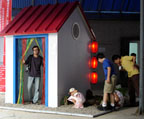
24 Hour Access to China
Zhong Shuo (People Say...) is a sound installation made collaboratively by Australian sound artist Iain Mott, Beijing visual artist Ding Jie and the Chongqing art collective the Li Chuan Group comprising Li Chuan, Li Yong and Ren Qian. The work acts as a system for the collection and telling of stories and focuses on the rapid force of change in China. The exhibition at the Long March Space in the Dashanzi district of Beijing, marks the first stage in what ultimately will be a series of installations connected to each other via the internet. It will consist of up to three individual installations set up in three cities including Beijing, Chongqing and potentially a third location on the route of the Long March.
Stage 1 was launched at the Long March Space, Dashanzi, Chaoyang District, Beijing on 20 August 2005. Stage 2 is currently underway in Chongqing with the Li Chuan Group. The exhibition is to be held in the Chongqing Planning Exhibition Gallery at Chaotianmen Square.
Each installation will pose a question to visitors, asking them to tell a story of their experience of change. In Beijing, Ding Jie's design establishes a gently ironic environment for public interaction. Created in the form of a Chinese garden, a kiosk houses a telephone for contributing stories and an adjoining rock-pool plays host to a small school of goldfish and water-plants. Hidden away in the rocks and shrubs is a loudspeaker, which plays a steady stream of stories that have been automatically recorded and edited by a computer. This sound, in addition to the voices, includes ambient sound recordings collected locally and is edited in the style of radio documentary.
Once the other installations have been established, stories will be shared between sites by way of networking. In this way, visitors will be able to reflect on varying perspectives on change. Each installation will share copies of the stories collected remotely and these will be edited together mixing both dialects and points of view. Additionally, the sounds played by the installations will be streamed to the web as internet radio, giving 24 hour access to Chinese speakers both nationally and internationally. Information on this radio channel will be announced by the Long March Space before the opening.
Posted by jo at 08:48 AM | Comments (0)
MayDay NetParade
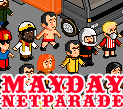
Political Videogames Against the Dictatorship of Entertainment
The MayDay NetParade--by Molleindustria--is a virtual demo that runs thru a heavily guarded and branded city put under siege by insurgent legions of brain+chain+temp workers and assorted anarchists, commies, queers and greens. The marching avatars are digital simulacra of today's exploited masses of neoliberalism: précaires, precari@s, precari, cognitarie, contingent knowledge and service workers. We are a mixed bunch, a heterogeneous multitude of precarious jobs and lives. Yet we have not spawn out of fordist assembly chains, but out of dystopian retail chains and office spaces. Why don't you give your pictorial contibution to this multicolored parade, and reclaim that visibility that mainstream media, unions, parties are denying us? Make yourself heard! Voice your anger and/or irony! You will be able to be part of a piece of collective net art. But do it fast, cos after May 1st, the NetParade will remain visible online, but it will no longer be possible to join. By clicking on JOIN, you'll be able to create your avatar, singular and (un)crazy as you want it to be. You'll have to answer a few multiple choice questions first, but these will be totally anonymous, private and dissociated from your avatar.

About Molleindustria
We can no longer consider videogaming as a marginal element of our everyday lives. In recent years, the turnover of the videogame industry has exceeded that of cinema, and there are a growing number of adult and female players. There are more frequent overlaps with other media: there are videogames for advertisements (advergames), for educational purposes and for electoral propaganda.
How did videogames become such a central element of the mediascape? During the second half of the nineties, major entertainment corporations extended their activities in this sector and extinguished or absorbed small producers. Now videogames are an integral part of the global cultural industry, and they are in a strategic position in the ongoing processes of media convergence. These developments inhibit the political and artistic emancipation of this medium: every code line is written for the profit of a big corporation.
One solution: Gamevolution! We believe that the explosive slogan that spread quickly after the Anti-WTO demostrations in Seattle, "Don't hate the media, become the media," applies to this medium. We can free videogames from the "dictatorship of entertainment", using them instead to describe pressing social needs, and to express our feelings or ideas just as we do in other forms of art. But if we want to express an alternative to dominant forms of gameplay we must rethink game genres, styles and languages. The ideology of a game resides in its rules, in its invisible mechanics, and not only in its narrative parts. That's why a global renewal of this medium will be anything but easy.
Molleindustria is an italian team of artists, designers and programmers that aims at starting a serious discussion about social and political implications of videogames. This will involve media activists, net-artists, habitual players and critics and detractors of videogames. We chose to start with online gaming in order to sidestep mainstream distribution channels and to overcome our lack of means. Using simple but sharp games we hope to give a starting point for a new generation of critical game developers and, above all, to experiment with practices that can be easily emulated and virally diffused.

Also, see //////////fur////: fighting massive-single-user-isolation, //////////fur//// develops art entertainment interfaces for multidimensional multiuser involvement: software-programs in mechatronic artefacts that create dynamic action-spaces for two or more participants. [via]
//////////fur////'s guiding idea is the alternative interface which goes beyond providing solely a visual navigation, manual control and massive single-user isolation.
Posted by jo at 08:47 AM | Comments (0)
YOKOHAMA 2005:
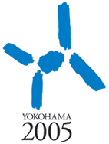
International Triennale of Contemporary Art
YOKOHAMA 2005 - Yokohama's second International Triennale of Contemporary Art - builds on the success of YOKOHAMA 2001 and will feature the work of around 80 participating international and Japanese artists exhibiting in the main venue - two enormous warehouses located on Yamashita Pier. The Triennale offers an alternative to the conventional style of art exhibition in which the observer simply looks at the works, instead offering a dialogue-based exhibition in which the barrier between the observer and the exhibitor is transcended, with the observer present during the artist creative process and being able to actually experience the work.
There will be an emphasis on “involvement with the site” in YOKOHAMA2005. This will be a new type of venue for people to encounter art realized through initiatives such as home-stays by artists and also by featuring participation-based art. The public will have the opportunity to view or be involved in the artist's creative process while much of the work will undergo change as a result of interaction with the community (works-in-progress).
Triennale plans also include movie screenings, community workshops on theater and other art-related topics, and events such as symposiums and gallery lectures to encourage interaction between art and the community. September 28 - December 18, 2005.
Posted by jo at 08:34 AM | Comments (0)
Rotosketch
Posted by jo at 08:15 AM | Comments (0)
Nabaztag

First Rabbit
Nabaztag is a newborn bunny, one of a unique species of intelligent, smart objects. I'm 23 cm tall, I wriggle my ears, I sing, I talk and my body lights up and pulsates with hundreds of colours. Thanks to Wi-Fi technology, I'm always connected to the Internet. Oh, and I'll only set you back 95 €.
Set me up in your home or office and I'll be your personal companion. I can tell you about tomorrow's weather, about traffic jams on the ring road, keep you posted about the stock market's roller coaster rides. I can tell you discreetly, just by flashing or moving my ears about. I can also do it with music or talk. Obviously, you're always in control of what news you want to hear. And there's more...
Thanks to me, your friends and family will have a totally new way of keeping in touch: through the web, text messages, their phone or email… plenty of different ways to send you messages, music, MP3 files that I'll read out to you… or sing out, or even dance. Your friends will no longer be confined to the depths of your computer or phone: they'll come alive in your home, in the noble guise of a rabbit.
But that's still not all. This only the start of a new era of smart objects, and you'll have plenty of opportunities to discover and invent new uses - as useful, futile or subtle as you choose.
Posted by jo at 08:00 AM | Comments (0)
Passages
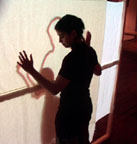
Plato's Cave
Many 'Media spaces' have taken the form of always-on video conferences between selected remote locations. However, users may still perceive a sense of separation because they see each other through wide-angle views captured by cameras mounted at a distance from them. Passages allows passers-by to "touch" the silhouettes of their remote counterparts.
A translucent surface, made of glass and textile is set in two different locations connected with each other via a network. As a passer-by walks in front of this surface, the contour of his/her silhouette is reflected in a style that evokes drawing or sketching.
This silhouette uncovers what is happening at the other location, possibly the silhouette of another person standing there. As the local participant moves, more of the remote scene is exposed.
A specially designed computer vision system enables interaction at a very short distance to the screen surface, to the point that passers-by can actually touch it. This system maintains a near-perfect registration of the participants' bodies to their silhouettes no matter how close they are to the surface. Video. By Joëlle Bitton, Céline Coutrix, Stefan Agamanolis. [blogged by Regine on we-make-money-not]
Posted by jo at 07:35 AM | Comments (0)
TRANSMISSIONS 05
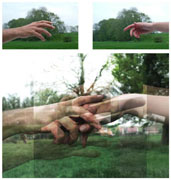
Hybridization of Practices
TRANSMISSIONS crystallizes the integration of creativity in the arts, science and technologies. Today research, experimentation and creation in new media are, by their volume, at least comparable to what could have been produced in the 1960's, with the development of mass media. The hybridization of the practices and the digital components between the scientific, technical and artistic fields invigorates inventive processes, experimentalism, interdisciplinarity or transdisciplinarity. The artists are unceasingly exploring the potential of technology for new relations with the world, new constructions of knowledge and new social spaces and means of expression. The researcher thus intersects with the artist or the mediator, in their common zest for experimentation.
TRANSMISSIONS will present, in their authors' presence, the works and the devices that are the results of research in progress, thereby encouraging exchange and dialogue between the public and the authors as a creative approach to technology.
Given the multiplicity of image formats and an increasing complexity of our relationships with them, TRANSMISSIONS traverses the non exclusive axes that deal with the common concerns of the artistic, scientific and heritage fields:
Screen/Surface: the willingness to leave the image on the computer standard screen, to invest other materials and supports (as in Electronic Shadows presentation, at ICHIM 04);
Sonic experiments: the wealth and diversity of experimentations with sound;
Body-as-Interface: supplanting technical interfaces in favor of a more intuitive interaction between the body and the device;
Hybrid reality (Global Positioning System and Augmented Reality): physical and digital space fusion, experiencing space;
Archiving and indexing: Constituting, locating and hijacking network content;
Time-space laboratory: New articulations in time and space.
Back to the future: Experiments in Art and Technology: rediscovering the pioneering role of E.A.T. in the domain of research at the intersections of art, science and technology.
Adrien de Melo, Christophe Leclercq, Xavier Perrot.
Horaires
The Exhibition opens on the afternoons of 22 & 23 September at the Maison internationale, RER Cité internationale universitaire de Paris (14e).
Thursday September 22, 2005
Exhibition opening: 4.30PM.
Official inauguration: 6.00PM.
Exhibition closing: 10.00PM.
Friday September 23, 2005
Exhibition opening: 2.00PM.
Exhibition closing: 8.30PM.
Free entrance upon invitation.
Contact and reservations : transmissions@ichim.org
Posted by jo at 07:08 AM | Comments (0)
aperture

Facades as Autonomous Skins
aperture--by UDK--is a facade installation with interactive and narrative display modes. Composed of single aperture-modules with receptor and actuator, aperture acts like an autonomous skin, capable of precise external control. Visual information is transmitted from the inside of the building to the outside, the surface permeability is regulated when the aperture‘s opening diameters are changed.
Each single aperture and all the apertures as entity "see" what happens on the inside of the facade and react accordingly: like the human eye‘s iris and the iris diaphragm of the objective, they react to light, widening and contracting according to the intensity of incoming light. If no human activity is to be distinguished on the inside, a "memory" mode recalls images and abstract animations captured throughout the day and displays them.
People standing in front of the wall are exposed to the aperture grid. The duration of the image fading out, as the apertures close, is itself a reflection of how long a person has been standing in front of aperture. Video of the working prototype. A project by Frédéric Eyl and Gunnar Green who are looking for sponsors to further develop the project. [blogged by Regine on we-make-money-not]
Posted by jo at 07:00 AM | Comments (0)
Fursicle Safurry

Telecommunications Wilderness
Fursicle Safurry invites people to enter a space of make-belief adventure through the wilderness of telecommunications. Upon calling the fursicle with their cell phones, users will receive a password composed of animal sounds such as gerrrs, wooww, barks, cries, and meaows. They then have to go to the head that is outside the installation. Staying on the phone they tell the password to the head which responds by sending a sound feedback and a blue light. If the head likes the password, the user gets to enter.
The voice on the phone asks users if they want to MATE, KILL, or RUN with the fursicle. According to their choice, users will be guided by instructions from the voice on the phone: they will have to touch and move in various ways with the fursicle, inventing the feedback as they move. While the user is interacting with the fursicle corresponding sounds and projected images are texturing the experience with rich animal sights and languages. By Dana Karwas and Liubo Borissov. [blogged by Regine on we-make-money-not]
Posted by jo at 06:49 AM | Comments (0)
September 27, 2005
ANTIPODE/2
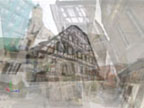
The Anti-Map
ANTIPODE/2 interweaves photography and cartographic process to reconstruct in virtual space the landscape of two cities juxtaposed within one another. This mapping process captures not only the structural pattern of the cities, but the events occurring at moments in time, progressing along the path taken by the photographer. This operates as an antithesis to the traditional cursory representation of maps. It occurs at the street level, recorded visually as seen by the eye of the observer and then viewed from the originating perspective; witnessing the flow of pedestrians and traffic, commerce and cultural activity. It is an "anti-map"...
ANTIPODE/2 was part of Segue/Überlappen, a collaborative exchange project between faculty and students of UMBC, Baltimore Maryland, USA, and Fachhochschule Schwabisch Hall, Germany, June 5-19, 2005.
Posted by jo at 03:06 PM | Comments (0)
The Singularity is Near
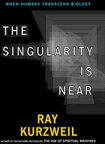
Merged with Our Technology
"Ultimately, we will merge with our technology. This will begin with nanobots in our bodies and brains. The nanobots will keep us healthy, provide full-immersion virtual reality from within the nervous system, provide direct brain-to-brain communication over the internet and greatly expand human intelligence. But keep in mind that non-biological intelligence is doubling in capability each year, whereas our biological intelligence is essentially fixed. As we get to the 2030s, the non-biological portion of our intelligence will predominate. By the mid 2040s, the non-biological portion of our intelligence will be billions of times more capable than the biological portion. Non-biological intelligence will have access to its own design and will be able to improve itself in an increasingly rapid redesign cycle." From Human life: The Next Generation by Ray Kurzweil, New Scientist (subscription required). See The Singularity is Near. [via smartmobs]
Posted by jo at 02:15 PM | Comments (0)
Balance Seat
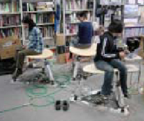
Networked Equilibrium Sharing System
"ABSTRACT: This paper presents a networked system connecting real space, which is shared and operated by three people. We made three pneumatic triple-axis motion platforms as a system to share a “sense of balance” with other people, and examined control methods for this system. Cylinders, which go up and down due to air pressure are used as actuators, and by moving the cylinders up and down while performing position control, the system can make the platform tilt. We considered whether it was possible to represent bodily sensations as symbols when shifting shared work performed in virtual space to real space. For our sensual symbol we chose the sense of balance, being a sense that is common to everyone. We constructed a system enabling users to share the sense of “balance”." From Networked Equilibrium Sharing System "Balance Seat" by Nobuya Suzuki, Takahiro Kobayashi and Hiroshi Yasuda.
Posted by jo at 02:04 PM | Comments (0)
Digital Peacock Tails
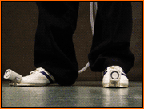
Designing Post-Optimal Electronic Attire
Although digital technology is becoming increasingly personal and intimate, electronic artefacts and systems are often conceived of as tools, designed to support goal-oriented tasks and activities as efficiently as possible. The Digital Peacock Tails project looks beyond this narrow point of view and employs digital technologies not only as efficient tools but also as beautifully challenging plumages.
The Siren Shoes make a loud noise when both feet are on the ground at the same time. The wearer faces the dilemma of either altering her gait or becoming a shrieking public nuisance.
The Miscalculator is a software application that produces a result close to the truth but not always. When installed, the Miscalculator permanently removes and replaces the standard Windows calculator. Conceived as digital tattoo, it probes electronic expressions based on permanence and sacrifice of control.
The SMS Headband allows people to send text messages to the wearer's forehead. It explores social and psychological costs and the loss of control (of the expression of a prominent part of the body canvas.)
The Backstabber replays fragments of conversations recorded several hours ago. The wearer turns into a spy, a leakage between different times, and a security breach, but also a source of interesting secrets. How does it feel to wear other people's secrets as personal adornments, and how does it affect the interaction with others? Read more >> [PDF]
Posted by jo at 12:49 PM | Comments (0)
Physical Metadata
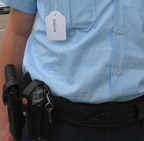
tag, tagged, taggers, tagees
"Classifying objects is no longer a responsibility for a torturous team of meticulous librarians. On the internet, users freely classify each others websites, images and texts by adding tags, which other users can browse and use to find things.
Users can tag URLs (on del.icio.us), photographs (on flickr.com) soundsamples (freesound project) and undoubtedly a myriad of other online objects. Online this creates a open structure of information about information otherwise known as metadata, but what happens offline? How can things in the real world be democratically defined?
The Physical Metadata project attempted introducing tagging into the real world. 55 words were printed on cards (tags, really) and could be attached to real objects in the physical world. More examples of what happened can be seen on http://www.flickr.com/photos/tags/physicalmetadata." [by Nadya Peek, Mediamatic]
Posted by jo at 12:23 PM | Comments (0)
Lineage II
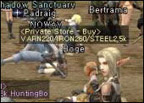
Computer Characters Mugged in Virtual Crime Spree
"A man has been arrested in Japan on suspicion of carrying out a virtual mugging spree by using software "bots" to beat up and rob characters in the online computer game Lineage II. The stolen virtual possessions were then exchanged for real cash.
The Chinese exchange student was arrested by police in Kagawa prefecture, southern Japan, the Mainichi Daily News reports.
Several players had their characters beaten and robbed of valuable virtual objects, which could have included the Earring of Wisdom or the Shield of Nightmare. The items were then fenced through a Japanese auction website, according to NCsoft, which makes Lineage II. The assailant was a character controlled by a software bot, rather than a human player, making it unbeatable.
Ren Reynolds, a UK-based computer games consultant and an editor of the gaming research site Terra Nova, says the case highlights the problem of bots in virtual worlds.
Arms race
By performing tasks within a game repetitively or very quickly, bots can easily outplay human-controlled characters, giving unscrupulous players an unfair advantage. Many games firms employ countermeasures to detect this bot activity. For example, they can ask the character questions or present them with an unfamiliar situation and monitor their response.
"There's an ongoing war between people who make bots and games companies," he told New Scientist. "And making real money out of virtual worlds is getting bigger."
Furthermore, the line between virtual and real cash has already disappeared. The game EverQuest, for example, lets players buy and sell virtual items and characters for real money through an authorised online trading site.
Money breeds crime
Reynolds says the growing number of online game players will only increase the incentive for scammers. "There's nothing exceptional about the virtual world," he says. "Wherever there is that sort of money, there's always crime too."
Bruce Schneier, a renowned computer security expert, adds that the distinction between virtual and real crime is rapidly disappearing. He points to recent reports of crooks trying to hack into games or steal players account information to make cash.
"I regularly say that every form of theft and fraud in the real world will eventually be duplicated in cyberspace," Schneier wrote on his weblog. "Perhaps every method of stealing real money will eventually be used to steal imaginary money, too."
There are also reports that some online scammers are using “sweatshops” in countries such as China and Indonesia in which people monitor teams of bots in order to generate money whilst avoiding bot traps."
Will Knight, NewScientist.com [via]
Posted by jo at 12:05 PM | Comments (0)
Mediamatic Interactive Film Lab @ Budapest

Call for Applications
Mediamatic Interactive Film Lab @ Budapest 3 | 4 | 5 | 6 | 7 | final presentation 8 October 2005: In this workshop 16 makers, producers editors and educators of film, radio, television and video use their own material to make an interactive film that can be published on or offline. The workshop is an intense process where you get to know the possibilities and applications of interactive film in a wider media context. You design your own project and discuss it with peers and experienced trainers and build a working prototype.
Application Deadline: September 30, 2005 | online registration >> | workshop schedule (pdf, 219K) and more info >>
Posted by jo at 10:52 AM | Comments (0)
1001 nights cast
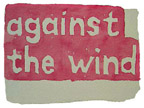
Tune In
As of tomorrow, I'll be into the three digit figures of the 1001 nights cast and also crossing quite a few time zones on my way back to Sydney. Here's some information about the next few performances if you want to keep track of performance times:
# 99 from PARIS on Sept 27 at 19:38 local time
# 100 from Changi Airport, SINGAPORE on Sept 28 at 18:59 local time
# 101 from Changi Airport, SINGAPORE on Sept 29 at 18:58 local time
# 102 from SYDNEY on Sept 30 at 17:57 local time
From then on, sunsets in Sydney will get later and later and on October 30 SOME of Australia, including Sydney, switches to daylight saving. On that day sunset in Sydney will be at 19:21. This is also the date on which much of the northern hemisphere reverts from summer time to standard time.
Please use the time zone converter to calculate your local time in relation to mine on any given day.
Since performance # 50 some great new writers have contributed to the project. The current full list of writers is:
Oskar Backent (just turned 7)
Lionel Bawden
Anne Brennan
Lucy Broome
Barbara Campbell
Deb Cox
Mira Cuturilo
Domenico De Clario
Jai McHenry Derra
Craig Doolan
Nola Farman
David Hagger
David Hansen
Helen Idle
Seth Keen
Alex Keller
Boris Kelly
Declan Kelly
Caroline Lee
Eden Liddelow
Rivka Mayer
Deborah McBride
Robyn McKenzie
Sarah Miller
Ninna Millikin
Ross Murray
John O'Brien
Marian Pastor Roces
Dee Prichard
Greg Pryor
Joseph Rabie
Ian Reilly
Andrew Renton
Neil Roberts
Danielle Roddick
Jade Shum
Ann Stephen
Rob Stephenson
Miriam Taylor
Philip Terry
Paul Threlfall
Helen Townsend
Sophie Townsend
Margaret Trail
Cynthia Troup
Patsy Vizents
Van Waffle
Frazer Ward
Ingrid Wassenaar
Marion White
Diana Wood Conroy
Amelia Young
Ellen Zweig
I cannot thank them enough for the quality and generosity of their writing. Always a pleasure to perform.
Barbara Campbell
http://1001.net.au
Posted by jo at 10:43 AM | Comments (0)
New on AudioHyperspace
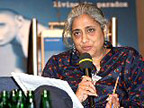
Involvement and Participation
"At this year's Ars Electronica/Linz the exhibition Tana-Bana was the huge surprise. It showed media art works created by students of the Srishti School of Art, Design and Technology in Bangalore, India. "Tana-Bana" can be translated literally as "warp and weft" and is meant to evoke the ideal of the "integration of communities or societies". Its maybe most impressive work was "Russell TV", which was shown in the exhibition as an audiovisual documentary. It was a temporary TV station created especially for the huge downtown Russell Market. Viewers were involved in the production from the beginning. The TV-station was distributed within the huge market by cable, and by screens at the venue's entrance and in shopkeepers' stalls, it could be watched by the passers-by and the clients. "Tana-Bana" was curated by Geetha Narayanan, who is one of the founders and the director of Shrishti." From Involvement and Participation: Geetha Narayanan in Conversation with Sabine Breitsameter.
Posted by jo at 10:34 AM | Comments (0)
Low Tech Sensors and Actuators
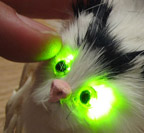
A Low-Tech Conceptual Framework for Complex Interactive Systems
Low Tech Sensors and Actuators is a collaboration between Haque Design + Research and Aether Architecture.
Commissioned by the Foundation for Art and Creative Technology (FACT), we developed a suite of low-tech sensors and actuators using electronic children's toys and gadgets that can be hacked for their constituent parts. In this way, artists and architects can quickly and cheaply develop interactive spaces and objects. The outcome of the project was an instruction manual of sorts, a manifesto for low-tech, a conceptual framework for complex interactive systems. IR toys as proximity sensors, cats as interfaces, torches as power sources, walkie talkies as wireless networks. Have a look at our report [PDF ]
Posted by jo at 10:23 AM | Comments (0)
European Media Artists in Residence Exchange (EMARE)

Belief Systems and their Medial Marketing Strategies
For 2005 Europe based Media Artists in the fields of digital media including internet and computer based art, filmmakers, sound and video artists are invited to apply for a two month residence based stipend at Werkleitz Gesellschaft's Center for Media Arts Saxony-Anhalt, Germany. EMARE includes a grant of 2.000 Euro, free accomodation, 250 Euro travel expenses, access to the technical facilities and media labs and a professional presentation.
The formless application should include a CV, (audio)visual references, projects documentation (no originals, no return!) and a proposal sketch for the project referring to the theme: "Belief systems and their medial marketing strategies" which should be developed within EMARE. Artists with residence in EU or identity card for EU and associated countries are elligible to apply. Deadline: November, 1st, 2005
Please send your application to: Werkleitz Gesellschaft e.V. € EMARE € z. H. Frau Monika Stösser
Schleifweg 6€ D-06114 Halle (Saale)
Tel: 0345-68246 - 0 € Fax 0345-68246 - 29
E-Mail: info@werkleitz.de
http://www.werkleitz.de/projekte/emare/index_e.html
EMARE 2006 will take place in partnership with VIVID, Birmingham, UK. The call for applications will follow in spring 2006.
EMARE is supported by the Ministry of cultural affairs Saxony-Anhalt and British Council.
Werkleitz Gesellschaft e.V.
Schleifweg 6
D-06114 Halle / Saale
fon: 0345 68246-0 fax: 0345 68246-29
http://www.werkleitz.de
Posted by jo at 10:12 AM | Comments (0)
SEDIMENTAL JOURNEY!
10/3 - 7:30PM PDT (10:30PM EDT) Songlines Series, Mills College - Pauline Oliveros with Stuart Dempster perform a SEDIMENTAL JOURNEY! via iCHATav with Pauline in Troy in the iEAR Studio at RPI and Stuart in Seattle at the DX Center, U Washington and the duo appearing on screen in the concert hall on the Songlines Series at Mills College Oakland CA.
This concert is commemorating 50 years of musical friendship between Pauline & Stuart. Other collaborators include June Watanabe-choreography, Scot Gresham-Lancaster-video and networking design, Les Stuck-technical direction. Possibly the concert will be streamed onto the INTERNET as well. Otherwise attendance will be in three places: Oakland, Troy and Seattle. Contact: John Bischoff bischoff[at]mills.edu Songlines Series, "J. Pampin" pampin[at]u.washington.edu-Center for Digital Arts and Experimental Media (DXARTS), University of Washington, Seattle, Pauline Oliveros paulineo[at]deeplistening.org, Arts Department Rensselaer Polytechnic Institute.
Scot Gresham-Lancaster: http://o-art.org/Scot
podcast: http://feeds.feedburner.com/OrchestrateClangMass
blog: http://clangmass.blogspot.com/
Posted by jo at 09:55 AM | Comments (0)
Pixilerations v.2
![pix.v2_tile.[ill.cs].gif](http://www.turbulence.org/blog/images/pix.v2_tile.[ill.cs].gif)
FirstWorksProv Festival
Providence will be the site of Pixilerations v.2, the annual downcity exhibition of new media art, ranging from digital installations and experimental video to robotic sculpture and interactive music performances. This exhibition showcases an eclectic range of artists associated with the Rhode Island School of Design (RISD) and Brown University as well as Rhode Island’s thriving creative communities.
Pixilerations v.2 opens for art lovers, technocrats and families alike to enjoy on September 29, 5-8pm and runs through October 15, 2005 at both the Space at Alice on 186 Union St, and the Pixilerations Gallery on 191 Westminster St. This opening exhibition kicks off the FirstWorksProv Festival (September 29-November 4) featuring electronic arts, premiere performances, multimedia spectacles and world-class artists including Laurie Anderson, Rennie Harris Puremovement, Momix and Rhode Island’s innovative music ensemble Aurea.
OPENING NIGHT: September 29 – Cutting-edge digital installations and festivities with Timinandi West African Music and lighted costumes by Pink Inc. animated by Fusionworks Dance Company. 5-8 pm @ The Space at Alice and the Pixilerations Gallery. Free admission.
GALLERY PERFORMANCES: September 29 & October 8 – Interactive digital performances and music. 9/29 at 8 pm and 10/8 at 10pm @ the Pixilerations Gallery. Free admission.
ONGOING EXHIBITION: September 29 – October 15 – Digital installations, experimental video and sound. Gallery hours: Thursday through Saturday, 4-7 pm @ The Space at Alice and the Pixilerations Gallery. Free admission.
Pixilerations v.2 presents Betsy Connors’ holographic Light Garden; Mark Swarek’s Fall of the Damned with interactive projections across 18’ screens; Daniel Peltz’ Tonight I sleep in a strange bed, utilizing a live-feed video system; Brian Alves’ Manual for Clinical Mycology and Mark Domino’s Glas. There will also be digital installations by Paul Badger, Brenda Jean Grell, Michelle Higa, Naomi Kaly, Inmi Lee, Robin Mandel, Hye Yeon Nam, and Filip Olszewski. Single-channel video pieces will be featured in both locations by artists Luke Fischbeck, Edrex Fontanilla, Robert Kieronski, Roger Mayer, Dennis Miller, Ben Russell, Arvid Tomayko-Peters and Lisa Young. Evil.1 by Tony Cokes is a selective chronology describing 20 explosions of the U.S. invasion of Iraq, while Epiphany by Bill Seaman is a poetic video integrating sound and text. Boston artist Dennis Miller brings Cross Contours, an investigation of nearly identifiable icons and images, from which numerous associations among them develop.
Two gallery performance evenings, September 29 at 8pm and October 8 at 10pm, at the Pixilerations Gallery, 151 Westminster Street will feature Envyloop’s bleak Texas thing, a collaboration between Butch Rovan, co-director of Brown’s Multimedia & Experimental Music Experiments (MEME) program, and renowned Berlin-based cellist, Ulrich Maiss; Laura Colella and Alec Redfearn’s video and live music performance; Rovan’s Collide, a gestural glove controller with video; and Jamie Jewett’s video/dance performance Snowblind. Performance programs also include works by Damon Baker, Mark Domino, Shawn Greenlee, Lori Hepner, Kevin Patton, Arvid Tomayko-Peters and Matthew Warne.
A listening environment for audio pieces has been created at the Pixilerations Gallery for audiences to experience radiophonic and acousmatic works by Jenny Arsonow, Damon Baker, Leah Beeferman, Jessy Casey, Luke Fischbeck, Brian Knoth, Christopher Smith, Bridget Stokes, Helen Thorington and Lisa Young.
Additionally, works from the Cave are being shown October 8 & 9, 11am-5pm. This exhibiton is located in Brown University’s virtual reality “Cave” at the Center for Computation and Visualization, 180 George St. The Cave is an 8-foot cube powered by a high performance parallel computer with high resolution stereo graphics projected to create an immersive virtual reality. Free admission. Advance reservations must be made by calling the David Winton Bell Gallery at (401) 863-2932.
Pixilerations v.2 is located in downcity Providence within a two-block area. The Space at Alice will feature video and installation works while the Pixilerations Gallery, a transformed 3,000 square foot raw space, will host performances, installations, sound and video works. Interactive performances are slated for Thursday, September 29, 8pm and Saturday, October 8, 10pm.
Posted by jo at 09:42 AM | Comments (0)
September 26, 2005
Biotech Art Conference + Workshop
![]()
BIOART AND PUBLIC SPHERE
Conference: Monday October 17; Biotech Art Workshop conducted by SymbioticA: October 10-14--This initiative aims to bring together artists, biologists, and science studies scholars, to address a broad range of questions about science in the public sphere. The list of possible research domains to be investigated includes, but is not limited to, genomics, tissue engineering, genetic engineering and stem cell research.
1. What types of models of interdisciplinary engagement might facilitate rich, well-informed public participation in scientific discourse? 2. How do we go beyond the "demo" model often used by science museums and approach the subject matter in an experiential hands-on way that allows for failure, redirection of research questions and the promotion of agency towards an area that is usually reserved for the expert community?
3. What types of epistemological questions emerge at the intersection of biology, art, and the public sphere? How would an exchange mutually benefit the research areas of each discipline? Under which umbrella could research collaborations of this kind be supported?
We are specifically interested in the relationship of these research areas to the social landscape of the pharmaceutical industry, the agricultural industry, global trade and corporate license agreements, the framing of biosecurity and biodefense, constructions of disease, and the global politics of the reproductive health industry.
Posted by jo at 06:16 PM | Comments (0)
The Art, Technology, and Culture Colloquium of UC Berkeley's Center for New Media Presents:

Ephemeral Gumboots: Dancing the Rhythm of Change
Ephemeral Gumboots: Dancing the Rhythm of Change by Cobi van Tonder, Artist and Musician, Johannesburg; *Wed*, 28 Sept, 7:30-9pm: UC Berkeley, 160 Kroeber Hall. All ATC Lectures are free and open to the public.
The history of Gumboot dance illustrates the potential of culture for transforming social aggression. Cobi will present Ephemeral Gumboots, a hybrid media artwork/musical instrument that takes South African Gumboot dance and extends it as an interface into an electronic music-making system. How does the music of Ephemeral Gumboots reflect the media age in South Africa? How has the artist or facilitator, responded (or succumbed) to the politics and hegemony of technology?
For Deleuze and Guattari, music "both simulates space and creates it literally, on the dance floor, in headphones, on the Internet" (Andrew Murphy, 2000). The refrains of dance music provide territories for the body and mind to move and travel. Cobi will reflect on the contemporary impact of technology and her personal experience of it as she presents her project from a socio and political perspective. She will also invite composers and dancers to use her system for further creative exploration.
Cobi van Tonder, aka OTOPLASMA, is a South African composer, producer and performer who specialises in interactive electronic music and other digital media. She has worked with various dance choreographers, video artists and actors. She also produces commercially for cinema, television, radio and mobile media. Cobi van Tonder holds a degree in Music in History and Society ( University Of The Witwatersrand ) ; a National Diploma in Light Music (Technikon Pretoria) and a National Certificate in Musical Theatre (Technikon Pretoria). She was born in Pretoria and grew up in a small town in the North Western countryside of South Africa. During 2005, she is ZERO ONE/IDEO artist-in-residence in the Bay Area.
For more information see >>
ATC Primary Sponsors: UC Berkeley Center for New Media (CNM) and Center for Information Technology in the Interest of Society (CITRIS) .
Additional ATC Sponsors: Office of the Executive Vice Chancellor and Provost, College of Engineering Interdisciplinary Studies Program, Consortium for the Arts, BAM/PFA, and the Townsend Center for the Humanities.
ATC Director: Ken Goldberg
ATC Associate Director: Greg Niemeyer
ATC Assistant: Irene Chien
Curated with ATC Advisory Board
For updated information, please see >>
Posted by jo at 06:00 PM | Comments (0)
Radiodays:
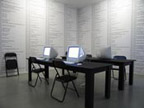
When Viewers Become Listeners
Radiodays is a temporary radio station. Realizing a listening exhibition rethinks ways of art presentation. By using an auditive format, artistic works are presented within a space in succession of each other rather than simultaneously: they appear, disappear and reoccur. The choice of using radio at the same time attempts to give a voice to an actual concern towards the auditorial found in many works by visual artists.
Radio and its non-visual message offers creative resistance to the retinal spectacle that surrounds us. It has been said that radio is dying. But one could also say that radio is highly topical; an old, nostalgic means of communication, a pre-modern dream, a modernistic reality, a strong tool for connecting people, for bridging distances. With its outdated technological capacity and low-fi communicational power, radio is distinct from other high-tech and high-speed commercialized mediums that are highly influenced by the capitalist sphere of interest. Commercials, billboards, TV culture, and big screens on the street are also part of retinal consumption. Looking is a way to experience the omnipotence of the “society of spectacle”. Closing one's eyes is becoming an act of civil disobedience.
Artists and theorists are invited to produce new works, lend existing works or interpret them specifically for the radio broadcast. The project wants to investigate the relationship between hearing and imagination, processes of translation. Broadcasting live from inside De Appel, the exhibited works are not limited to the physical building. Art is coming home and can be enjoyed in private surroundings rather than only within the physical exhibition space.
Thus, the exhibition space is considered as the base for live debates and (inter)action. This radio “show room” will act as a driving force to materialise an audience. By treating radio as an alternative space, we open many others: medium-specific space for medium-specific art, space for interactivity, cooperative space, space for discussion, and space for negotiation. During Radiodays every listener becomes a dynamic and transformative carrier, a conceptual space of possibility and experimentation. As a non-material medium, radio brings a new potential to participants and audience by immediately bridging distances. Referring to the successive way of presentation — like in a movie theatre — Radiodays can be seen as a “cinema for the ears”. What do we see when we listen to the work?
Posted by jo at 06:00 PM | Comments (0)
URBAN SCREENS:
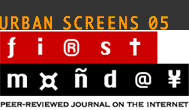
FIRST MONDAY SPECIAL ISSUE CALL FOR PAPERS
The Institute of Network Cultures and First Monday are happy to announce our first collaborative project: a special URBAN SCREENS issue of First Monday, scheduled for publication in early 2006. Papers from, or thematically related to, the conference are to be published in a special First Monday issue. Mirjam Struppek, Berlin, Geert Lovink, Sabine Niederer and Pieter Boeder of the Institute of Network Cultures will work with Edward Valauskas, Chief Editor of First Monday, as special editors for this issue.
As a contributor to/participant of Urban Screens, you are invited to submit your text - or a draft/synopsis thereof - for review to Pieter Boeder of the INC, pieterboeder[at]yahoo.com, who will be happy to give you advice and editorial assistance if needed. line for submission is Friday, 14 October 2005. After that, contributors will still have 60 days to put their papers in order. See guidelines.
URBAN SCREENS 2005 is an international conference ranging from critical theory to project experiences by researchers and practitioners in the field of art, architecture, urban studies and digital media. The focus is on understanding how the growing infrastructure of large digital displays influences the visual sphere of our public spaces. How can the commercial use of these screens be broadened and culturally curated? How can urban screens contribute to a lively urban society, and involve the audience interactively? Urban Screens 2005, 23 / 24 September 2005, TPG Building / Stedelijk Museum CS, 11th floor, Amsterdam.
FIRST MONDAY is one of the first openly accessible, peer reviewed journals on the Internet, solely devoted to the Internet. Since its start in May 1996, First Monday has published 631 papers in 111 issues; these papers were written by 748 different authors. First Monday is indexed in Communication Abstracts, Computer & Communications Security Abstracts, INSPEC, ISI‚s Web of Knowledge, LISA, PAIS, eGranary Digital Library, and other services. In the year 2004, users from 835,768 distinct hosts around the world downloaded 6,728,893 contributions published in First Monday. In August 2005, users from 89,498 distinct hosts around the world downloaded 485,746 contributions.
http://www.firstmonday.org/
Contact: Pieter Boeder
Institute of Network Cultures
HvA Interactive Media
Weesperzijde 190, NL-1097 DZ Amsterdam
t: +31 640 15 09 00
f: +31 (0)20 5951840
pieterboeder[at]yahoo.com
Posted by jo at 05:40 PM | Comments (0)
StoryRooms: Interactive Networks, Media Art and Installations
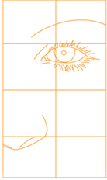
Unexpected Stories
The technical nature of the art works becomes invisible and instead they challenge the audience to take part in interactive scenarios, unexpected stories and impromptu visual dialogues. The projects examine our life in media culture and a digitised society: by linking the physical installation to the digital space and vice versa – within extraordinary models of art and networking that encourage the viewers’ very own creative input.
StoryRooms is curated by Andrea Zapp; born in Germany, and currently based in Manchester as a Senior Lecturer, media artist and theorist at Manchester Metropolitan University. Next to her art installation projects she has published several books, including publications with The British Film Institute, The German ZKM Centre for Art and Media and most recently with FACT/MMU - on media art, interactivity and networking.
Susan Collins, UK
Paul DeMarinis, USA
Ken Goldberg, USA
Paul Sermon, UK
Cornelia Sollfrank, Germany
Tan Teck Weng, Malaysia/Australia
Andrea Zapp, Germany/UK (installation soundtrack by Vini Reilly, UK)
When: October 11, 2005 - January 15, 2006; Where: Museum of Science and Industry in Manchester. You are kindly invited to the opening reception on Tuesday, October 11, 2005, 6 - 9 pm with an interactive audience performance by ELECTROBOUTIQUE (Alexei Shulgin & Aristarkh Chernyshev, Moscow). The event is taking place in the unique and historical setting of the grade one listed 1830 Warehouse at the Museum of Science and Industry, Manchester, UK.
For more information and contact please visit www.storyrooms.net or www.msim.org.uk
Funded by the Arts Council England/North West and supported by The Museum of Science and Industry, The Arts and Humanities Research Council, Manchester Metropolitan University, The Goethe Institute Manchester, Arts Western Australia and Western Australian Government.
Museum of Science and Industry
1830 Warehouse, Castlefield,
Liverpool Road, Manchester
10.00 am - 5.00 pm every day
admission free
Posted by jo at 05:20 PM | Comments (0)
September 25, 2005
form follows function
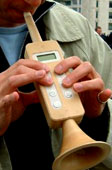
Behaviour Management
The 2002 Ideo case study Social Mobiles, in collaboration with artist/designer Crispin Jones explored the public/private domain and social impact of mobiles and the ensuing anger/frustation toward the intrusive nature of mobiles in public space.
Five phone prototypes each differently modify the user's behaviour to make it less disruptive by, for example, indicating when it's appropriate to place a call (the musical mobile), punitively inducing users to speak more quietly (the electric shock mobile), providing means for silent conversing (the speaking mobile -perhaps this should be the "emotive" alternative, since SMS is unobtrusive in terms of enabling silent communication). Documented concept prototypes of these and others are avaialble at the project site above.
Posted by michelle at 07:02 PM | Comments (0)
OneWordMovie
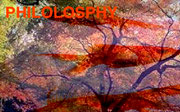
Collective Unconscious
Beat Brogle and Philippe Zimmerman's One Word Movie is an online platform which organizes, based on user-supplied terms, the flood of images on the internet into an animated film. A word turns into images, images turn into a movie. This project plays with the tension between online and cinematic approaches to images. What images are associated with what words? One Word Movie reveals a glimpse into the collective psychology of online cultures by showing patterns of word image associations, as created by millions of people around the world.
Using a specially programmed search engine, users can call up images from the Internet which match their search term. The project's search engine is built on top of the most popular image search facilities available on the Internet (e.g. Google). Supplied with a search term, the engine produces first a «hit list». This list can be several thousand images long, depending on the term. The images on this «hit list» provide the «raw material» for the movie . Following the ranking on the «hit list», the images are animated into a film in real-time, following a fixed and predetermined score, which consists of a series of interwoven loops. Each film has an individual trailer, displaying the search term as the title and each film lasts until the «raw material» is used up.
Posted by michelle at 04:29 PM | Comments (0) | TrackBack
social networking
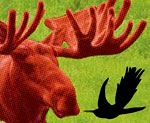
Call of the Wild
Inspired by the ability of the mobile phone to enhance polygamous activity through non-verbal, silent phone messaging, True Blue Love, a mobile phone social networking experience, is designed to explore the politics behind intimate phone-based relations.
Designed as a program for mobile phones, each participant enters into the program the characteristics of their ideal sexual mate, chosen from a series of preset selections (choose your animal mating habits from among hound, bird, ape, moose and pig and cross reference with your love metric for technocultural matchmaking!)
While the program is running, every time another phone comes within range, a love metric is calculated which is a representation of how close the incoming person matches the participant's ideal mate. If the match is close, the phone will emit a raucous mating call that will be unique to that participant. The concept behind the triggered mating calls is to attempt to undermine the silent technology of messaging and email with vocal communication that expresses the user's desires through a public broadcast, a broadcast that harks back to more primitive exchanges. The ridiculous sounds should function as social ice-breakers, and the unwilling couple may want to discuss what it is that they have in common that triggered the noise.
Posted by michelle at 04:34 AM | Comments (0)
Performing Web 3d
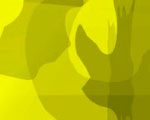
post avatar
Scorched Happiness is a live performance in 3d multi-user cyberspace using Julia Kristeva's text Toccata and Fugue for the Foreigner as a structure to explore the properties native to 3d cyberspace.
Artists Adam Nash (VRML, music) and Mari Yamanaka (visuals) collaborate with John McCormick of Company in Space to draw parallels between the text's investigation of the psychology of foreignness and the new and the unfamiliar of cyberspace. The project proposes to explore alternate vocabularies to mimicking real space, or exploring the relationship between physical presence and virtual presence by recreating the human form as avatar.
There has been little work done investigating the potential of shared networked space as a site for live virtual performance art on its own terms. Scorched Happiness is an attempt to develop a live performative vocabulary that is native to shared cyberspace.
What are the native qualities of 3D cyberspace? Real space properties such as up/down, in/out, falling/rising, heavy/light do not exist in 3D cyberspace without considerable effort expended in creating them. Scorched Happiness uses abstract, non-humanoid avatars to explore as many permutations as possible towards understanding the properties of 3D cyberspace. As the foreigner in Kristeva's text explores wildly varied emotional geographies in an attempt to know the new place, so does the avatar in Scorched Happiness' cyberspace. The foreigner is by turns ebullient, aloof, confident, melancholic, multilingual yet mute, ironic yet naive. The avatars in Scorched Happiness become huge, layered, temporally chimeric audiovisual events filling up the space then receding away as they react to one another's manifestations.
Logistically, the performance is eminently scalable. Naturally (and at its most fundamental), the performance can be experienced by logging in to the multi-user space - virtual audience members can thereby navigate the space freely, their navigation becoming part of the perception of the performance. Additionally, performances can be projected onto large screens at physical sites. It is the nature of 3D cyberspace that the performers may also be present at such a physical site or may be logged in from physically disparate locations. Multi-screen, multi-source projections can augment the experience at a physical site by projecting the performance viewpoints of different performers and audience members, with workstations provided for physical audience members to log themselves in from the physical site. Finally, the performances and avatars themselves can be made available in 'real time archive' form in single- or multi-user form to experience when the performers are not logged in. These can naturally be accessed via the internet from a workstation or projected on to a large screen.
Posted by michelle at 04:10 AM | Comments (0)
Instrument of Experience
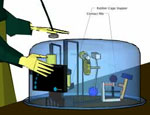
exploratory listening experience
Music composer/interactive sound artist Ali Momeni and sculptor Robin Mandel collaborate on the perScrutinizer , an interactive installation exploring gesture, expectation and musical interactivity.
Hand gestures are translated to electro-mechanical movements of remote-controlled objects. In response to hand gestures, the objects play their bell jar / cage-structure like a percussion instrument, they collide with, scrape against and bounce off its walls. Real-time software generates additional musical layers that are amplified onto the cage by a coupled loud-speaker driver. While playing the cage with one hand, the user listens to the cage with a stethoscope in the other hand.
The stethoscope is introduced as listening interface: one plays with one hand and listens with the other. The stethoscope allows the listener to move freely from one installation to another, listening to or joining another user's musings on a different instrument. The layout of the installation as well as the design of certain cages encourage simultaneous play by multiple users.
Posted by michelle at 02:30 AM | Comments (0)
trust and shared intimacy

love with technical difficulties
Opened September 22 at Artspace in Sydney Australia, Fish-Bird Circle B-Movement C is an interactive installation by Mari Velonaki exploring human computer interface through interaction with kinetic objects. The Fish-Bird project utilises wheelchairs personifying a fish and a bird that fall in love but can't be together due to "technical difficulties".
Wheelchairs equipped with robotic arms enable fish and bird to communicate through writing. Each wheelchair writes in a distinctive cursive font that reflects its “personality”. The written messages are subdivided into two categories: personal messages communicated between the two robots, and messages written by a robot to a human participant. Personal messages are selected from fragments of love-letters offered by friends, from the poetry of Anna Akhmatova, and from text composed by Velonaki.
The audience internalises the characters through observation of the words and movements that flow between the characters, and between the characters and the audience, in response to audience behaviour. Through movement and text the artwork creates the sense of a person, and allows an audience to experience that person through the perception of what is not present.
Posted by michelle at 12:43 AM | Comments (0)
September 24, 2005
SonicWireSculptor

Correlation Between Vision and Sound
At its simplest form SonicWireSculptor is a novel 3D drawing tool and a unique musical instrument, but perhaps most important - its just fun to play with. The project started out as a personal instrument for Pitaru to perform on. During concerts, audience members often inquired whether they could experience the tool first hand. This encouraged Pitaru to transform the software into an immersive public installation. The installation included enhancements to the original work, allowing a wider range of users to intuitively interact with the environment. Gallery visitors would enter a dark room with a surround-sound system, a projection and a unique drawing station. Opening nights for these exhibits would often double as performance and workshop events where the audience and Pitaru explore the tool together. Participants would be encouraged to add their work to a steadily growing collection of beautiful and surprising sonic-sculptures. [Related]
Posted by jo at 03:43 PM | Comments (0)
September 23, 2005
Myth Hacking
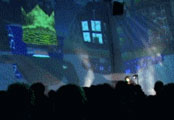
Art imitates Life
MEDEAEX is an adaptation of the classic Myth of Medea, projected cross-culturally to span the Middle-East Reality (Medea = Palestinian, Jason = Israeli officer, Chorus = audience) and the CyberSpace Virtual Reality (Medea is a hacker trying to debug and redesign the script). The Israeli-Palestinian framing of the myth addresses issues of exile, homeland and culture and the VR 3d interactive world creates a space of participation.
Developer Neora explains how the experience was conceived and structured and how the myth / story was mapped to current sociopolitical events. She propositions a would be audience:
What if I invite you to join Medea the hacker, in her confrontation with Medea the Myth, using Euripides and Muller lines in a simulated universe, where Medea is Palestinian, Jason is Israeli, and Middle East news dictate what they do and how they act?
What if I invite you to interact with objects and avatars in the immersive environment surrounding you, to react and say your word in a plot that its order of scenes is modular, and each performance may be different in ambience and in the “debugging” process of trying to recreate reality, to redesign the myth?
There are two ways to visit the ME DEA EX universe - physically attend the performance and see the live actress interacting with 3D world projected on the walls, or enter via the internet and affect the show, while watching the actress via her webcam. Both ways, you may become part of the chorus (the global village), that sing classic lines using text-to-speech mechanisms, saying: We could have saved the children... We could have done something...
The MEDEAEX universe is a 3D environment that resides on the Internet and is projected during the performance in 360 degrees around the audience. It is a proactive environment, whereas Medea is a live actress (Khaula ElHadj-Dibsi) all the other characters are pre-programmed bot avatars, and the audience (e.g. the global village) can interact and influence the flow and ambience of the show, using SMS from their cellular phones.
The script is fully hyper-textual, based on the original texts by Euripides, Heiner Muller and Seneca. It is written and performed in English, Hebrew and Arabic, and so is the background music cross-cultural and cross-lingual. The exposition to each scene is the actual Middle East News (Medea - betrayed, evicted, exiled, and after all sacrifices her children by sending them as suicide bombers to Jerusalem). The chorus lines are performed with text-to-speech mechanism, allowing online and real time audience to add to their digital singing data bank.
Posted by michelle at 06:59 PM | Comments (0)
September 22, 2005
amorphy.org
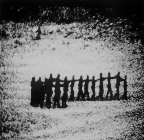
a synchronous union
amorphy.org produces original works of live performance and installation connecting image, movement, and design elements in a synchronous union that creates incredibly detailed performances. To push boundaries of presentation, interactive technologies are utilized in selected works (optic tracking systems, sensor interfaces, live video mixing, Max/MSP programming software, etc.) Issues such as difficulty of communication amidst never-ceasing technological advance are tackled and dissected; impact of close proximity urban living, politically and sociologically inspired topics of interest, and other fascinations. The work is intrinsically hybrid in nature, meaning the merger of art forms to create an integrated performance. We are humans living in a complex world and the work we create is likewise complex and packed with layers where each element can be viewed as a discrete layer that combines to create a complete whole. Although amorphy.org is a structured entity, the work is collaborative in nature and new colleagues enter on per project basis and in some cases strike long-term partnerships. The present goal of the company is to continue challenging existing models of art creation with an emphasis on a co-existence and fusion of interactive media and performing arts. As a long-term goal amorphy.org is in the process of creating the first Media Lab Center facility in Greece in the next two years with the kind support of governmental and private funding bodies.
Posted by jo at 07:35 AM | Comments (0)
PLAN Exhibition @ Futuresonic 06
![]()
Call for Proposals
The final exhibition and conference of PLAN - The Pervasive and Locative Arts Network will take place in Manchester during July 2006 as a part of the Futuresonic 2006 festival. PLAN is currently developing the scope and format of the exhibition, and the PLAN Technology Workshop in October will feed into this planning.
Advance Expressions of Interest: If you have a proposal for a new project that you would like to develop with PLAN to be included in the exhibition then please send an initial outline to us immediately, to arrive no later than Friday 7th October.
Open Call: If you have an existing project, or a project that will be completed before July 2006 without support from PLAN, the submission deadline is Friday 16th December.
About PLAN - The Pervasive and Locative Arts Network: The Pervasive and Locative Arts Network (PLAN) is an international and interdisciplinary research network funded as part of the Engineering and Physical Sciences Research Council (EPSRC) Culture and Creativity programme. The network aims to bring together practising artists, technology developers and ethnographers with the aim of advancing interdisciplinary understanding and building consortia for future collaborative projects.
Aims of the PLAN Exhibition: The PLAN Exhibition will showcase new concepts in pervasive and locative media, with a focus on large scale public experiences that communicate the possibilities and research challenges to a broad audience. The exhibition will form part of an art festival, but is anticipated to include social, political and scientific projects as well as projects where the aims are primarily aesthetic or about audience participation. Further details on the scope and focus of the exhibition will be available after the PLAN Technology Workshop during October.
How to Submit Expressions of Interest: Initial expressions of interest and proposals are invited for the PLAN exhibition that will take place in Manchester during July 2006 as a part of the Futuresonic 2006 festival.
Please send your proposal _by email_ to Hazel[at]cs.nott.ac.uk.
Supporting materials and a hard copy of the submission should also be
sent by post to:
Dr Hazel Glover
Equator Research Project Manager
School of Computer Science & IT
University of Nottingham
Jubilee Campus, Wollaton Road
Nottingham NG8 1BB
Tel: 0115 846 6780 Fax: 0115 846 6416
Advance Expressions of Interest: If you have a proposal for a new project that you would like to develop with PLAN to be included in the exhibition then please send an initial outline to us immediately, to arrive no later than Friday 7th October.
Open Call: If you have an existing project, or a project that will be completed before July 2006 without support from PLAN, the submission deadline is Friday 16th December.
PLAN EXHIBITION SUBMISSION FORM
About You
Your Name:
Address:
Telephone:
Mobile:
Email:
Website:
Short Biography or CV (150 Words):
About Your Project
Name of Project:
Brief Description of your Project (200 Words)
New or Existing Project
Is your project:
A An existing project
B A new project
If your project is new, please do you need support from PLAN to produce
the work?
A Yes
B No
Production Plan
Please provide a brief outline of how you plan to produce your new project. Please answer the following questions: How are you planning to do it? Who are the people involved and what will their responsibilities be? What is your production timeline?
Budget
Submit a short budget showing the costs associated with making your project. If you have funding sources for your project, please indicate this in your budget, stating if applied for or confirmed.
Examples of work
We would like to see examples of your past work. If you want to post examples of your work, please send them to:
Dr Hazel Glover
Equator Research Project Manager
School of Computer Science & IT
University of Nottingham
Jubilee Campus, Wollaton Road
Nottingham
Posted by jo at 07:14 AM | Comments (0)
i m P A C T 05:
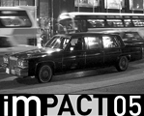
Tracing Translation
i m P A C T 05 - Tracing Translation is an interactive symposium in three episodes over three days, From October 30 to November 2, 2005, at PACT Zollverein, Choreographic Centre NRW, Essen, Germany. i m P A C T 05 will be led by four artists who each renegotiate through their work the scope and perimeters of the performing and visual arts. Taking decidedly individual approaches, Xavier le Roy (FR/D), Antoni Muntadas (ES/US) and Miranda Pennell/John Smith (GB) not only address subtle shifts in the relationship between public and private spheres but are also concerned with investigating artistic translation strategies between the fields of documentary and fiction.
The symposium opens on Sunday evening with a performance of Product of circumstances by Xavier Le Roy and a film programme of works by Antoni Muntadas, Miranda Pennell and John Smith. Thereafter, lectures, live and multimedia presentations as well as group discussions and actions held in spaces both in and around PACT Zollverein combine to generate a conducive atmosphere for experimenting and reflecting.
The working language is English.
i m P A C T 05 is aimed at artists/theoreticians, journalists and advanced students of theatre, dance and media arts.
i m P A C T 05 also offers participants an opportunity to present and discuss examples of their own work.
With the support of the Kunststiftung NRW, there are seven scholarships available for i m P A C T 0 5 covering the symposium fee and hotel costs.
Applicants should submit a CV, letter of motivation, and, where applicable, a summary of a current project they would like to present during the symposium. The closing date for applications is 15 October 2005
Fee: 100,- EUR0, which includes: The 3-day symposium, 1 performance and 6 meals.
Further information, programme details and application forms under:
http://www.pact-zollverein.de A printed leaflet/poster will be available from mid September.
PACT Zollverein
i m P A C T 05
Ulrike Boecking,
Bullmannaue 20
D-45327 Essen
Fon: +49 (0)201 289 47 26
Fax: +49 (0)201 289 47 01
ulrike.boecking[at]pact-zollverein.de
Posted by jo at 07:13 AM | Comments (0)
Strainings

Sift, Sort, Stretch, Pull
To see is to choose. To see is to select something and overlook something else. To be seen is to exist. When someone set sights on you, you appear in the other persons world.
Strainings--by MusicalFieldsForever--is about this genesis: to select what you want to keep from that which should be left out. In a physical, personal and cultural sense. Strainings is an interactive sound and light (audiovisual) installation contained in a silo. The many interpretations of the word "strain" embrace all of this: to sift and to sort, as well as to stretch and pull a string. In Strainings the audience decides what should be heard and seen. By pulling strings, they change the mesh of the strainer/ the large web. Light, sounds and images are strained and created.
Strainings consists of 7 light ropes 6 meter long, hanging from the roof and pulled through a web of flexing rubber bands. Interacting with the light ropes changes the structure of the web that cast shadows on to the projected images on the wall. A camera analyses movements in the light ropes and the input is used to change and make variations in the light, the light ropes and the sound. The background sound consists of bell frogs recorded in Baldringe, Sweden, strings and synthesised sounds that change, mix, and filter generatively. The interaction sound consists of trumpet loops with granular synthesis making it possible to play continuously and changing tones when pulling the ropes.
The software is developed in Max/MSP and SoftVNS. [via]
Posted by jo at 07:00 AM | Comments (0)
How-To: Embed a wifi detector into a backpack strap
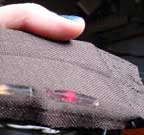
Integrated WiFi Sniffing
"Do you have a messenger bag or backpack you use regularly? Do you have a laptop or other device with wifi in said bag? Wouldn’t it be cool to integrate wifi sniffing into your bag and not have yet another device on your keychain? Today we will show you how to take an existing inexpensive passive wifi detector and embed it into the strap of your messenger bag or backpack.
Creativity is the key with this hack! If you have basic soldering and sewing skills, you can finish this mod easily in an afternoon. A flickr stream with annotations for this project is located here. Images with flickr annotations are clickable (i.e. if the image is associated with the flickr stream it will link to to it)." Continue reading at engadget.com.
Posted by jo at 06:53 AM | Comments (0)
September 21, 2005
ROBODOCK 2005 ON NDSM-WHARF
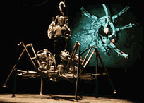
AquaDock
The 8th edition of the Robodock Festival 21 - 24 September 2005 will take place on the NDSM-wharf in Amsterdam-Noord this year. Robodock is a unique international summer festival, that merges technology and art. Spectacular theatre acts, multi-media, visual arts, music, industrial installations, robots and experiments sweep the audience off their feet in an overwhelming flood of experiences. This year water will be the linking element, hence the subtitle AquaDock.
The programme of Robodock is surprising and new. It presents both acts and installations that have been succesful abroad (state of the art) and projects in the field of art and technology that are still in an experimental stage. Robodock is more and more an inspiration to many participating artists who make an exclusive contribution to the festival.
The audience is presented a four-day programme that has no like in Europe. The festival is also an important platform for international artists, scientists and theatre makers. This year, these professionals join in a conference on technology and art, in collaboration with science center Nemo, for the first time.
Posted by jo at 06:16 PM | Comments (0)
The Digital Zoo

Telematic Interaction with The Big 5
The Digital Zoo, by radarboy, is reminiscent of tamagotchi nurturing, explores our emotional relationship with technology and how we relate to and treat wild animals within the context of a zoo. It was produced for the Low-Fi & Stills show in Edinburgh.
The five animals are Africa's Big 5: lion, leopard, buffalo, elephant and rhino - once the most sought after to hunt, but now mostly reduced to tourist icons. Visitor sends text message to the Zoo. The message is interpreted and forwarded to the radarboy server. The relevant animal and action is invoked and a response is written to the database. SMS confirmation reply to sender.
The Big 5 can be fed, played with, and nurtured into adulthood. Neglect will lead to a decline in health and ultimately their death. Their well-being can be monitored via SMS in the gallery and via the internet at home. Try it! Click here and send a message to a lion. [blogged by Emily on textually.org]
Posted by jo at 05:41 PM | Comments (0)
Play-Doh as Interface

Fuzziness in a World of 1s and 0s
"Analog control of digital devices and media has always appealed to [Brendan Dawes]. Like the controllers for a PS2, they allow degrees of fuzziness in a world made of very strict ones and zeroes. Life is not black and white, so for deeper interactive experiences we need to look at control devices that allow our analog thinking brains to influence and control this digital world.
Play-Doh is a fantastic analog material. It’s the total opposite of the ones and zeroes paradigm. So I took the idea of exploring Play-Doh as a fuzzy interface, looking at various ways to use this tactial, fun “interface” and use it to control digital media. In this example the amount of Play-Doh on screen dictates how fast the film plays. The amount of Play-Doh on screen dictates the speed of the film.
As I twist the Play-Doh and take bits away, the film reacts accordingly in real-time. Add too much Play-Doh and the film rapidly speeds up. An intimate connection is made between the user and the media. Every action has a reaction in the digital space. No scary buttons to press. No instructions to read. It’s just Play-Doh."
Posted by jo at 05:30 PM | Comments (0)
Workshop on Tactical Media by Sarai Media Lab
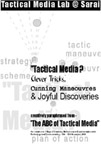
Writing On The Surface Of The City
Workshop on Tactical Media by Sarai Media Lab: Writing On The Surface Of The City: The Tactical Media Lab will focus on the interplay of form and content through the production of broadsheets. The workshop will move towards a conceptual understanding of tactical media - broadsheets in particular. A broadsheet as envisaged by us is a light, playful form that also allows engagement with serious concerns. The content for the broadsheets produced during the course of the workshop will be developed through interaction among the participants during the concept building phase. The issue that will be explored through various text and image forms will be ''information society''.
The workshop will be useful to individuals interested in tactical media, urban studies, journalism, writing and issues of information society. If you want to participate please email namita@altlawforum.org by 25th September. Applicants will be chosen on a first come, first serve basis.
Dates : 1st and 2nd October from 9 to 6
Venue: Mahiti, Domlur (Bangalore)
Free of cost , lunch included.
Only 20-25 participants.
Anyone interested in attending may contact namita[at]altlawforum.org
Posted by jo at 02:16 PM | Comments (0)
Telepresence and Bio Art
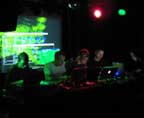
Transgressing the Interface
Telepresence and Bio Art: Transgressing the Interface, a seminar and workshop with and about EDUARDO KAC is arranged by The Aesthetics of Interface Culture: KaserneScenen, Store Sal. Institute for Aesthetic Studies, University of Aarhus, Langelandsgade 139. 6 October 2005. Workshop 7 October, 2005. PROGRAMME FOR THE SEMINAR: 9.30-9.35: Welcome and introduction; 9.35-11.00: Eduardo Kac, Chicago: "Telepresence and Bio Art: Networking Humans, Rabbits and Robots":
After an introduction contextualizing his pioneering telepresence work, in progress since the mid-1980s, Kac will give examples and further discuss his current transgenic work. Eduardo Kac's art deals with issues that range from the mythopoetics of online experience (Uirapuru) to the cultural impact of biotechnology (Genesis); from the changing condition of memory in the digital age (Time Capsule) to distributed collective agency (Teleporting an Unknown State); from the problematic notion of the "exotic" (Rara Avis) to the creation of life and evolution (GFP Bunny).
Kac will conclude with a brief explanation of his most recent transgenic works -- "GFP Bunny", "The Eighth Day", and "Move 36". "GFP Bunny" is comprised of three elements: the birth of a rabbit that has a gene from a jellyfish (a gene that produces green fluorescent protein), the public dialogue that the project has generated, and the social integration of the rabbit in the context of the artist's family. "The Eighth Day" is a transgenic ecology that includes a biological robot, all linked interactively to the Internet. "Move 36" sheds light on the limits of the human mind and the increasing capabilities developed by computers and robots, and includes a new plant created by the artist. Following the lecture, the artist will autograph copies of his just released book, Telepresence and Bio Art -- Networking Humans, Rabbits and Robots, published by The University of Michigan Press.
11.00-11.30: Coffee break
11.30-12.30: Jacob Wamberg, University of Aarhus: "Guided Evolution: Between aesthetic and teleological judgement"
Moving into telepresence and the manipulation of biological material, art seems to fulfill its oldest desire: engulfing that reality which before it could only dream about. With telepresence the viewer is transformed to an actor breaking through the representational screen, and with bio art sculptures are becoming more alive than Pygmalion’s mistress. What does this transgression of the medium mean for the concept of art? Especially the creation of organisms could reactuate Kant’s dictum of disinterestedness, as nothing seems less apt for being instrumentalized than life itself. On the other hand, legitimizing the evolution of new organisms purely on aesthetic terms seems just as irresponsible. This paper will opt for a ‘weak teleology’.
12.30-13.30: Lunch
13.30-14.30: Claus Emmeche, Niels Bohr Institute: "Attractive mysteries of the organism?"
What are the relations between true monsters and biological organisms? The question comes to mind when facing not only creatures created by biotech industries for the purpose of utility, but also seeing recent artistic uses of "real" organisms. Here, utility, aesthetics, and technoscience meet in a new form of monsters, raising questions of the ontology of other forms of hybrids than known from classical natural history. I will comment upon some of the open problems in the creation of artificial life and hybrids from the perspective of philosophy of biology and biosemiotics, the study of life processes as sign processes.
14.30-14.45: Coffee break
14.45-15.30: Discussion and concluding remarks
WORKSHOP:
Kac' work sparks discussions on the relations between semiotics, art, technology and life, which will be the subject of the open seminar described above. In addition to the public seminar interested researchers, Ph.D. students and art professionals will have the possibility to participate in a more intimate closed workshop 7 October with a limited number of participants. To participate a short (1-2 pages) position paper in English is required, where you present yourself, your research and how it relates to (elements of) Kac' work – see http://www.ekac.org/. Send paper to pold@multimedia.au.dk with the subject "Kac workshop" in MS Word format. Deadline: 19 september. Only a limited number of participants will be admitted, notification of acceptance necessary to enter.
The workshop will take place 7 October from 10-14 at Turing 130 in the IT-Park, Aabogade 34.
Posted by jo at 02:00 PM | Comments (0)
NODE.L

[Networked, Open, Distributed, Events. London]
Artists and artist groups are invited to register interest in producing a project within NODE.London. We hope to attract projects from a geographically dispersed and diverse range of practitioners who can play an active and dynamic role in the season in March 06.
NODE.L: [Networked, Open, Distributed, Events. London] is an open, participatory season that aims to support and stimulate Media Arts in London during March 2006. From collaborative mapping projects on the street, to community radio and free wireless networks in the air, people across London are finding new and creative ways to produce, display and distribute art and media, and exciting new ways to work, connect and communicate. NODE.L is a showcase for work that in production and/or exhibition, performance and processes, employs electronic or digital technologies (whether audiovisual, computerised, or telematic).
While NODE.L will be International in terms of participation, we are really serious about the 'London' bit. NODE.L will be city-wide, seeking out every borough, bridge, and public walkway; towering views, glass and steel, crumbling brick, winding alleys and waterways ...help us locate media art in London, and put yourself on that map too.
For updates and announcements, join the node london announce list at:
http://lists.nodel.org
Posted by jo at 01:37 PM | Comments (0)
In The Weather
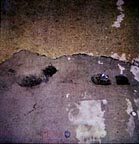
Self-Guided Walking Tours
A map of a walk records the memory of a singular experience. The map provides a route; when directions given by another are followed, the route becomes a path. Walking becomes an exploration of the city at once private and shared.Melinda Fries and Bonnie Fortune share an interest in exploratory walking and have collaborated as In The Weather since 2004. This year they published In the Weather self-guided walks/Chicago, which includes walking directions by 16 Chicagoans. The booklet is dispensed freely at 10 locations throughout Chicago.
In The Weather--included in in the current exhibition URBAN / RURAL / WILD--is seeking submissions to be included in an online database, intheweather.org, from which users may download Walking Directions. Walking Directions can be from/to any place and the walk can be of any length. Walking Directions can be given in writing, drawings, photographs, or other forms; maps are encouraged. To submit a set of Directions or to ask questions, please send email to: submit[at]intheweather.org. [via eyebeam reblog]
Posted by jo at 09:47 AM | Comments (0)
Five Streams
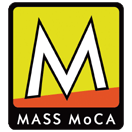
Anarkali, Bhagavad-Gita, and Who Knoweth Himself
In a piece stunning to both the eyes and ears, this work-in-progress by Ibrahim Quraishi reinterprets ancient texts to examine Islam in the five nations of South Asia-India, Pakistan, Bangladesh, Nepal, and Sri Lanka. Five Streams is a theater performance that integrates live and pre-recorded voice, dance, 3-D animation, and interactive sound installations to illuminate the three foundational texts in the cultures of the region: Anarkali, a tragic court romance of Mughal India; the Bhagavad-Gita, the deeply philosophical climax of the Indian epic Mahabharata; and Who Knoweth Himself, a mystical treatise by the Sufi philosopher Ibn al-Arabi. Paul Miller a.k.a. DJ Spooky and choreographer Parul Shah are among a large group of collaborating artists, many of whom will participate in a 2-week residency at MASS MoCA. Presented in collaboration with The Asia Society. [via eyebeam reblog]
Posted by jo at 09:37 AM | Comments (0)
Setpixel
![]()
Blog Zine
Setpixel is a collection of articles written by a small group of like-minded individuals. The general focus of the articles contained in the site are on interactive installations, aesthetics through computation, reactive experiments, creative computer vision, et cetera.
The direction of the collection of writings will be affected by the independent opinions and directions of the selected artists. These authors were carefully selected because of their works, thoughts, and outlook on the topics above. If you would like to contribute and feel like you have something to contribute to the viewers, please email us.
Current Authors:
Charles Forman, Media Artist. Seoul, Korea.
Chris O'Shea, Digital Artist. Plymouth, UK.
Chris Sugrue, Artist, Designer, Programmer. New York, USA.
Christian Giordano, Interactive Designer/Developer. Milan, Italy / London, UK.
Cristobal Mendoza, Media Artist. Philadelphia, US.
Glen Murphy, Programmer Designer Artist. Melbourne, Australia.
Josh Nimoy, Undefined. Brooklyn, US.
Ubi De Feo, Creative Developer. Amsterdam, Nederlands.
This site's contents are simply: articles and authors with a category system. The articles are associated with multiple categories that apply to that article. Furthermore, there is a 1-5 rating given to each association to that article. For example, if you read an article and want more information, simply click a category and see all similar articles. If you would like to see a particular category added, or see a mistake, please email us!
Current Categories:
Audio
Business
Cameras
Computer Vision
Creative Process
Culture
Demo
Electronics
Event
Fabrication
Installations
Interaction Theory
Interview
MAX/MSP
Physical Concept
Processing
Projection
Psychology/Behavior
Review
Sensors
On every page, comments can be left for other people to read. Please feel free to leave a comment! The authors and other viewers are interested to hear what you have to say.
Tentatively, every 6 months to 1 year, a printed publication will be released containing selected articles. This will be available also as a PDF document. Depending on the interest, a DVD may also be produced with video works from the articles.
It should also be noted that all contents on this site are copyright Setpixel and thier respective authors.
The current article listings are available as news feeds:
ATOM, RSS 0.91, RSS 1.0, RSS 2.0.
Contact:
If you have any questions, comments, or concerns, please feel free to contact us.
Charles Forman
contact AT setpixel.com
Posted by jo at 09:31 AM | Comments (0)
You're kidding me!?

Tools for the Very Insecure
is a wireless voice-based service that helps users simulate a You're kidding me?! mobile phone conversation. The automatic service is designed to assist people at conferences, gallery openings and other places where being socially disconnected is no fun. After dialing the service number, users can choose between two types of conversations: a 'casual' or an 'important' conversation. The user is subsequently guided through a series of words and sentences that - when being repeated - makes it look and sound like a real conversation is taking place!
You're kidding me!? is designed for the INDEX:2005 conference in Copenhagen by 1508 A/S (the design agency that I am working for). The service is based on a conceptual artwork called dialogue that I created some time ago. Now, in collaboration with my colleagues at 1508 the concept has been refined and is fully operational! Try it out: +45 7015 1508 (local charge). [via guerrilla innovation]
Posted by jo at 09:10 AM | Comments (0)
Tale of Tales
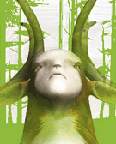
Where Mouse Meets Forest
No longer solely for time-wasters, Massively Multiplayer Online Games (or MMOGs) are fast becoming the preferred method of conducting activities ranging from business meetings to weddings, to funerals. Trying to free these games from their often-violent plotlines are artists-designers Auriea Harvey and Michael Samyn, of Tale of Tales, a game design studio based in Gent, Belgium. Initial founders of the groundbreaking websites Entropy8 and Zuper!, the duo aim to challenge the fundamentals of game play by creating a 'plot free' experience of exploration and contemplation. 'Endless Forest' is their answer to this call. It's a third-person perspective 3D MMOG where each player assumes the likeness of a young deer running through a magical forest landscape. Harvey explains, 'We want to make paintings with game technology. Interactive, immersive, operatic paintings.' They conceived of 'Endless Forest' as 'a performance space and a screensaver, as an interactive environment masquerading as a game.' After releasing their first game, '8,' about a young girl-turned princess, the duo are attempting to use the medium as a storytelling device that replaces video gaming's traditional goal-based narratives with those of discovery and community involvement. The game is now in public beta-mode and freely downloadable at their website. - Jonah Brucker-Cohen, Net Art News, Rhizome.
Posted by jo at 07:23 AM | Comments (0)
September 20, 2005
Performance Research

Magazine Seeks Proposals
Performance Research Issue 11.2 (June 2006) Indexes; Issue Editor: Ric Allsopp.
In the spring of 2006 Performance Research will begin its second decade of publication, and we are devoting the four-issues of Volume 11 to an exploration of the terms under which performance is debated, discussed, conducted, written about and constructed, in the form of lexicons and dictionaries, encyclopedias and key words. Volume 11, No.2 (June 2006) is an an issue on the nature of the index as a form. The issue will explore the use of indexes as a means of recording and generating through alphabetic, numerical, or color schemas ; restriction or censorship of particular readings or performances; measurement, linking, adjustment, tracking and navigation; or their use as something visible, evident or revelatory that gives grounds for believing in the existence or presence of something else; as an operation to be performed, an ordering relation; as repertoire or register, rubric or catalogue. In particular the issue will explore what indexes can tell us about the textual and performance forms that they relate to. We invite artists and writers to consider these in relation to the histories, philosophies and pragmatics of performance, art making and performance writing.
Deadlines for issue 11:1 are as follows:
Proposals: 17th October 2005
Finalised material: 31st December 2005
Publication Date: June 2006
ALL proposals, submissions and general enquiries should be sent direct to:
Linden Elmhirst - Administrative Assistant
Performance Research
Dartington College of Arts, Totnes,
Devon TQ9 7RD UK
tel. 0044 1803 861683
fax. 0044 1803 861685
email: performance-research@dartington.ac.uk
web: http://www.performance-research.net
Content specific enquires should be directed to Ric Allsopp at: transomatic[at]orange.net, r.allsopp[at]dartington.ac.uk
Enquiries about the volume as a whole should be directed to: Ric Allsopp transomatic[at]orange.net OR Claire MacDonald clairemacdonald1[at]mac.com
Performance Research is MAC based. Proposals will be accepted in hard copy, on CD or by e-mail (Apple Works, MS-Word or RTF). Please DO NOT send images without prior agreement. Please note that submission of a proposal will be taken to imply that it presents original, unpublished work not under consideration for publication elsewhere. By submitting a manuscript, the author(s) agree that the exclusive rights to reproduce and distribute the article have been given to Performance Research
Linden Elmhirst
Administrator
Performance Research
Dartington College of Arts
Totnes, Devon TQ9 6EJ UK
Tel : +44 (0)1803 861683
Fax : +44 (0)1803 861685
e-mail : performance-research@dartington.ac.uk
http://www.performance-research.net
Posted by jo at 01:21 PM | Comments (0)
IASPIS Symposium
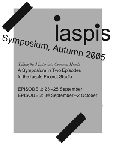
Taking the Matter into Common Hands
IASPIS Symposium in two episodes with presentations, screenings, discussions and workshop; 23 - 25 September and 30 September - 2 October.
In recent years, a renewed interest in collective work and activity can be discerned more and more clearly. Collaborations of various sorts have begun to appear as alternatives to the predominant focus on the individual so often found in the art world. In a variety of projects, the form and basis of collective activities have been presented, examined, and called into question. Taking the Matter into Common Hands is a symposium in two parts which, against the background of this development, seeks to map these activities and to discuss the working relations and conditions of artists and other producers of culture. It also aims at exploring the future prospects for the kind of collective action in the art world that is geared towards long-term research and production of knowledge.
Participants 23 - 25 September:
Johanna Billing (artist, Stockholm), Alex Foti (activist fighting against precarity, Milan), IKK (organization working with issues concerning economic and social conditions for artists, curators and other professionals in the art field), Maria Lind (director IASPIS), Lars Nilsson (artist and writer, Gothenburg), Marion von Osten (artist and theorist, Berlin), Simon Sheikh (critic, curator and writer, Copenhagen, Berlin, Malmö), Katharina Schlieben (curator at Shedhalle, Zurich), Apolonija Sustersic (architect and visual artist, Stockholm), Tirdad Zolghadr (film-maker, critic and curator, Teheran/Zurich ) and Å.b.ä.k.e. (graphic design collective, London).
Participants 30 September - 2 October:
B+B (curatorial partnership, London), 16 Beaver Group (network of artists, curators, writers, thinkers and activists, New York), Copenhagen Free University (self-organised institution dedicated to the production of critical consciousness and poetic language), Brian Holmes (art and culture critic, Paris), Marysia Lewandowska (artist, London), Schleuser.net (lobby organization and art project), School of Missing Studies (international network for experimental study of cities), Judith Schwarzbart (curator and researcher, Edinburgh), Sharzhad (accomplish things others cannot), Anton Vidokle (artist and founding director of e-flux, New York), What, How & for Whom / WHW (independent curatorial collective, Zagreb).
Location: In the IASPIS Project Studio, where there is an installation by Michael Beutler (artist, Berlin), as well as the Archive on Collaborative Practices, an archive that documents different forms of collaboration in and around the art world.
Taking the Matter into Common Hands is put together by Johanna Billing, Maria Lind and Lars Nilsson.
For further information and reservation:
http://www.iaspis.com/commonhands
extra[at]iaspis.com
IASPIS
Box 1610, SE-111 86 Stockholm
Tel: +46 (0)8 402 35 77 / Fax: +46 (0)8 402 35 92
Posted by jo at 12:29 PM | Comments (0)
Remain in Light

Netting Ambient Analog Sound Waves
[...] Remain in Light, by Haruki Nishijima, is a visual representation of ambient analog sound waves captured using an "electronic insect-collecting kit." The "collector" carries an insect net that functions as an antenna and is attached to a device designed to capture the waves. Participants walk outside with the net. Through headphones, they can listen to phone conversations, AM radio, taxi drivers’ and police radio communications. A button on the handle allows collectors to record one-second sound bites.
These fragments of analogue information are transmitted to a computer that transforms them into points of light that are then projected onto the exhibition space. Each frequency is represented by a different colour. When visitors enter the space, their presence and movements are detected by sensors. This is how the "electronic insects" are activated, disperse then progressively disappear. Each light source is accompanied by a sound. The installation can be activated on the Internet. Remain in Light was part of the Touch Me festival in Zagreb, Croatia [...] Related: Tools for radio wave hunters [blogged by Regine on we-make-money-not]
Posted by jo at 11:50 AM | Comments (0)
Radio Astronomy
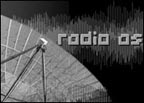
Streaming from Deep Space
"One of the peculiar aspects of streamed transmissions is the immediate delocalization of informations, thanks to the pervasive structure of the net which allows a personal and continuous 'international telecast', bringing any local content to screens in remote places. This is true both for video and audio transmissions, with the latter sometimes even more tied to the territory they are brodcasted from and expressions of a culture that needs to be understood and contextualized before being enjoyed. Thus, the place the sounds come from is reduced to the simple title displayed by the sound player while the data inexorably fill the buffer and the audio card processor before hitting our ears. Despite this, the farther the source of the transmission is, the more fascinating the listening opportunity will be. Radio Astronomy is based on this principle. It's an ambitious project by Radioqualia (Honor Harger and Adam Hyde) realized through collaborations with several radiotelescopes scattered throughout the globe. The sounds coming from deep space are intercepted and decoded by the radiotelescopes themselves and channeled to a sound stream that is then made available on the net, connecting any place reached by the net to the frequencies coming from light years away. As the authors themselves say, Radio Astronomy is "a radio station that transmits sounds coming from outer space", and one of its greatest features is the possibility to hear really distant frequencies amplifying the feeling of distance we have gotten used to since the advent of the net." --neural.it [Related]
Posted by jo at 11:07 AM | Comments (0)
September 19, 2005
OPENSTUDIO
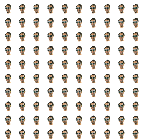
The Creative Economy is Launched
At the AIGA National Design Conference held in Boston this week, the PLW announced our new OPENSTUDIO project. OPENSTUDIO is a system we've been working on for three years now that combines "creativity, collaboration, and capitalism" in an experimental online art exchange system. Our goals are to provide simple, extensible, creative tools for free in an open, web-based environment.
Underlying OPENSTUDIO is a currency system we call the "Burak" (named after the trustworthy Burak himself) that pervades our model of online exchange. If you like a piece created in OPENSTUDIO by a friend, you can buy it with Buraks. You can sell your own as well. What are ownership models of purely digital art? This is one of the important questions we hope to experiment with in OPENSTUDIO. And if people make a few Buraks in the process, that can't be all that bad ...
As of 2AM on September 16, 2005 OPENSTUDIO had its first gasp of air and appears to look like it will make its first step forward next month. Burak, Annie, Kate, Brent, Martini, Amber, Kelly, Isha, Connie, Mariana, and Nikki seeded the AIGA conference on Friday with specially marked cards given out to visitors with "100 Burak" credits for when OPENSTUDIO becomes online to a limited audience. A total of 20,000 Buraks seed the core of the first test of OPENSTUDIO and we are curious how these Buraks will flow within the system. I have 97.20 Buraks myself, how many do you have? [blogged by John Maeda on Simplicity]
Posted by jo at 12:58 PM | Comments (0)
Digital Derive & Redefining the Basemap

Basemaps as Sites for Reinvention
Kazys Varnelis from the Annenberg's Networked Publics research lab forwarded me this link that he's found on Archinect. The Digital Derive project will be shown at the M-City exhibition (curator: Marco De Michelis) in Kunsthaus Graz, Oct 01, 2005 - Jan 08, 2006.
"Digital Derive harnesses the potential of mobile phones as an affordable, ready-made and ubiquitous medium that allows the city to be sensed and displayed in real-time as a complex, pulsating entity... Digital Derive (re)presents the city displayed simultaneously in the Kunsthaus Graz and in a publicly accessible website... The Real-Time City Map will register and visually render the volume and geographic source of cell phone usage in Graz, thus showing a different layer in the use and experience of the city. Furthermore the users of A1 Mobilkom Austria in Graz will be tracked anonymously by 'pinging' their cell phones as they move through the city. The record of this movement will be collected, processed and finally displayed as set of dynamic traces showing their paths through the city on the same map..."
The rendering of the peaks & valleys of cell phone usage here is reminscent of some oceanographic map of a deep sea trench, as if the city were drowned in a tsunami of spectrum (immersive media?).
As astonishing as this image is, the Digital Derive project arguably reproduces a static notion of urban space by using a conventional GIS overlay aesthetic. As Ali Sant notes in a text she has written about her Trace project, a collaboration with Ryan Shaw, entitled Redefining the Basemap:
"Current collaborative mapping projects using locative media technologies have often overlooked the conventions of the basemap as a site for reinvention. Although these projects imagine alternative organizations of urban space through the way it is digitally mapped, they remain bounded by datasets that reinforce a Cartesian and static notion of urban space."
Thus reading the Digital Derive through Ali, perhaps the next big step for locative projects interested in mapping how a space is actually practiced will be to deform the base map into a kind of cartogram of cell usage.
Here I consider those famous purple maps of the last US election as deeply inspirational. [blogged by marc tuters on USC Interactive Media] [Related]
Posted by jo at 12:23 PM | Comments (0)
Signs of the Times:
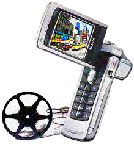
Mobifilms and Ringtone Vending Machines
"Nokia is offering five online lessons in making movies for mobile phones. [Via Picturephoning]. And “Ireland will be the first European market to see a new generation of coke-vending machines, which will also sell mobile phone top-ups, ringtones and music. UK-based Inspired Broadcast Networks has signed a deal with Coca-Cola to distribute digital content from its soft drink vending machines. The vending machines will be linked to Inspired's online content management system using DSL broadband connections. The content will be transferred to the purchaser's phone through their mobile operator's network, or may also be transferred directly to the phone using Bluetooth. In the future, the company plans to allow people to collect their content by plugging their phones' memory cards into a drive on the coke machine.” [The Register]" [blogged by John on Ratchet Up!]
Posted by jo at 12:08 PM | Comments (0)
The Hunt for Mr. X:
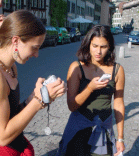
Bringing a Board Game to the Street
"Scotland Yard" is a popular board game in Europe, where players have to catch Mr. X. Mr. X moves hidden through the streets of London. He has to show his location every 4th turn. The detectives know which kind of transportation he uses. With this information they have to figure out his position and surround him. When the detectives catch him, they win, if Mr. X escapes he wins.
Bringing the game to the street: transformation into a live action game 4 groups with 4 players hunt Mr. X and Mr. Y in the old city of Berne. Hunting by MMS: Every ten minutes, Mr. X sends a picture of his current location. The detectives have to identify the position by the pictures and find Mr. X. They catch Mr. X by taking a picture of him." From "The Hunt for Mr. X: Bringing a Board Game to the Street [PPT] by Niklaus Moor (Swisscom Innovations). [via techkwondo] [Related]
Posted by jo at 11:51 AM | Comments (0)
the Space Between the Physical and the Virtual
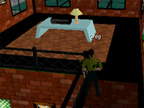
Cognitive Agents in 3D Virtual Worlds
"Abstract: We present an agent-based model of virtual worlds in which the objects in the world have agency, that is, the objects can sense their environment, reason about their goals, and make changes to the environment. The agent-based model has the following reasoning processes: interpretation, hypothesizing, and action activation. This agent model is described and illustrated using a wall agent in a multi-user virtual world. We extend the illustration through a demonstration of a multi-agent world in which many of the objects in the world interactively reason about the use of the world and respond specifically to the people in the world." From Cognitive Agents in 3D Virtual Worlds by ML Maher, JS Gero, G Smith, N Gu, University of Sydney, Australia; International of Design Computing, Vol 6, 2003.
Also: Interfacing Virtual & Physical Spaces through the Body: The C y b e r P R I N T Project

"Abstract: The cyberPRINT is a fully immersive, interactive virtual environment that is being generated in real time based on physiological data readings of a human body. In other words, the cyberPRINT is based on creating interfaces between physical and digital spaces and between biology and information technologies. The cyberPRINT is also an event, wherein a performer is connected to the cyberPRINT generator to create a self-sustaining feedback mechanism. Although the use of the body to electronically drive music and media events is not new, most of these works have paid little or no attention to the potential of interactive 3D virtual environments. Nor have they been so technologically advanced, interdisciplinary intensive (involving Architecture, Choreography, Modern Dance, Music, Bioengineering, Medicine and Computer Science), or architecturally focused as the cyberPRINT.
This project covers a wide and fertile territory that goes from the very technical and design oriented to the very theoretical and interdisciplinary. This paper is intended to (1) expand what has been already published about this project (Bermudez et al 2000a) and (2) establish potential areas for discussion before and after the performance."
1. Introduction: Why a Live Performance?
This paper provides background for the live performance of the cyberPRINT, a real time, physiologic data-driven virtual architecture developed by an interdisciplinary team led by two architects during the past 5 years. The reason for this live performance and demonstration is simple. It is only through performance that we can show the true nature of the cyberPRINT. Such demonstration will also provide empirical proof of the theoretical claims and technological details already published elsewhere (Bermudez et al 2000a). In addition, this version of the cyberPRINT will add some novelties occurred since then (such as a new virtual world, data-driven music in real time, a navigational data-globe). Images of a live performance are shown in Figure 1. [via]
Posted by jo at 11:38 AM | Comments (0)
CuteXdoom
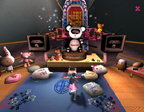
Society's Obsession with Fabricated Characters and All Things Cute
CuteXdoom is a mod for the PC game Unreal Tournament 2003 that explores society's obsession with fabricated characters and all things cute, or kawaii. The goal of CuteXdoom is to become a member of the toy worshipping Yumi-Co cult and gain access to their temple by collecting enough toys to present as an offering to the robotic panda guru. (This sort of exploration of society's addiction to cuteness reminds me of Satoshi Kon's compelling anime series Paranoia Agent, which can be seen in the U.S. on [adult swim].) Anyway anime referencing aside, CuteXdoom was created by Yumi-Co, a collective of game designers, illustrators, sound artists and coders that was founded by Anita Fontaine. She worked as the art director and designer for this project and currently works for the Mobile Digital Commons Network in Canada. She is also participating in the Toytakeova exhibit this fall in Australia. I really could go on and on, but I'll end it with this last plug: also check out some of the locative media projects she's worked on: Ghost Garden and Global Heart Rate. [blogged by Carol T Chung on Cool Hunting]
Posted by jo at 10:39 AM | Comments (0)
LIVE STREAMING Refresh!
![]()
Histories of Media Art, Science and Technology
"Recognizing the increasing significance of media art for our culture, this Conference on the Histories of Media Art will discuss for the first time the history of media art within the interdisciplinary and intercultural contexts of the histories of art. Banff New Media Institute, the Database for Virtual Art and Leonardo/ISAST are collaborating to produce the first international art history conference covering art and new media, art and technology, art-science interaction, and the history of media as pertinent to contemporary art."
Viewing: Since we have only a few places left to attend the conference in Banff we are web streaming live all keynotes, sessions and discussions from the site. Viewing the sessions in groups at Universities, Libraries, and Art Centers is encouraged, in order to facilitate local dialogue. Web streaming is available in Quick time and Windows Media. For optimal viewing on larger screens and for in-screen viewing of power point presentations, prior download of Windows Media is recommended.
Venue: September 29 - October 1, Banff New Media Institute, Canada CONFERENCE PROGRAM with streaming times.
Program:
29. September 05
GMT 15:30 h/CANADA 8:30 am: keynote Edmond Couchot: Towards the Autonomous Image.
16:30h/9:30 am - opening plenary - MediaArtHistories: Times & Landscapes 1 (Chairs: Oliver Grau and Gunalan Nadarajan)--After photography, film, video, and the little known media art history of the 1960s-80s, today media artists are active in a wide range of digital areas (including interactive, genetic, telematic and nanoart). Media Art History offers a basis for attempting an evolutionary history of the audiovisual media, from the Laterna Magica to the Panorama, Phantasmagoria, Film, and the Virtual Art of recent decades. This panel tries to clarify, if and how varieties of Media Art have been splitting up during the last decades. It examines also how far back Media Art reaches as a historical category within the history of Art, Science and Technology. This session will offer a first overview about the visible influence of media art on all fields of art. Speakers: Gunalan Nadarajan, Luise Poissant, Oliver Grau, Mario Carpo.
17:30h/11:30 am - plenary Methodologies, (Chair: Mark Hansen and Erkki Huhtamo)--Critical overview of which methods art history has been using during the past to approach media art. Speakers: Mark Hansen, Erkki Huhtamo, Irina Aristarkhova, Andreas Broeckmann.
21:10h/2:10 pm - plenary - Image Science and Representation: From a Cognitive Point of View (Chair: Barbara Stafford)--Although much recent scholarship in the Humanities and Social Sciences has been "body-minded" this research has yet to grapple with a major problem familiar to contemporary cognitive scientists and neuro scientists. How do we reconcile a top-down, functional view of cognition with a view of human beings as elements of a culturally shaped biological world? Historical as well as elusive electronic media from the vantage of an embodied and distributed brain. Speakers: Barbara Stafford, Kristin Veel, Christine Ross, Phillip Thurtle & Claudia X. Valdes, Christopher Salter, Tim Clark
12:25 h/4:25 pm - concurrent session 1 - Art as Research/Artists as Inventors (Chair: Dieter Daniels)--Do "innovations" and "inventions" in the field of art differ from those in the field of technology and science? Have artists contributed anything "new" to those fields of research? Speakers: Dieter Daniels, Chris Meigh-Andrews, Fred Turner, Simon Penny, Cornelius Borck.
Concurrent session 2 - MediaArtHistories: Times and Landscapes 2 (Chairs: Edward Shanken and Charlie Gere)--Although there has been important scholarship on intersections between art and technology, there is no comprehensive technological history of art (as there are feminist and Marxist histories of art, for example.) Canonical histories of art fail to sufficiently address the inter-relatedness of developments in science, technology, and art. Speakers: Edward Shanken, Charlie Gere, Grant Taylor, Darko Fritz & Margit Rosen, Sylvie Lacerte, Anne Collins Goodyear, Caroline Langill, Maria Fernandez
30. September 05
GMT 15:45 h/8:45 am - plenary Collecting, Preserving and Archiving the Media Arts (Chair: Jean Gagnon)--Collections grow because of different influences such as art dealers, the art market, curators and currents in the international contemporary art scene. What are the conditions necessary for a wider consideration of media art works and of new media in these collections? Speakers: Jean Gagnon, Christiane Paul, Peter Weibel, Jon Ippolito.
18:00 h/11:00 am - concurrent session 1 - Database/New Scientific Tools (Chairs: Rudolf Frieling and Oliver Grau)--Accessing and browsing the immense amount of data produced by individuals, institutions, and archives has become a key question to our information society. In which way can new scientific tools of structuring and visualizing data provide new contexts and enhance our understanding of semantics? Speakers: Oliver Grau, Rudolf Frieling, Sandra Fauconnier, Christian Berndt, Alain Depocas, Anne-Marie Duguet.
Concurrent session 2 - Pop/Mass/Society (Chairs: Machiko Kusahara and Andreas Lange)--The dividing lines between art products and consumer products have been disappearing more and more since the Pop Art of the 1960s. The distinction between artist and recipient has also become blurred. Most recently, the digitalization of our society has sped up this process enormously. In principle, more and more artworks are no longer bound to a specific place and can be further developed relatively freely. The panel examines concrete forms, e.g. computer games, determining the cultural context and what consequences they could have for the understanding of art in the 21st century. Speakers: Machiko Kusahara, Andreas Lange, Karen Keifer-Boyd, Tobey Crockett, Mark Tribe.
3:00 h /8:00 pm, Rudolf Arnheim Lecture: Sarat Maharaj: Xeno-Epistemics: Global Migrations and other Ways’ of Knowing.
1. October 05
GMT 15:30 pm/Canada 8:30 am - plenary - Cross-Culture - Global Art (Chair: Sara Diamond)--This panel provides an opportunity to put a special focus on cross-cultural influences, the global and the local. For example, how what are the impacts of narrative structures from Aboriginal and other oral cultures on the analysis and practice of new media? How do notions of identity shift across cultures historically, how are these embedded and transformed by new media practice? How does globalization and the construction of global contexts such as festivals and biennials effect local new media practices? Speakers: Sara Diamond, Sheila Petty, Mary Leigh Morbey, Thomas Riccio, Aparna Sharma, Laura Marks.
17:45 h/10:45 am - concurrent session 1; Cross Diciplinary Research Methods (Chairs: Ron Burnett and Frieder Nake)--The pressure to become interdisciplinary is very intense — coming from a variety of disciplines and institutions. Ironically, this pressure has been around for a very long time. So, why don’t we just strive for excellence irrespective of discipline? Don't the artistic practices within the field of New Media push us in that direction anyway? Speakers: Frieder Nake, Ron Burnett, Dot Tuer, Guy Sui Durand, Michael Century, David Tomas, Will Straw
Concurrent session 2 - Rejuvenate: Film, Sound and Music in Media Arts History (Chairs: Douglas Kahn and Sean Cubitt)--During an earlier period of new media arts discourse, time-based media were often considered to be “old media." While this conceit has been tempered, we still need to consider the sophistication and provocation of film, sound and music from the perspective of media arts history. Speakers: Douglas Kahn, Sean Cubitt, Keith Sanborn, Scott Bukatman.
20:45 h/1:45 pm; keynote Lucia Santaella: The Semiosis of Media Art, Science and Technology.
21:45 h/2:45 pm - Concurrent session 1 - Collaborative Practice/Networking History (Chairs: Ryszard Kluszczynski and Diana Domingues)--In a network people are working together, they share resources and knowledge with each other - and they compete with each other. This process has sped up enormously within a few decades and has reached a new quality/dimension. The dataflow created new economies and new forms of human communication. Speakers: Ryszard Kluszczynski, Diana Domingues, Nina Czegledy, Todd Davis, Douglas Jarvis, Jeremy Turner, Margaret Dolinsky.
Concurrent session 2 - What Can the History of New Media Learn from History of Science/Science Studies? (Chair: Linda Henderson)--Science and technology have been an important part of the cultural field in the 20th century, and the history of science and science studies - along with the field of literature and science - offer important lessons for art historians writing the history of new media art. Speakers: Timothy Lenoir, Linda Henderson, Timothy Druckrey, Simon Werrett, Yann Chateigné.
12:00 am/5:00 pm - Concurrent session 1 - High Art/Low Culture - the Future of Media Art Sciences? (Chair: Karin Bruns)--The panel aims to bring together the methodological fields of media studies and media art history. Rather than limiting their focus to canonical works of art new studies in media art production blend methods and issues from art history and media sciences as well as from communication studies, sociology, techno sciences, art history, cultural and postcolonial studies. Speakers: Karin Bruns, Yara Guasque, Andy Polaine, Claus Pias, Barbara Paul.
Concurrent session 2 - History of Institutions (Chairs: Itsuo Sakane and Jasia Reichardt)--There are inevitable parallels between the development of what we now call media art and life at large. Excess of information leads to insecurity — what to believe, what to select, what to keep and what to discard. Sustainability, conservation, education and access are topics relevant to today's media art, and as relevant to it as to our natural resources. Now that media art has a history, how do we keep track of it and preserve it? Speakers: Itsuo Sakane, Jasia Reichardt, Michael Naimark, Peter Richards, Johannes Göbel, Andreas Broeckmann (Discussant).
Posted by jo at 10:08 AM | Comments (0)
Troika Ranch
![]()
Live-I Workshop
New York City based dance theatre company Troika Ranch returns to FACT to present its live Interactive (Live-I) workshop, an intensive seminar for artists and advanced students who want to explore the use of interactive computer technology in the creation and performance of dance, theatre, and related live artworks.
Led by composer/programmer Mark Coniglio and choreographer Dawn Stoppiello, Artistic Co-Directors of Troika Ranch, the workshop gives the participants the opportunity to experiment with technological tools that allow their gestures and vocalizations to interactively control video, sound, light and other computer controllable media.
The three day workshop at FACT will serve as an intensive introduction to the software and hardware, with special emphasis on Isadora®, the real-time media manipulation software created by Coniglio. This work will be complemented by critical discussions regarding how the use of media and technology shapes the form and content of the artwork.
FACT, Liverpool; 31 October - 2 November 20053 days, 10.30 - 5pm, cost £105 + VAT.
Posted by jo at 10:00 AM | Comments (0)
Trampoline
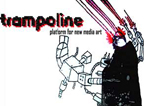
Final Call for Submissions
Trampoline is dedicated to the promotion of new technology art and artists and aims to present cutting edge art in an informal atmosphere; encouraging new artists to exhibit work to a real audience, whilst providing a platform for established artists working in new directions. Trampoline began life in 1997 as Nottingham's first ever platform event for new media art.
This one day/night event is based in Broadway Media Centre, the creative hub of Nottingham. The facilities/spaces which Broadway has to offer include: large lively bar/café space, a smaller bar space, foyer, cinema screens and projection onto the outside of the building.
In the two forthcoming events we hope to expand the reach of Trampoline, no longer restricting it to one venue but encouraging participating artists to explore the potential of public spaces around Nottingham too.
October Trampoline – in conjunction with PLAN. This Trampoline event will focus on locative and pervasive media. There will be an examination of how new media is entering the fabric of our everyday lives, installing itself into to every part of our environment, the new dimension of our reality, the dimension of data. Site will also be a particular concern, in order to investigate notions of locative and pervasive media more fully we would encourage artists not only to consider the space of Broadway cinema as the site for their proposed work but to also examine spaces beyond this, in particular public spaces around Nottingham. Extended Deadline for Submissions: September 23rd
1st December Trampoline – Opening event for Radiator Festival December’s Trampoline event will reflect the core concern of the Radiator Festival this year, the relationship between performance and new technology. How can the body and new media connect with each other? We are calling for work that not only investigates the relationship between the performer’s body and new technology but also the body of the viewer, the audience. Deadline for Submissions: November 7th
We encourage proposals of work in all formats, as long as they reflect upon elements of new media. Video, installation, performance, web art, computer programmes, music and more are all welcome. We would also like to encourage initiatives which give the Trampoline audience an insight into the workings of new media and an opportunity to develop their own small creative works, for example in the format of workshops/group activities.
If you have any queries please contact Emma Lewis, Trampoline Coordinator emma[at]trampoline.org.uk +44 (0)115 9559956
Download an application form, and send submission material to: Trampoline Submissions Broadway Cinema 14 - 18 Broad Street Nottingham NG1 3AL UK (include stamped addressed envelope if you wish your material to be returned).
Posted by jo at 09:54 AM | Comments (0)
B!AS International Sound Art Exhibition
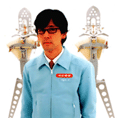
My Substitute Life
The B!AS International Sound Art Exhibition focuses on 'the various changing states of sound in modern environments, with lifestyles directly replaced by sound wave frequencies being the natural composite of harshness, authority, vulgarity and ambiguity.' Okaaay, let’s unpack that! Curated around the theme, 'Life Substituted: Sound Wave Frequency,' the show's contributors use sound to isolate and intensify distinct aspects of society and our position within it. For example, Maywa Denki's 'Switched On Kappa 2005' is a live performance that the artist calls a 'product demonstration,' involving fish-motif nonsense machines, original musical instruments, and flower-motif objets d'art. Christina Kubisch's 'Bird Tree' brings nature and technology together in an interactive installation that allows the visitor to receive and mix sounds via a wireless headset. Incorporating emerging and established artists, the show offers new media approaches to art-making that should stimulate new questions: How does the privileging of sound create fresh discourse around traditional visual art? Does this project complexify or dumb down notions of identity, place, and dialogism? Is bricolage the new aesthetic? Opening on 24 September and running through 20 November, it’s definitely worth a look. Or a listen. - Peggy MacKinnon, Net Art News, Rhizome.
Posted by jo at 09:32 AM | Comments (0)
Karma Physics< Elvis
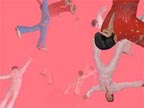
Game Character Death
Karma Physics< Elvis, by Brody Condon, is a modification of the first person shooter computer game Unreal 2003. As the viewer camera floats through a pink afterlife, twitching multiples of Elvis are controlled by the original game's "Karma Physics" real-time physics system - generally used to simulate realistic game character death. Video.
Among Condon's work are also Waco Resurrection (blogged previously) and Suicide Solution, a DVD documentation collected over the last year of committing suicide in over 50 first and third person shooter games. Video. Some of his works will be part of Game Paused, a book, DVD, and exhibition to be held in London, Nov 3-13th. You can still submit your work. Participating artists include Roger Ibars, ////fur///, Julian Oliver, Cory Arcangel, etc.
Via Jonah Brucker-Cohen who's also made an interview of someone I like a lot on gizmodo. Roger is also showing works at My World, New Crafts, Experimenta Design 05, September 18th - October 30th 2005. [blogged by Regine on we-make-money-not]
Posted by jo at 08:46 AM | Comments (0)
Net Worth
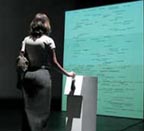
How Great is Your Net Presence?
The Internet is now the primary aggregator, disseminator and communicator of information. Individuals with greater net presence are deemed more significant. Net Worth explores a new value system for our information dependent society.
The visitor is invited to swipe one of their purchase cards in a kiosk with a magnetic card reader that stands in front of a monolith-like structure. The name contained on the magnetic stripe of their payment card is parsed and googled. The number of hits returned from the search is represented by positioning or ranking their name on the projection. Their name appears on the projection among others who have swiped as well as celebrities (whose names were fed into the system not only as a litmus test for the visitors but also as a reflection of our social condition: who has more Google hits Paris Hilton or William Shakespeare?)
The result is full of hits corresponding to people who happen to have the same name, but here the projected name is perceived as a true embodiement of the visitor.
Net Worth explores current conditions where information is given more prominence than the corporeal. The work also examines individuals' narcissism and hubris, much like carnival hammer hit games where physical muscle was tested, Net Worth gives chance for visitors to flex their data bodies.
By Osman Khan (see also one of his other works: Sur la table). Design Distinction in the Concepts Category in I.D. Magazine's 51st Annual Design Review. [blogged by Regine on we-make-money-not] [Related]
Posted by jo at 08:33 AM | Comments (0)
September 18, 2005
Glowlab News
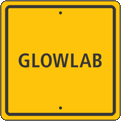
GLOWLAB.04 :: FORGOTTEN and more
GLOWLAB.04 :: FORGOTTEN--Our latest issue is now online, and features some great new projects by Glowlab and guest artists, including:
:: kanarinka--12 Inches of Weather; Weather experiments on the body :: Sharilyn Neidhardt --Into the Groove; Interview with musician and audio archivist Steve Espinola :: Emily Conrad--Lost Phone: 18,900 Google Entries; Lost phone in the back of New York City taxi. Last Friday, around 1am. It must happen all the time :: Sal Randolph--whereyouare; Join in documenting the endangered, lost, or ephemeral beauties of your neighborhood. whereyouare is a participatory experiment, mixing collaborative multimedia, folksonomy tags, and rss feeds to build a portrait of places that matter to us :: Holly Tavel--Xanadu Revisited; Two years on, Xanadu gives up the ghost.
With special guests: Leah Dilworth :: Lost and Found at the City Reliquary; Tour the City Reliquary, Brooklyn's store-front museum dedicated to civic pride and all around good neighborliness; Tianna Kennedy :: On Forgotten, Neglected, and Discarded Objects and Subsequent Utopian Projects Or, the Meandering Story of EV, which recounts the amusing first sally of the ingenious crew as they dragged a thing that had been forgotten from the Bronx to the Lavender Lake; Michele Gambetta :: The Rider Project 2005; The RIDER Project has been created by artists who rent a Ryder Company truck, retrofit it with walls, gallery lights, a generator for electricity, and create a mobile gallery to display art throughout N.Y.C.; Petr Kazil :: Urban Spooklights; Who wouldn't get excited by the appearance of a mysterious light in the distance - in a place where no light is expected?
Glowlab: Open Lab, curated by Christina Ray: A nine-week-long psychogeography festival and exhibition; October 14 through December 11.
Please join us this fall as we head up to Boston for our show at Art Interactive, a non-profit arts space dedicated to contemporary, experimental and participatory artwork.
In Fall 2005, Art Interactive is conducting a nine-week-long experiment. We have invited artists affiliated with Glowlab, a network of psychogeographers, to use the Central Square neighborhood as the site of their research and fill the exhibition space with the results of their investigations. PSYCHOGEOGRAPHY, a term coined by the Situationist International in the 1950s and appropriated by contemporary artists, is used to describe projects that produce affect in relation to the geographic environment. Rather than making maps in the traditional geographic sense, these artists utilize maps and geography to conduct located experiments with (among other things) people, trash, bikes, clothes, the sky and the gallery space itself. Often making use of mobile technologies and existing in the hybrid spaces of the Internet and the physical world, their projects produce new understandings of location and identity as shifting, fluid, singular and irreducible.
Central Square, Cambridge, MA, will never be the same again. Join us for nine weeks of public walks, talks, tours, workshops, concerts, group bike rides, and other ways of exploring the Central Square neighborhood. Each weekend of the festival, different Glowlab artists will be present to lead participatory public events inside and outside the Art Interactive space. Visit the online schedule at http://www.artinteractive.org/calendar for more details about upcoming events or email info[at]artinteractive.org.
Opening Reception: Friday, October 14th, 2005, 6 - 9pm
Gallery Hours & Location: Art Interactive is open Saturdays and Sundays from 12 - 6pm or by appointment. The gallery is located at 130 Bishop Allen Drive, at the corner of Prospect Street in Cambridge, MA. For more information, please contact info@artinteractive.org, call 617-498-0100 or fax 617-498-0019. Press release with downloadable press kit:
http://www.artinteractive.org/shows/glowlab/glowlab_press.html
Posted by jo at 10:21 AM | Comments (0)
September 17, 2005
The Upgrade! International
![]()
SHOW::GATHER::SHARE
Thanks to all the artists and curators who contributed to this event. Please join us next week to meet the highly-motivated group of artists/curators who organize the gatherings in different locations around the world (soon in Toronto, Istanbul and Sofia). The gatherings are often associated with art & technology centers. By default this emerging network sustains open communication lines between these nodes. We're meeting to develop a vision as a global network to highlight the creative work done in the field.
Show: September 16-24, 2005--Documentation of works by 131 artists who participate at Upgrades! around the world. Representing: Boston, Chicago, Montreal, Munich, New York, Oklahoma City, Scotland, Seoul, Tel Aviv, Vancouver.
Gather: Friday, September 23: 7:30-9:00 pm--Sala-Manca Group performs Elephants on Metula's Nights and discusses their practice at our monthly gathering. The Sala-Manca Group is comprised of Lea Mauas and Diego Rotman, Argentine-Israeli artists who have been creating work in performance, video, installation and new media since 2000. Sala-manca's works deal with the poetics of translation, Yiddish culture, the tensions between low-tech and high-tech aesthetics, as well as social and political issues.
Share: Saturday, September 24: 12:00-7:00 pm--How does each Upgrade form its presence and community? What is the potential of the network? Join artists, curators and organizers for two panels, lecture and party.
12:00 pm: Introduction and welcome.
12:10 pm: The New York Upgrade! story with media artist Yael Kanarek and director of education at Eyebeam Liz Slagus.
12:45 pm: Artist-Run Upgrades! with Tiffany Holmes, Chicago; Tamiko Thiel, Munich; Adam Brown, Oklahoma City; Mushon Zer-Aviv and Sala-Manca Group, Tel Aviv; Kate Armstrong, Vancouver. Moderated by Yael Kanarek.
2:45-3:15 pm: Break
3:15 pm: Art + Tech Organizations Upgrades! with Jo-Anne Green and Catherine D'Ignazio, Boston; Cezanne Charles and Robb Mitchell, Scotland; Suhjung Hur, Seoul; Tobias C. Van Veen, Montreal. Moderated by Liz Slagus.
5:15 pm: "NETWORKS, AGENCY, PROPERTY and POLICY: Practical thoughts on the emergence of new global cultural formations" — closing talk by leading scholar of media arts Michael Century.
6:00 pm: After-party with music by artist/DJ Tobias C. Van Veen.
The Upgrade! is an international network of monthly meetings in the field of art and technology.
Eyebeam
540 w 21st Street between 10th & 11th Avenues
Hours: Tues–Sat, 12:00–6:00pm
Bookstore: Tues–Sat, 12:00–6:00pm
Admission: All events are free to the public unless otherwise noted
info[at]eyebeam.org
Eyebeam supports the creation, presentation and analysis of new forms of innovative cultural production. Founded in 1996, Eyebeam is dedicated to exposing broad and diverse audiences to new technologies and media arts, while simultaneously establishing and demonstrating new media as a significant genre.
Eyebeam's programs are made possible through the generous support of Atlantic Foundation, the Andy Warhol Foundation for the Visual Arts, the National Endowment for the Arts, Time Warner Youth Media and Arts Fund, Alienware, the Jerome Foundation, the Helena Rubinstein Foundation, the Greenwall Foundation, the New York State Council on the Arts, a state agency, the New York City Department of Cultural Affairs, the David S. Howe Foundation, the Lerer Family Charitable Foundation, the Sony Corporation, Alias Systems, Inc. and the Milton and Sally Avery Foundation.
Posted by jo at 10:39 AM | Comments (0)
PLACE: Location and Belonging in New Media Contexts
![]()
Call for Contributions
PLACE: Location and Belonging in New Media Contexts, by Danny Butt, Jon Bywater and Nova Paul (Editors): James Clifford notes that "land" (whenua, ples, country, la tribu, etc.) signifies the past in the future, a continuous, changing base of political and cultural operations - while a political theory "which sees everything as potentially realigned, cut, and mixed, has difficulty with this material nexus of community". Indigenous epistemologies have sophisticated structures for negotiating belonging among communities who may become widely dispersed from their homelands. New media, by contrast, demonstrates biases toward the dislocated: a cosmopolitanism implicitly located in the urban, where communities form and fragment in "virtual" environments.
However, questions of belonging and identification remain for those who use new media networks. Knowledge in the new media environment may circulate rapidly, but it is still located in human subjects who develop knowledge and identification within physical and social locations. The aim of this publication is to directly address silences within new media discourse on place, as well as understand how long-held attachments to place are transforming in the contemporary media context.
We currently have interest from international academic publishers in a book on these issues to be published in coordination with the Cultural Futures: Place, Ground and Practice in Asia Pacific New Media Arts symposium in Auckland, December 2005. We are also interested in soliciting writing from those not attending the event, including work outside the regional focus of the symposium.
Themes that may be addressed in the publication include:
Place-based new media practices
Migration and movement
Indigeneity and colonisation
Home and belonging
New media and cultural transformation
Globalisation and cosmopolitanism
Local activism and social change
Abstracts of 500 words, along with a 200 word bio should be sent to info[at]culturalfutures.place.net.nz by October 14th 2005. We expect to notify authors by the end of November 2005, and require chapters to be completed by the end of February 2006, with the book to be published later that year. We also intend to issue a further call for images and pageworks in the future.
Please direct any enquiries to Danny Butt: danny[at]dannybutt.net
Posted by jo at 10:22 AM | Comments (0)
September 16, 2005
Wireless London

Addressing Creative Possibilities
In the last five years usage of wireless networks worldwide and in the UK, especially in London, has grown enormously. Community networks, commercial providers and public sector initiatives have been turning to this now-generic technology to provide themselves with local, low-cost networks. As this technology hits the mainstream, expanding the potential scale and utility of these networks, Wireless London addresses the creative possibilities, policies, practicalities and potential of Wireless London.
We see that mobile, pervasive computing will fundamentally change how we work, play and communicate. We want to be able to modify that environment creatively, adapting and customising it as a public space. By researching and developing open systems and tools, and providing models for how these technologies can be deployed, we aim to create a demand for high technical and social standards by raising people's expectations and understanding. See Wireless London: NodelSoftArchitecture...
Posted by jo at 10:44 AM | Comments (0)
The Knitting Map

Knitted Cartography
The Knitting Map is a fabric art and technology project that aims to take the pulse of the city of Cork (Ireland) during 2005 and translate that information into a live knitting map. Above the earth there is a satellite which looks down at Cork (Ireland) and watches the movements of people and cars around the city. Down in the hub, small cameras watch the city in detail and meteorological equipment tastes the weather. All of the data coming needs to be distilled into two simple numbers: one representing stitch (pattern) and the other colour.
There are 25 knitters, so information must be varied slightly between each knitter to give the overall textile a more subtle and complex hue. Knitters work in relay, the strips sewn together to form a single vast document of the city. Before each of them, a small digital screen details the next few lines of knitting and they lean forward to advance the pattern. During the day, people arrive to view the installation. By performance company half/angel. Pictures. Part of Cork 1005, Capital of Culture. [blogged by Regine on we-make-money-not]
Posted by jo at 10:30 AM | Comments (0)
Grand Finale_Yellow Arrow:
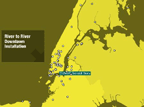
The Secret New York
Yellow Arrow: The Secret New York is a public art project that celebrates the extraordinary details of the city that often pass unnoticed. Upon encountering a Yellow Arrow, the public participates by calling 212.201.2005 from mobile phones to hear an audio message that tells a secret story about the location where the arrow points.
This Saturday marks the Grand Finale with 20 Yellow Arrow sculptures visible across Manhattan and Brooklyn from 12-8 pm, at places like: Union Square, Chinatown, The Lower East Side, East Village, Lower Manhattan, Williamsburg and DUMBO. This is is a fantastic opportunity for people to experience some of the most compelling content of the summer in one single day.
Over the summer the project has touched a lot of people in all 5 boroughs and there are some very fun stories about bringing it all together. Creators of the project will be leading two behind-the-scenes tours to share these anecdotes and insights. Tour 1_Lower Manhattan meets at Battery Park at 12 pm and will visit 5 nearby Yellow Arrows. Tour 2_East Village meets at corner of Ave. B and E. 7th St. at 6:00 pm and will visit 6 Yellow Arrows, grab dinner in the area and head to the after-party.
The day-long installation and tours will be followed by a celebration at the Lotus Lounge (35 Clinton St at Stanton), with drink specials, video projection and a sound installation on the street.
Grand Finale, Downtown Manhattan, Williamsburg and DUMBO; 12-8 pm; Full map available.
Tours:
Tour 1_Lower Manhattan 12 pm at Battery Park
Tour 2_East Village 6 pm at corner of Ave. B and E. 7th St
Grand Finale Party--Lotus Lounge, 35 Clinton Street at Stanton, Lower East Side, Manhattan.
Posted by jo at 10:22 AM | Comments (0)
An Interview by Ryan Griffis
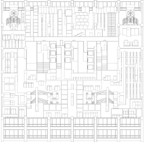
Tandem Surfing the Third Wave: AUDC and the Disappearance of Architecture
Note: This interview, conducted by email during 2004-5, is a discussion with Kazys Varnelis and Robert Sumrell, of the LA-based AUDC (Architecture Urbanism Design Collaborative). AUDC produces published texts, multimedia installations and a collaboratively-produced wiki, all of which present their efforts at creating 'conceptual architecture.' One of their more extensive projects, 'Ether,' (http://www.audc.org/projects/index.php/Ether) uses photographs, magazine articles, and even a Sims mod to follow a complex narrative involving real estate, telecommunications and cultural mythology as they coalesce at the site of LA's One Wilshire Building. As an extension of my Tandem Surfing series of interviews with media arts collectives, I wanted to speak with AUDC about their experiences navigating the disciplinary boundaries of new media, history, architecture, and art.
Ryan Griffis: How and why did AUDC begin?
Kazys Varnelis: AUDC began at the Southern California Institute of Architecture, in 2001, where I was teaching history-theory and Robert was a graduate student. We found working together immensely productive, a process that allowed us to step into each other's territories. Advising Robert on a design thesis (on the web at http://varnelis.net/projects/muzak/index.html) allowed me to work creatively while, as my teaching assistant, Robert worked with theory and research more directly.
We formed AUDC to keep this going. Initially, we had naive thoughts that we might be a consultancy or design practice like Rem Koolhaas's AMO, but with the implosion of the 90s economic boom and with AMO's now-inevitable degeneracy into making cute proposals about moving the Charles River to accommodate the Harvard Business School, it became clear to us that this was the last thing that anyone needed.
Instead we looked to groups like Archizoom and Superstudio for inspiration. If, in the mid-1990s, architecture had been too caught up in a disciplinary posturing masquerading as resistance, by 2001, it was clear that the interest in Deleuzean smoothness and in working with capital had run its course. More than anything, we thought, we could use the unique ways of thinking inherent in architecture as a form of research while history could be revealed to be a form of design itself.
As a collaboration, AUDC works with both of our strengths. Robert builds drawings and models, and I take photographs and code the web site. Through the use of our wiki software (http://audc.org/projects), we are able to collaborate on our texts. The writing on our website is written neither by Robert nor myself but by the two of us.
Robert Sumrell: Working collaboratively helps us to expand our interests and test ideas from multiple perspectives. Kazys's background lies in the History of Architecture, Urbanism, and Telecommunications, while I spent time in Comparative Religious Studies and Interior Design. When our interests and knowledge bases overlap (B'ro Landschaft or post-1960 Italian design, for instance) we investigate these questions from a variety of schools of thought, and not just from our shared experience in architecture school.
Working collaboratively also helps us to avoid comfort zones and familiar logic. There are few topics of conversation in most architecture schools, and the terms used to investigate them are exhausted. Even the youngest students are already hip to the game, rolling their eyes and playing along as someone spends an hour rambling on about nonsense like "programmatic indeterminancy" or "interstitial space." Most architecture schools are reactionary, dealing with their backwardness by limiting research to ever-more proscribed themes. We want to do the opposite: open up new areas of research.
RG: To give readers a better understanding of AUDC's work, I'm wondering if you could talk about one of your current projects. Maybe the Quartzsite work?
KV: Quartzsite, Arizona is a town of 5,000 residents in the summer, located 180 miles from this site. Situated along I-10, some fifteen miles from the California border, every winter Quartzsite swells with an influx of snowbirds, campers from across North America, generally escaping the cold northern climate in search of sunshine, the solitude of the desert, and the company of like-minded individuals. According to the Bureau of Land Management and the Quartzsite Chamber of Commerce, up to 1.5 million inhabitants settle in town every winter, bringing their lodgings with them, in the form of recreational vehicles or RVs. At any one time in January and February, hundreds of thousands of residents make this remote desert town into a substantial urban center.
Quartzsite fascinates us because it's a kind of living parable for the contemporary city. It is void of any qualities and has no higher aspiration. There are mall-like shopping spaces and residential compounds, but there is no public space. Production is non-existent. Instead, Quartzsite is a city of trade, consumption, and tourism. It's a place in which individuals go to get away from their neighbors and to become individuals, but it's also a place of incredible density where RV is packed cheek-by-jowl with RV.
AUDC's installation for the 2004 High Desert Test Sites (http://www.highdeserttestsites.com/) reproduces Quartzsite in the patch of desert through a series of thirteen signs, each containing a scene from Quartzsite. The number on each sign corresponds to a number on the map on the back-side of this page. You may visit the signs geographically or you may visit them numerically. Visited geographically, the signs allow you to meander through the topography of this site as you come to an understanding of the lay of the land in Quartzsite. Read in numeric order, the signs form a narrative explaining the history of Quartzsite, as well as providing a sociological and anthropological reading of the community as it is today.
The project also exists, as does all our work, on the web (at http://www.audc.org/quartzsite). So even though you should go to the site itself, you can also go to the High Desert Test Sites site, or to the website. Each site (site/nonsite/website) is distinct, however, and brings with it its own experience. So in the HDTS version, you begin to experience not only Quartzsite but also the silence of the desert. On the web, we hope you begin to explore linear and non-linear processes and the interaction of this space with more distant ones.
RG: I'm curious about the decision to utilize the kinds of cultural spaces that exhibit "Art." There is a great contradiction that seems to be gaining some momentum in shows like "the gardenLAb experiment" (http://www.rhizome.org/thread.rhiz?thread=14740&page=1#28146) and "the Interventionists" (at MASS MoCA), where the art is being made by people with large personal investments outside of the artworld and its usual concerns, yet it hardly represents what one could call "outsider art."
RS: Few stable public venues sponsor speculative research projects and installations. Because of this, not many people know that they exist or have any experience approaching them. Our projects don't overtly refer to a product, a sponsor, a design method, or a solution. In the absence of any of these conditions, the art gallery/museum has become an important forum for AUDC because it consistently looks for work which is difficult to categorize and will generally display it in a generic space without insisting on the participants' adherence to a specific format. There's nothing better than the white cube is there? The museum/ art gallery is one of the few remaining places where people gather specifically for the purpose of concentrating on and interacting with projects (many of which they do not anticipate immediately, or perhaps ever, fully understanding). It is the steady influx of these patrons that we are really after, not the "gallery installation" itself. AUDC has also undertaken and tailored projects for books, magazines, and the web. Installations, however, are capable of presenting complex ideas through a combination of media working together. It is the practice of art as a history of forms of presentation that interests me and informs our work. This applies equally well to the designs of trade exhibits, world's fair pavilions, and history museums.
KV: What we're seeing is a final transformation of the institution of art. On the one hand, the art museum and gallery have finally fulfilled Robert Smithson's prophecy to become discotheques. Most of the contemporary work in art venues, today, is some form of kitsch. If it provokes a smile or stimulates a gag reflex, it wins an award. There is no discernible project in contemporary art, today. As Alain Badiou says of contemporary art, when everything is possible, nothing is possible. There are no attempts to push boundaries or to create new possibilities, only to realize and endlessly retread existing ones.
But we shouldn't be surprised about this. Art is a thing of the past. It is exhausted as a form of practice. For us, the interesting thing is not to condemn that condition but to take advantage of it. The academy, with its requirements of tenure, is still a narrow place. Ultimately that's a good thing, discipline instills a certain honesty and a need to focus. So work like ours can't readily appear there. It is neither architecture nor architecture history, nor architecture theory, nor is it art. Being unclassifiable, it doesn't fit in the academy.
Instead, as our friend Julian Bleeker has said of his own project (techkwondo.com), art installations offer us a place to do what we can't do elsewhere. If the gallery provides us a venue, then we take it. If the academy, or for that matter, the shopping mall would provide a venue, we would take that. The same goes for the web. It is a venue. Once you fetishize these places, you're creating striated space and you're in trouble.
RG: Speaking of "speculative research," it seems quite a bit has been written about 'conceptual architecture,' lately--projects with no intention of being materialized beyond models. Peter Lunenfeld, in _Snap to Grid_ commented on Lev Manovich's assertion that computer graphics have "killed" architecture, saying that his dismissal of 3D space was a bit hasty. AUDC's projects seem to offer a different kind of "speculation" in that they seem concerned with analyzing architectural form in order to offer a critique of some kind, rather than generating theoretical possibilities for manipulating space and movement - there's a concern in your projects for pre-existing spaces.
KV: Our concern with pre-existing spaces stems from our belief that radical territorial changes are over, that form is obsolete as an object of research, and that the visual realm is of less and less importance, daily.
Territories are complete. You can add a Frank Gehry concert hall or two, but structurally speaking that's an updated version of Utzon's Sydney Opera House. Architecture makes its flourishes in the city core. This acts as an alibi to sprawl. Disney Hall is funded by Eli Broad, but that's the same Broad of Kaufmann Broad, now KB Homes, the largest builders of sprawl in the country. Disney Hall, Broad says, isn't penance, it's just what you do in the city while you build sprawl outside. What you will see is an environment that looks largely identical to the one we have now. Don't expect the city or the suburb to look radically different in the future. Instead, expect them to be augmented.
Look at it this way, even if you can use the Building Architect Tool or Urban Renewal Kit in SimCity, most people don't. For the vast majority of players, hours of fun can be derived from playing a game that consists of combining predefined structures in endless permutations. And although most SimCity games end with the city destroyed or the mayor thrown out, that doesn't seem to stop anyone.
RS: Architecture is not only too costly to construct, it has become incapable of acting as an agent for change. As a form of media, architecture addresses collective groups, or a society. We no longer live under these conditions and act, instead, as a fully-commodified collection of individuals.
Modernism and the avant-garde have become aesthetic choices. What then, is an interesting or radical position for the present time? It must somehow include an interest in the existing world and apathy toward its products. The old post-modern world of the seventies was a surface application of history as ironic or decorative elements in a flat eclecticism. It was never meant to bring back the past, instead it desperately tried to maintain the idea that all of those goods were behind us and to keep them at bay by making them odd objects in a greater whole still of the time. eBay, as a practice, has made this idea obsolete.
RG: Considering that "territories are complete," I'm wondering what you make of the work of other architecturally invested people, like Marjetica Potrc (http://www.potrc.org/project2.htm), that seem to be exploring a new kind of utopian program combining "green design" concepts with an engagement in globalization discourses.
KV: I appreciate any practice that strives to improve someone's quality of life. Marjectica Potrc tries to achieve this by making direct interventions in the city and producing work that illustrates the variety of conditions in which people live. But we cannot escape our own complicity and accountability within globalization, nor do we have the distance necessary to propose visionary alternatives. Andrea Branzi has stated that environmentalism is opposed to humanity. So is architecture. The building process is the greatest source of solid waste that civilization produces. As we mentioned earlier, AUDC was founded to produce buildings, but we grew past that. Conceptual architecture does not act in the world of goods, but on the assumptions that structure our relationship with the world itself. The production of physical forms is merely a source of fascination and novelty. I am much more interested in the United Nations guidelines for refugee camps and the temporary infrastructure continuously recreated in Quartzsite, AZ, than in the social space of Burning Man or the new Prada store. An investigation of the first two communities will bring about significant knowledge of urbanism while the latter two amount to little more than juvenile escapism.
+ http://www.audc.org/projects/index.php/Ether
+ http://www.audc.org/projects/index.php/AUDC
+ http://varnelis.net/projects/muzak/index.html
+ http://audc.org/projects
+ http://www.highdeserttestsites.com/
+ http://www.audc.org/quartzsite
Posted by jo at 09:46 AM | Comments (0)
Wind Array Cascade Machine
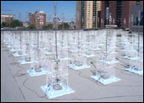
Si(g)n(e)
"Wind Array Cascade Machine (WACM)--by Steve Heimbecker--is a device that captures the wind's direction and movement and then streams the resulting data on the Web and uses them for installation projects. Thanks to the 64 motion sensors forming a grid of 8 units by 8 units, the system "maps" the wind in an outdoor space. Streamed on the Web, the data from the 64 channels are then processed by a computer program and assigned to installations that translate them into another form.(1)
The system has already spawned an installation, Pod, presented at the Mois Multi 2003 in Quebec City, as well as at the Subtle Technologies conference (2003) at the Interaccess centre in Toronto. During these two presentations, the sensing device was placed on the roof of the Méduse complex in Quebec City, and the data transmitted by the network were used to control a series of corresponding light emitting diodes (LEDs) placed on long vertical rods in an exhibition space.
Installed for a full year (2004-2005) on the roof of the Ex-Centris complex in Montreal, WACM powered the August 2004 Pod presentation at the Kiasma Museum of Contemporary Art in Helsinki, Finland, as part of ISEA 2004, as well as its presentation at Oboro in Montreal in November and December of the same year. The resulting luminous installation evoked a windswept field of wheat, thereby creating a visual analogy to express a natural phenomenon that is hard to perceive.
This system is similar to other devices created by artists integrating natural elements (for example, the wind and sun) into kinetic art. Yet Pod differs from this work in that the wind isn't used for its energy potential but rather because it describes a space by occupying and modifying it. Such projects are motivated by a fascination for natural phenomena, a desire to incorporate them into the creative process in order to link us to nature in technological contexts that sometimes exclude us and tend to distance us from our own organic condition.
In addition, Heimbecker is working on the project Si(g)n(e), a sound installation using the same system. To carry out this project, the artist is designing a sine wave generator with 64 channels, which will be controlled by a programming environment linked to a corresponding multi-channel sound system. The technology is being developed within a residency in cybernetic art at Vidéographe thanks to a program funded by the Foundation (2). Si(g)n(e) harks back to the many sound portraits of outdoor spaces produced by Heimbecker in the past." --S.P. © 2004 FDL [via]
Posted by jo at 09:12 AM | Comments (0)
September 15, 2005
Neighbornodes

Node Thy Neighbor
Neighbornodes are group message boards on wireless nodes, placed in residential areas and open to the public. These nodes transmit signal for around 300 feet, so everyone within that range has access to the board and can read and post to it. This means that with a Neighbornode you can broadcast a message to roughly everyone whose apartment window is within 300 feet of yours (and has line of sight), and they can broadcast messages back to you. Boards are only accessible from computers that go through the local node.
Additionally, Neighbornodes are linked together, making up a node network to enable the passing of news and information on a street-by-street basis throughout the wider community. With access to your local Neighbornode, you can post messages to your local group board, as well as forward messages to other nodes in your vicinity. These other nodes can in turn forward messages to your node, resulting in a network of neighborhood message boards. [blogged by Samuel Rose on Smart Mobs]
Posted by jo at 12:00 PM | Comments (0)
7th International Conference on Word & Image Studies:
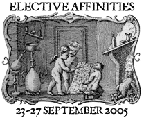
Elective Affinities
...This international conference will explore the relations between word and image from a range of interdisciplinary perspectives. Our title has been borrowed from Goethe's 1809 novel Elective Affinities. In the novel, the chemical term “elective affinities” extends to human relationships, both intimate and political. Like the alkalis and acids of which Goethe's characters speak, words and images, though apparently opposed, may have a remarkable affinity for one another. At the same time, as one of the characters in the book objects, such affinities are problematic, and “are only really interesting when they bring about separations.”
How words and images represent and whether they enjoy a harmonious kinship, engage in border skirmishes, or seek to annihilate one another, are not merely formal matters. The history of iconoclasm tells us about the ideological stakes of the debate. Contemporary discussions of memorialisation seem to demand multi-media expression, and urban inscriptions such as graffiti and mural arts express political positions. New technologies for meshing words and images – such as medical imaging, virtual archives, the Internet – will also be discussed. Among the themes of the conference are: the arts of the book; early correspondences; political inscriptions; sacred words, sacred images; scientific imaging; spaces, places; photographic texts. [via]
Posted by jo at 11:41 AM | Comments (0)
TECHSTYLE NEWS
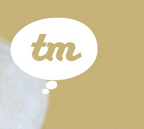
Issue #53 - September 15, 2005 [excerpts]
Techstyle News is a free monthly newsletter providing summaries and commentaries on stories related to the next generation of mobile technology and style, produced by Thinking Materials.
APPLE UNVEILS NEW WEARABLE MP3 PLAYER: Apple has introduced the iPod nano, a completely new iPod that’s thinner than a standard #2 pencil and weighs only 1.5 ounces. The iPod mini replacement is available in 2GB ($199) and 4GB ($249) capacities in either white or black designs. The ultra-compact device features a high-resolution color screen, Click Wheel, and offers up to 14 hours of battery life. Apple has announced several new accessories for the device, which the company calls the “most fashionable and wearable iPod ever.” The new gear includes lanyard headphones, which integrate the headphone cables into the lanyard; armbands in five colors, including gray, pink, blue, red and green; a set of silicone “Tubes” in five colors, including pink, purple, blue, green and clear; and dock.
PHILIPS SHOWS PHOTONIC TEXTILES: Philips Research has shown prototypes of its photonic textiles—fabrics that contain lighting systems and can therefore serve as displays. The researchers have managed to integrate flexible arrays of multicolored LEDs into fabrics without compromising the softness of the cloth. The LED substrates are also capable of displaying Windows Media Player-style visualisations and feature responsive sensors so that the patterns of diffused light displayed can change according to how they are handled.
SIRIUS ANNOUNCES NEW WEARABLE MUSIC PLAYER: Sirius Satellite Radio has unveiled its first wearable music player. The new device includes enough storage capacity for up to 50 hours of recorded Sirius content or audio files. Unlike XM's portable device, MyFi, Sirius's product will not be able to receive satellite signals on the go. Rather, it must be plugged into a docking station. The move comes as satellite radio players try to expand from the auto market. Both Sirius and XM have online streaming music services and "plug and play" devices that let users hook up to Sirius both in their cars and in their homes.
RESEARCHERS CREATE POWER BACKPACK: Scientists at the University of Pennsylvania have developed a backpack that can actually generate electricity as its wearer walks. The suspended-load backpack can generate about seven watts of power solely via the motion of the person carrying it, which is achieved by detaching the pack’s frame from the load it carries and harnessing the energy generated as the load moves up and down on vertical springs. The actual energy generated depends on the weight of the load and how fast the person walks, but is usually enough to charge several handheld devices at the same time. The pack is reportedly comfortable to wear, and doesn’t weigh significantly more than a conventional pack.
EVENTS
ISMAR 2005 IN VIENNA: Mixed Reality and Augmented Reality are highly interdisciplinary fields involving signal processing, computer vision, computer graphics, user interfaces, human factors, wearable computing, mobile computing, computer networks, distributed computing, information access, information visualization, and hardware design for new displays and sensors. MR/AR concepts are applicable to a wide range of applications. The International Symposium on Mixed and Augmented Reality, ISMAR, is the premier forum in this field and will be held in Vienna on October 5-8.
WICON AMERICAS IN SANTA CLARA: Wireless Connectivity (WiCon) Americas, to be held in Santa Clara on October 5-6, is the one stop shop for wireless connectivity solutions in the US. It's a high-level conference and exhibition to address leading wireless technologies such as Bluetooth, NFC, UWB, Wi-Fi, WiMax and ZigBee and the huge potential of the wireless networking applications they enable. The conference will focus on the convergence and co-existence of these technologies and their integration into mobile and computing devices. In addition the show will highlight some of the real life applications of these technologies in key vertical markets.
SIGDOC 2005 IN COVENTRY: SIGDOC 2005, to be held in Coventry on September 21-23, will provide an opportunity for the exchange of information related to exciting new research and empirical results in areas such as documenting mobile, pervasive and component-based systems, information design for delivery in a pervasive-computing environment, design for new communication media, culture and communities communicating in a pervasive environment, gathering and presenting information from pervasive computing networks and usability of information in a pervasive environment.
MOBILE HCI 2005 IN SALZBURG: MobileHCI provides a forum for academics and practitioners to discuss the challenges, potential solutions and innovations towards effective interaction with mobile systems and services. It covers the analysis, design, evaluation and application of human-computer interaction techniques and approaches for all mobile computing devices and services. The conference will be held in Salzburg on September 19-22.
CEATEC JAPAN 2005 IN TOKYO: CEATEC JAPAN is the largest international exhibition in Asia for the technology and electronics sectors, including the fields of imaging, information, and communications. Experience all the recent trends in IT and electronics, from technologies that showcase futuristic lifestyles to products that will be on store shelves during the upcoming winter season, including several new wearable devices. The fair is held in Tokyo on October 4-8.
Posted by jo at 11:05 AM | Comments (0)
MOBILE MUSIC TECHNOLOGY
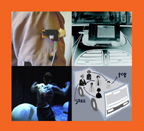
New Forms
THIRD INTERNATIONAL WORKSHOP ON MOBILE MUSIC TECHNOLOGY, 2-3 MARCH 2006, BRIGHTON, UK.
Combining mobile technology and music promises exciting future developments in a rapidly emerging field. Devices such as mobile phones, walkmans and iPods have already brought music to the ever-changing social and geographic locations of their users and reshaped their experience of the urban landscape. With new properties such as ad hoc networking, Internet connection, and context-awareness, mobile music technology offers countless new artistic, commercial and socio-cultural opportunities for music creation, listening and sharing. How can we push forward the already successful combination of music and mobile technology? What new forms of interaction with music lie ahead, as locative media and music use merge into new forms of everyday experiences?
Following two successful workshops that started to explore and establish the emerging field of mobile music technology, this third edition offers a unique opportunity to participate in the development of mobile music and hands-on experience of the latest cutting-edge technology. The programme will consist of presentations from invited speakers, in-depth discussions about the crucial issues of mobile music technology, hands-on group activities and break-out sessions where participants can get valuable feedback on their work-inprogress projects. The invited speakers include Michael Bull (University of Sussex, UK), often dubbed by the press as 'Professor iPod' for his iPod and car stereo user studies that reveal fascinating trends for mobile music.
The workshop will take place at the University of Sussex in Brighton, UK. Brighton is situated on the British 'Sunshine Coast' and easily accessible: only 30 minutes from London/Gatwick airport and 60 minutes from central London.
Don't miss this chance to help shape the mobile music landscape of the future!
CALL FOR PARTICIPANTS
We invite practitioners, artists, designers and researchers from all areas, including music, technology development, new media, sound-art, music distribution, locative media and industry to register for this international mobile music workshop.
CALL FOR WORK-IN-PROGRESS
Are you working on a mobile music project and looking for feedback from like-minded people to help you to move on with your ideas? We invite submissions of work-in-progress projects exploring the topic of mobile music. Projects will be discussed, receive critical review as well as support with ongoing problems and issues. Your work should not be completed yet, but either be on-going or just about to get started. Potential projects could include but are not limited to mobile music systems or enabling technologies, interface design, on-going or planned user studies, ethnographic fieldwork, art pieces and other areas relevant to mobile music.
Submissions should include a presentation of the project, explain its relevance to the field of mobile music and describe issues and problems that could be discussed during the workshop. Please include a short biography with the submission. Accepted project authors will be given time to present and discuss their work and will receive feedback by smaller groups of workshop participants including specialists in the field. Authors are encouraged to bring material and prototypes to the workshop.
CALL FOR MOBILE PLATFORMS AND SYSTEMS
In addition to the presentations, discussions and project feedback sessions the workshop will also offer handson group activities to explore technological platforms. We are looking for mobile platforms, systems, installations, applications or devices that include music features or can be used for musical projects. The workshop participants will get hands-on experience with these platforms, so they should be suitable for groups of at least 8 people. This provides you with the opportunity to introduce your platform to experts and practitioners in the field of mobile music and to gain valuable feedback. We invite you to submit a platform description, explain how it can be used for mobile music and how larger groups can use it during the workshop.
Details are here.
Posted by jo at 10:33 AM | Comments (0)
Continental Drift Seminar - Webcast Details

Quick Notes About Webcast of Brian Holmes
We will stream live 4 sections of the Continental Drift Seminar. We will also subsequently post the webcasts online. Below you will find the url for the live stream. Please visit the website for checking the archived webcasts.
Live Stream: we will be webcasting [Quicktime 7.0+] the following sections of the seminar with in NYC time (EST): Thursday September 15 -- Session 1 -- 6:30 PM; Friday September 16 -- Session 2 -- 6:30 PM (w/David Harvey); Saturday September 17 -- Session 3 -- 1:00PM -5:00PM; Sunday September 18 -- Session 4 -- 1:00PM -5:00PM.
Participation via? For the people who will be participating from other locations. We ask you to formulate and send questions to us via email at
seminars@16beavergroup.org. We will attemt to create a space within the
context of the streamed times to actual answer some submitted questions.
Posted by jo at 10:25 AM | Comments (0)
Mediate
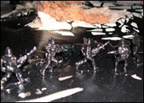
Modern Day Rites and Invigorating Spectacle
Mediate--by Brian Knoth (aka Theta State)--is a spiritually and socio-politically charged thirty-minute multimedia installation intended for alternative art spaces. Utilizing shamanic ritual as a conceptual backbone, a mixture of original music, video, performance art and mixed-media sculpture abstracts the transformational experience.
Original music, in a sometimes cacophonous and contradictory mix of tribal-electro pastiche surrounds... creating a completely immersive experience. Moving image tweaks consciousness in conceptually and viscerally driven image juxtaposition...Progressions through a childhood regression, evoke the modern day rite...In concert, projected word clusters reflect and deflect, visually echoing the critical deflection inculcated in our status quo culture. The piece crescendos in an invigorating spectacle of sound, text, image and light.
Next Exhibition: As part of Arts Central 2005..., Sunday, September 18th 12-6pm @ Cambridge Community Television (CCTV), 675 Mass. Ave., enter on Prospect Street, Cambridge, Massachusetts.
Posted by jo at 10:09 AM | Comments (0)
Tree
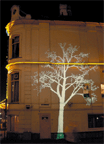
Leaves [a] Sound
Even things we’d likely to perceive as nature, like the trees on the street, are carefully planned and managed and no longer nature. However, the wind blowing through its leaves is. Like footsteps in the sand or ripples on the water, there are still a few natural elements left in the urban environment.
Tree, by Simon Heijdens, is projected onto several facades in the city, including dark corners and alleys. The main location has a 3x8 meter drawing of a tree projected onto the facade of a building. The branches and leaves move slightly, with an intensity that depends on actual wind gusts.
Its leaves are sensitive to sound. For example, a shouting passer-by or car horn, will make a leaf break off the branch. When it falls off the tree, the leaf falls down in another part of the city, projected onto the pavement. Depending on the human traffic of that evening, there will be more and more leaves.
Because the leaves are made of light, the spot where they fall will become brighter over the course of the evening. The tree is projected from sunset to sunrise. Arriving in the city at one in the morning to find an empty tree or a floor full of leaves, it will be clear that something has been happening.
The installation is part of the Radiator Festival, Dec 1st – 4th 2005, Nottingham, UK. I saw it at the Design Museum: there was just one projection in a room of the museum, so one couldn't guess what the whole installation was like, but the piece was neverthesless very poetic and relaxing. [blogged by Regine on we-make-money-not]
Posted by jo at 09:20 AM | Comments (0)
September 14, 2005
Artistic Interfaces:
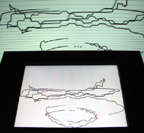
Between Instrument and Artwork
"At three separate venues at Ars Electronica 2005 in Linz, Thomas Petersen found examples of hybrids between artworks and artistic instruments, which explore the relations between sound and vision in physical and virtual space. In this article he offers a few perspectives on what we can learn from these artistic interfaces.
Creative Interactivity Required: Certain types of digital artifacts place themselves firmly in the border zone between instruments for artistic production and artworks. They are 'artistic interfaces' in both senses of the concept. On one hand, they constitute useful interfaces for users to create independent artistic expressions. On the other hand, these tools are artworks in their own right, which offer critical perspectives on the concept of the instrument itself and the dynamics of the creative process.
In the field of digital culture the difference between instrument building and art-making can often be quite subtle. In some cases there are not necessarily any structural differences between an interactive artwork and an interactive space for users to produce aesthetic experiences because they can share characteristics as interactivity, interchangeability, transformation, user-controlled graphics and sound etc. Of course many digital pieces are a far cry from resembling tools e.g. genres like hypertext fiction, point-and-click game environments etc. The defining characteristic of the artistic interface is a specific type of interactivity where the common denominator is a large number of reconfigurable elements, the total sum of which create a manipulable space into which the user can project ideas and expressions. This space depends totally on direct creative interaction from the user.
Each of the following pieces are frameworks of possibilities and limitations. They do not promise more complex or superior results than conventional or analogue instruments, but constitute specific explorations of the production of aesthetic results within certain boundaries. These pieces are critical approaches to the technologies of creative production and can be considered as complex artistic statements in themselves.
Drawing Sculptures of Sound: An immensely popular work at the Cyberarts exhibition at Ars Electronica was Amit Pitaru's Sonic Wire Sculptor, which received an Honorary Mention in the Interactive Art category. This piece attracted quite a crowd in a stuffy room at the O.K Centrum für Gegenwartskunst.
Sonic Wire Sculptor deals with the production of sound by means of three dimensional wire drawings. It explores the correlation between vision and sound as the user literally draws the sound with a pen at a drawing station. The drawings are inserted in a rotating 3d-space as spinning wire sculptures. As this virtual space rotates 360 degrees, the sculpture is interpreted by the computer and transformed into sound according to the initial speeds and positions of the drawings. The vertical axis determines the pitch, notes are indicated by horizontal lines and a metronome can be found at the centre of the stage. The user can save and retrieve the sculptures, stop the rotation and reposition the compositions freely to reconfigure the elements within a new tonal space. The installation of the piece in the exhibition space is based on surround sound so the sound in the physical space reflects the structure of the virtual sculpture.
Compared to many other similar projects the piece distinguishes itself by actually being playable as a performance instrument. It can be used as a precise musical instrument by means of the guidelines to achieve specific notes and precise rhythm. A practical implementation into a joint performance setting is definitely conceivable. The piece is a critical approach to the production and representation of sound at the same time. The wire sculptures are an original counterpart to the conventional note system and a dynamic equivalent to graphic notation systems like the ones used by composers like John Cage, Brian Eno etc.
A Playful Physical Sequencer: A similar project is Golan Levin's Scrapple: A physical active score table, which was presented at the Ars Electronica Center across the Nibelungen bridge. As with Pitaru's Sonic Wire Sculptor, Levin's piece Scrapple deals with the transformation of shapes into sounds. In this case the piece is based on the configuration of physical objects on a table, transforming them into a musical score.
Instead of placing samples in a sequencer or notes on paper, Scrapple adds a physical dimension to computer-generated music. The user has to move and adjust objects to indicate rhythm, tones, melody etc. The visual result quickly ends up as an abstract composition of shapes corresponding to sound. The strength of the piece is not so much being a precise musical instrument but rather a very enjoyable toy appealing to the playful interaction between several users at a time. It also adds a bodily aspect forcing the users to move swiftly around the table.
Other projects by Golan Levin touch upon similar aspects. In The Manual Input Sessions, hand gestures, finger movements and other objects are analyzed by custom software generating graphics and sounds. In Yellowtail, virtual worm-like creatures are drawn by the user on a screen and transformed into sound by a scanning mechanism.
Augmented Table Composition: Going back over the bridge to the 'Interface Culture' exhibition at Kunstuniveristät Linz (Art University of Linz) The reacTable* was exhibited next to a number of experimental interfaces. This particular piece was developed at the Music Technology Group, Pompeu Favra University, Barcelona.
The instrument consists of a round table and plastic objects marked with various symbols. Based on these symbols a camera tracks the position and direction of the objects when they are placed on the table. When one of the objects is placed, the particular symbol is recognized and the immediate environment is augmented with graphics indicating the functions of the element. Some of the objects produce sound and other objects modify these sounds. Some events can also affect the general visual appearance of the table. The total sum of events creates a dynamic, tangible interface with virtually unlimited possibilities in the creation and visualization of sound. The visual result is a stunning abstract animation generating buzzing, clicking and humming compositions.
The interface allows the composer to handle physical objects to generate digital sound supported by a full range of dynamic visualizations. As opposed to the widespread use of e.g. the laptop as a performance instrument, the strength of reacTable* is its tangibility and involvement of the user's body to manipulate digital sound. reacTable* has a social and telematic dimension as there is the possibility of involving distant participants at a shared table. The piece was used in a collaborative performance between Linz and the ICMC conference in Barcelona Spain. The two tables shared musical components and the composers could affect each other' s components in a shared performance situation.
Basic Research: The range of strategies shows us that the visualization/notation of sound is not an unequivocal project. The correlation between sound and vision is a magnet for pioneering instrument builders, simply because this space can never be definitively charted. Each instrument constitutes an interpretation of the ephemeral nature of sound and a longing to map it. The result is an abundance of complex analyses of aesthetic transformations and some very interesting artistic interfaces.
The sheer amount of different strategies of this kind points to the fact that the artistic instrument is under full-scale development these days. These experimental instruments can be regarded as basic research into alternative ways of creating and visualizing music. Because they take place as an experimental practice between art-making and instrument building they can establish interactive spaces which may not have the potential to survive on a commercial market. Certain aspects of these instruments will most likely find their way into commercial production and some of them will maybe become commonplace performance tools - some will not. Whatever their future destinies may be, they are nonetheless important as singular statements and they demonstrate the importance of experimental spaces to develop and test new approaches to artistic tools." [originally published by Thomas Petersen, artificial.dk]
Related links:
- Online version of Amit Pitaru's Sonic Wire Sculptor: http://www.pitaru.com/sonicWireSculptor/
- Amit Pitaru's website: http://www.pitaru.com
- Golan Levin's website: http://www.flong.com
- Yellowtail by Golan Levin: http://www.flong.com/yellowtail/index.html
- The Manual Input Sessions by Golan Levin: http://tmema.org/mis/
- reacTable*: http://www.iua.upf.es/mtg/reacTable/
- A list of tangible musical interfaces: http://www.iua.upf.es/mtg/reacTable/MusicTables/
- Ars Electronica website: http://www.aec.at
Posted by jo at 11:53 AM | Comments (0)
MOBILE CARTOGRAPHIC COMMAND CENTRE (MC3)

Collaborative Cartography and Unlicensed Wireless Communication
The MC3 is a mobile, educational installation that converges all geo-annotation data being produced by the MDCN’s projects into a single location, visually constructing a continually evolving cartographic model of the MDCN. The MC3 is an outreach project that disseminates the Network's research to the public “on the street” via a large, mobile truck or semi-permanent installation. As well as visualizing the MDCN’s cartographic data, MC3 transfers and repurposes vast databases of digital information from the "expert user" field of GIS to the emerging field of “locative media,” thereby making “inaccessible” data accessible via the Montreal and Banff networks as well as online through the MDCN website. Movie.
Posted by jo at 10:47 AM | Comments (0)
EXIST [CORRESPONDENCE] DIÁRIOS JAPONESES
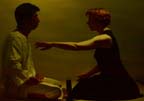
Erotica and Violence in the Space-Time Relations
EXIST [CORRESPONDENCE] DIÁRIOS JAPONESES – NIHON NIKKI – JAPANESE DIARIES ‘ Entre um ser e outro há um abismo’ [Bataille] is an interactive video installation and TELEMATIC performance by Rachel ROSALEN, Brazil; invited artist as LIVE collaborator for the telemátic performance, shin-ya b., Tokyo. This project took place at prog:ME, July 19 to August 28, 2005.
EXIST [CORRESPONDENCE] - DIÁRIOS JAPONESES is a media art project that discusses erotica and violence in the space-time relations lived by bodies-in-flux in the postindustrial metropolis. Built in the creases, this foreign body and in traffic is supported by erroneous roots, approached in the net’s virtuality and lacking bodily presence. This subject who lives in these [anti] territories, draws a diminishing political existence and more technical. Societies of control and contagion, their wounds are evident on the web and symphonized in the urban situations. The body remains as a contaminated act of humanity. These crushed bodies by the failures of the utopias, search on the web and in the difference the love. In this MA*(suspension of space and time), this subject acts through the contemporary versions of masks: avatars, fiction bodies launched in simulated adventures. The relations of proximity and distance are always imaginary. Disterritorialised and lonely, they ask themselves: does Correspondence exist?
EXIST [CORRESPONDENCE] - DIÁRIOS JAPONESES creates many approximation strategies in this everyday impact with the ‘abysm between one being and another’ of which Bataille tells us about. Its this abysm, this black hole, this vertigo that lyes on the skin of the image that reveals in the installation. There are various layers in space and time that are overlapped: the Japanese diaries create a direct counterpoint for the plain net image. If these images (from the diaries) gives us the body-to-body, the confrontation and the denudation before the other, the web gives us dissimulation, the fragmentation and the “superficiality” of a correspondence that is marked by absence.
EXIST [CORRESPONDENCE] - DIÁRIOS JAPONESES is a procedural work built by layers. The images of the diaries form a loop where this suspension is pierced by images used on LIVE. This tension between time and intensity, duration and fragility, proximity and distance, design the rhythm of this correspondence. First layer: video loop of Japanese diaries. Second layer: a telematic correspondence performed in real time using video streaming, performed between two artists between Japan and Brazil gives continuity to the idea of diaries. Third layer: these images of the loop are available into keyboards, connected to two projectors. A program in director links the images used on LIVE to the letter keys of the keyboard. Through them, each user may (re)construct this “situation” of correspondence, in the attempt of building “a bridge between one being and another” throughout the recognition of this abysm of which speaks Bataille.
* MA: Japanese concept, which means space-time suspension, the interval between the inside and the outside in architecture, the retention of the arrow on the bow before it, is launched.
EXIST [CORRESPONDENCE] – Japanese Diaries
Structure:
Telematic live performance
Hardware:
G4 dual 1.4 GHz
Pentium IV 256 GHz
Software
Darwin
QuickTime Player PRO
I Chat
Interactive Installation
Hardware:
2 Pentium IV 256 GHz
Software
QuickTime Player PRO
Director 8.5
Other equipments:
Two projectors de 1500 ansilumens
4 speakers
Space: dark room 7 X 5 mts2.
Techinical assistance: André SHEIK - Programming in Director: Marcos FONSECA, Performance in the Diários Japoneses: Youichirou Osawa, Rachel Rosalen special thanks to: Kabum, Brígida Baltar, Higure 17-15 CAS, IKKA studio.
Rachel Rosalen Visual Artist, graduated in ARCHITECTURE AND URBANISM, with a master degree in MULTIMEDIA ART from UNICAMP, BRAZIL. The artist’s career path has three fundamental axes that get together: the body, the image and the city. With a route specially punctuated by research on the body as a media, the result of which are performances, site specifics and video-installations. Invited professor at SENAC post graduation course, São Paulo. Live and work in between São Paulo, Tokyo and Italy. In 2003 got the Artist in Residence fellowship from Japan Foundation to make an interactive video installation in Tokyo.
shin-ya b.
Born 1967. Lives in Tokyo. Earned M.F.A. from Tyler School of Art, Philadelphia, USA shin-ya b. has been working in different dynamics of fields ranged from film festivals / museum to personal web site / street performances. His works have been shown in many different film festivals including onedotzero and ResFest. He is currently collaborating with toru yamanaka - one of the original sound creators of dumb type, YEN (Yutaka Fukuoka - YEN calling), Kyota Takahashi, and 3KG. Most of his works deal with "accidental panorama - inevitable happenings within accidental cause and pattern recognition" which usually visuals are drawn from his daily personal visions that processed thru digital medium. His show highlights includes Modern Art Museum Kobe, Asahi Art Festival, Tokyo Designers Block and Gallery Art Space (Aoyama, Tokyo).
Posted by jo at 09:42 AM | Comments (0)
**// Code_UP
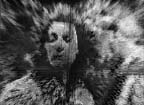
Interrogating the Role of Code on the Construction of Sense
**// Code_UP--by Giselle Beiguelman--is a project about digital image that interrogates the role of code on the construction of sense. We work here, in dialogue with “Blow up” (1966), by Michelangelo Antonioni, one of the most profound discussions ever made about nature and the place of image and about the ways in which we deal with the visible and the invisible.
In **// Code_UP, the public photographs themselves with cell phones and sends their images by bluetooth to the big screen. The images are manipulated by a specially developed for the program and transform into mobile interactive matrixes. The project entered Life Goes Mobile, in September, in its first stage. In October, another version has been released at ZKM (in Germany) at the Algorithmic Revolution exhibition which marks the opening of the most important museum and art and media center of the world. And in December, it participated on FILE in São Paulo and in February, participated on the share.it, in Torino in Italy. An updated and unpublished version will be presented in Rio de Janeiro on Prog:ME, from July 19th to September 20th.
Giselle Beiguelman is the author of the award winning O Livro depois do Livro (1999) and egoscópio (2002). Develops works envolving mobile communication dispositives since 2001, when she created Wop Art, complimented by national and international press, including The Guardian (England) and Neural (Italy), and art that envolves public access and electronic panels such as via internet, SMS and MMS, like Leste o Leste? Egoscópio (2002) , reported by the New York Times, Poétrica (2003) and esc for escape (2004). Her work appears in important anthologies and work references devoted to online digital arts like the Yale University Library Research Guide for Mass Media and Information Arts: Intersections of Art, Science, and Technology (S. Wilson, MIT Press, 2001). Participates of major events on the area, in museums and new media centers like ZKM, Fundación Telefonica, Smart Project Space and MECAD amongst other congresses and international symposiums. She teaches at postgraduation in Comunicação e Semiótica at PUC-SP, is editor of the new world section of the electronic magazine Trópico, colaboration with Leonardo Electronic Alaman, Iowa Web Review and Cybertext and is responsible for the project site Arte/Cidade, coordinated by Nelson Brissac. She was the only brasilian listed in the selection The 50 Best, performed by international/media/art/award 2003, promoted by ZKM, for the project Paisagem0, developed by invitation of SESC in partnership with Marcus Bastos and Rafael Marchetti.
Posted by jo at 09:38 AM | Comments (0)
Deadline Choreography

Site-Specific Dance
"One by one, five dancers staggered through an archway and lurched drunkenly across the concrete floor. They came together, split apart and a bit later slithered, gabbling, face-first across the brick wall.
Dancers on cellphones experimenting with an idea by the choreographer Larry Keigwin, with the Brooklyn Bridge in the background.
Dancers exploring vertical and horizontal forms in Brooklyn.
The dull hum of traffic, punctuated by the clack-clack of cars crossing a bridge, filled the air. The choreographer Tere O'Connor, in baggy pants and a black T-shirt, looked pensive as he surveyed his work in the latest offering from Dancing in the Streets, a nonprofit producer of site-specific performances.
The organization has commissioned five choreographers to present 5- to 10-minute works under stuntlike conditions: they were informed after midnight Sunday, by e-mail, of the performance's location. They have until Saturday to come up with a dance.
All but one arrived on Monday, gazing about and sniffing the creative possibilities at the site, a triangular, roofless section of the 1870's-era tobacco warehouses at Empire-Fulton Ferry State Park in Brooklyn. The Brooklyn Bridge rose overhead. Glorious views of Manhattan, the East River and the Manhattan Bridge were visible through arched windows and doors. A local historian, landscape architects and the show's artistic director, Joanna Haigood, briefed the choreographers. Reporters were told the location ahead of time but were asked to keep it secret.
Imagine "Mission Impossible" in tights.
But there were serious artistic purposes here. Performances in unusual places force audiences to see and appreciate the surroundings in a new light, Ms. Haigood said. The short deadline is a way to inspire choreographers and help them gain new perspective on their creative paths.
"This is really an opportunity to examine your own process and see what bubbles up," Ms. Haigood told the choreographers. She said she hoped they would feel "invigorated and inspired."
When asked about site-specific performances, dance historians like to say that people have danced outdoors since the dawn of humanity. But as a contemporary art form, they came of age in the 1960's and 70's. They are distinct from most outdoor performances in that the area - its history or physical characteristics - shapes the content of the dance.
In this case, the short-term format was also an economical way of bringing an array of prominent choreographers into one show, said Aviva Davidson, the executive director of Dancing in the Streets.
The project is called "Breaking Ground: A Dance Charrette," a reference to the French carts in which 19th-century Parisian architecture students would rush their sketches back to school after being given a 72-hour deadline.
Conversations with the choreographers shed light on how they come up with ideas, and how one location can evoke different responses.
Mr. O'Connor said it usually takes him four to five months to create a dance work.
"So this is very quick," he said. "But you face the same questions. What is this? What is this going to become? How am I going to create something out of nothing?" The difference, he said, is that there is little pressure to produce something of high quality.
The movements on display Monday would very likely not be in his piece, Mr. O'Connor said. "Working is like dabbing. You dab and dab and paint over until you find something," he said. "It's a process of locating something."
The first element that struck him was how sunny the area was. "I don't like the sun," he said. So he began by lining his dancers up along a strip of shadow, which grew larger as the day went on. "I was responding to the heat," he said.
Jawole Willa Jo Zollar, the founder of Urban Bush Women, arrived later in the day. She strode onto the grounds and looked closely at the walls, her eyes continually drawn to the second-floor windows. "I want to figure out how to use these windows here," she said to no one in particular.
Larry Keigwin - like Mr. O'Connor, a newcomer to site-specific dance - said he had originally envisioned a pastoral setting and sought out images of animals for inspiration. That idea immediately dissolved when he saw the red-brick walls and concrete floor of the old warehouse.
Now, he said, he was drawn to the converging lines of the walls that created the point of the triangle: an architectural vanishing point. The urban setting brought cellphones to mind. Maybe each dancer could brandish them? "I immediately thought I wanted to make an urban painting," he said.
The choreographic team known as Eiko & Koma, who have long experience in site-specific dance, appeared more nonchalant.
"It's a very simple structure, so I am thinking of a simple, one movement," Koma said. Maybe something like putting a cigarette in one's mouth, given the ghosts of the tobacco trade, he said. Eiko later suggested she might bring a portrait of herself and move it along the wall, to convey the idea of an archetype of a person who may have lived and worked there. (Large paintings have figured in their work before.) Or maybe she would not, Eiko said.
One choreographer, Ann Carlson, is due to arrive on Friday. She received an information packet and a videotape of the orientation session.
The performances are scheduled for 2 and 4 p.m. on Saturday, rain or shine, and they are free.
The "Mission Impossible" idea brought its challenges. If no one knows the location until a week before, how do you advertise? The leaders of Dancing in the Streets said they sent out thousands of postcards last month announcing the event and date, and sending people to their Web site, www.dancinginthestreets.org, for details. They said they expected 1,000 people for the two performances.
The idea was suggested by Ms. Haigood, a San Francisco-based choreographer who, with her Zaccho Dance Theater, performed a work of aerial dancing at an abandoned grain elevator in Red Hook three years ago.
She and Ms. Davidson mapped out the project on a napkin during a dinner at Carmine's in Midtown last February. The Brooklyn Bridge Park Conservancy, which coordinates special events at the warehouse, gave its approval, helping to cut through the usual red tape for performances in a public place."
Deadline Choreography by By DANIEL J. WAKIN, The New York Times, September 14, 2005
Posted by jo at 09:08 AM | Comments (0)
Space Invader

Urban Invasion
Anonymous French street artist Space Invader makes mosaics from the eponymous video game, which he puts up in public spaces of his victim city. His Invasions are part of a global project. Each attack is complemented by a map of the city showing all the target sites. The most recent invasion occured in Bangkok.
"...Currently the computer icon has led us to rediscover the prehistoric form of communication - the hieroglyph - through the use of icons in the extended landscape of the net, communication platforms, games, and their new iconology or visual vocabulary that has risen through the development of software programs. Andy Deck's, Gylphiti and Space Invader's Invasions create a context with graffiti that appropriates private space. Similar to graffiti, the hieroglyph writer marks on the subway and temple walls. Andy Deck's Glyphiti, is a multi-user collaborative drawing platform calling on the spirit of graffiti is a site specific project using code that filters through private sectors of the net, creating a public domain and a collaborative drawing space that recall the uses of prehistoric hieroglyphs with pixels replacing the mark, to create a real-time icon.
In Space Invader's invasion the attack is addressed in the public domain where the Space Invaders' mosaics lurk the cityscape, and the players are anonymous. Space Invader and Deck introduce the cross-pollination of new media, as the closest notion to public art production by depicting a position of narrative from the maker to the public space-whether it be the streets or the net-continually questioning the definition of PUBLIC. Space Invader uses the aesthetics of a Byzantine iconographer as an instrument through which a work is executed, a work that goes beyond the individual..." From Copy It, Steal It, Share It by Michele Thursz. [via]
Posted by jo at 09:00 AM | Comments (0)
Superstar Tokyo
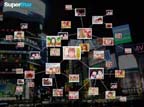
Who's Photographing Whom?
Superstar is a multiplayer photo-based game designed for Ubicomp 2005, Tokyo. The game is free, and open for anyone with a phonecam and self-portrait Puri Kura stickers of themselves. The game uses Japanese Puri Kura stickers as a starting point for an experiment in social networks, automated phonecam image analysis, and urban visual culture. The goal is to see and be seen, using tiny images woven into the fabric of Tokyo streetlife.
To play, place your own stickers (with a star on it to recognize participants) wherever you want and collect the stickers of other players by shooting them with your phonecam. Whenever a player snaps a Superstar sticker both players earn points. A link is then created between the two players. From this point on, any time either player earns points (by shooting a new sticker or by having their sticker shot) the other one will also earn points (though not as many).
Superstar thus builds a network of connections that forms a social, pyramid scheme. Successful players will be the ones that forge connections with other active players. Automated image recognition (e.g. Mobot technology) will decipher who is photographing whom when players email their images to SuperstarHQ via their phonecam. A message is returned via SMS indicating points earned.
Developed by Frank Lantz, Kevin Slavin (areacode) together with Kamida (makers of Socialight), Michael Sharon and Dan Mellinger (Kamida). Details in the PDF. [blogged by Regine on we-make-money-not]
Posted by jo at 08:35 AM | Comments (0)
Dustbunnies
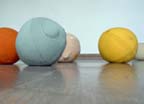
Tread Softly or Else
Dustbunnies, by Stijn Schiffeleers and Hendrik Leper from Boutique Vizique, is a colony of seven shapes that contain two kinds of sensors, a RF-communication system, two microcontrollers, a big battery, speakers and a motor. When there's no human around, they collect dust, hair, flakes of skin and dirt and murmur to each other in a mysterious language. But if you walk into their territory, they become quiet and pretend to be dead.
The only way to observe them in that first state is to be motionless yourself. Touching a dustbunny will cause different reactions. If they like the way you treat them they will make an amusing sound according to the movement you cause. But the Dustbunnies can also become angry. If you mistreat one of them, all dustbunnies will start screaming. The whole group will show their dislike.
For those interested in dirt and art, the dustbunnies will be at the UCI Beal Center (University of California, Irvine) from Oct. 4 till Dec. 10. [blogged by Regine on we-make-money-not]
Posted by jo at 08:25 AM | Comments (0)
September 13, 2005
The Drop

Real World 'Capture the Flag'
"ABSTRACT: We are developing a new multiplayer pervasive game, called The Drop, designed to be compelling to play and yet practical to deploy in real-world settings. In The Drop, two teams use mobile phones to play a version of “capture the flag,” where one team hides a virtual “briefcase” in a public place and the other team attempts to find it within a specified amount of time. If the team that is searching for the briefcase finds it within the game’s time limit, they win; otherwise, the team that hid the briefcase wins. In this article we explain how the game is played, then discuss the technical, social, and business challenges we have faced while creating and implementing it." From The Drop: Pragmatic Problems in the Design of a Compelling, Pervasive Game by I. Smith, S. Consolvo and A. Lamarca (2005). [via]
Posted by jo at 04:09 PM | Comments (0)
Anne Galloway
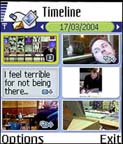
Still Searching for the Social in Mobility
"In thinking about differences between Nokia and Motorola, and mobile tech industries in general, I browsed Matt Jones' and Timo Arnall's del.icio.us links, and a few things keep circling around my brain.
In a podcast of an interview with Anssi Vanjoki of Nokia on social computing, I got a slightly vague, but definitely people-centred, picture of mobile computing. Like Matt, I find their position to be generally encouraging, but I harbour some serious reservations about how industry seems to be incorporating ideas and pratices from academic and other cultural contexts.
Now, it strikes me that Nokia has been proclaiming this 'social turn' as the next big thing since at least 2000, and I'm not entirely sure where it's got them - or us. Should we really assume that all people everywhere want to collect digitial ephemera and log their lives as they go by? I don't mean to accuse or pressure the fine folks and friends who work for them, but what other kinds of mobile sociability can I look forward to? Are open APIs - or other solutions that assume technology is a mere platform or stage for social interaction - really the best we can do?
After 2001, when Motorola released Sadie Plant's report On The Mobile (pdf), I bet few if any people in the mobile industry kept up on, say, the resulting Nettime critiques, which exhibited their own biases and unsupported assumptions but nonetheless raised crucial questions about how to understand mobility and social interaction.
So, when Nokia says they support social or more "humanised" computing, what are they really talking about? What kinds of sociability? What kinds of humanity? And how can we tell the difference between marketing hype and the complex actualities of production and consumption?
Social computing doesn't begin in the hands of users. It emerges in discussions and decisions made in corporate boardrooms, government offices, design specifications, marketing strategies, etc.. Contrary to popular opinion, we're not dealing with discrete pieces here. Unless everyone acknowledges and becomes accountable for their roles in making and re-making technologies, no amount of openness or hackability or respect for users will lead to "social" computing." [blogged by anne on purse lips square jaw]
Posted by jo at 03:26 PM | Comments (0)
ctrl_alt_del

Sonic Encounters
Sound-art festival ctrl_alt_del, will take place in the “positionings” section of the 9th International Istanbul Biennial. The project will launch on September 16th, 2005 with an opening night performance in the city at Balans Music hall, then will continue on the Bosphorus, the Golden Horn, Istanbul Technical University’s MIAM studios, laboratories, library and concert hall until September 22nd. The festival’s three-folded conceptual frame - “the city”, “noise” and “open source”- will be worked into performances, a boat tour, sonic mapping, workshops, and presentations.
The boat tour will start at 11am on 17th of September. The boarding location is behind Türkpetrol gas station, Kabatas and the name of the boat is Nis. The landing location is Besiktas. Please check the web-site for the map. Reservations recommended via info[at]nomad-tv.net as the space is limited.
Posted by jo at 03:04 PM | Comments (0)
Cellphonia: In The News

A Locative-Based Karaoke Opera
Cellphonia: In The News is a locative-based karaoke opera cued and performed by the cell phone with lyrics daily RSS newsfeeds which generate both the score and moving images, available anytime anywhere small groups gather, and also allowing outside users to contribute as a remote chorus.
Cellphonia is an open source cell phone and Internet application that creates a street theater live opera via a conference call shared by user/participants. A server coordinates the instant RSS Newsfeed libretto that is transmitted as text to each of the participant. The server queries the cell phones of the participants to determine each phones capability. In this way the server can make a scalable set of media that takes maximum advantage of each participants phone, allowing a large number of cellphone users to participate anytime anywhere.
The daily newsfeed and the location of each phone algorithmically generates music and a libretto that the participants sing, karaoke style. By using robust tried and true multiline conference call technology, a sophisticated and interactive score can generate cues and musical interludes that lead each singer through the piece. Additionally, using SMS, WAP and various other ubiquitous text formats the libretto with ongoing visual cues are "pushed" to each user. In this way the location, time of day, and news all converge to create a unique and ever changing social experience.
Primary Artist: Steve Bull
Collaborator: Scot Gresham-Lancaster, Composer
Grant Administration: Harvestworks
Related: A Phone is a Phone is a… by Molly Kleiman, NY ARTS.
Cutlass: Connecting the Real World to the Virtual.
Posted by jo at 12:12 PM | Comments (0)
0kn0
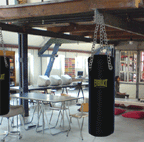
Looking Glass
0kn0.org is a new interdisciplinary media center for art and technology in Brussels. 0kn0 supports the research, development, creation and presentation of new forms of innovative cultural production, and is dedicated to exposing broad and diverse audiences to new technologies and media arts through a programme of concerts, interactive installations, performances, workshops and lectures.
OKNO presents BO-KU-SHI-N-GU BA-GU [Electronic Boxing Bag Melody Making Machine], an interactive installation by SWUMMOQ.NET [Heerko van der Kooij/nl and Niels Wolf/de in collaboration with Travis Robertson/ca]. Punching the Bokushingu Bagu the visitor generates and composes melodies from a selection of various sounds depending on the power and area of the punch. The visitor applies great effort only to be hindered by the outcome of his intensity.
Opening performance by swummoq.net: friday 16 september 8pm-10pm or try it yourself on: Saturday 17 September 2pm-6pm; Sunday 18 September 2pm-6pm; Entrance free.
radio_okno is online now! click: http://qt.okno.be:8000/mix.m3u to open the livestream in your mediaplayer.
Masterclass on Synthetic Speech and Machinic Sound Poetry. Participants can still apply. The masterclass is scheduled from October 17-21 and is part of the x-med-k-2005/series, commissioned by the VAF [Vlaams Audiovisueel Fonds].
OKNO: koolmijnenkaai 30/34 quai aux charbonnages | brussels 1080 | belgium
tram 18 [walvis] | Metro Graaf van Vlaanderen - Comte de Flandres
okno is supported by the Ministry of the Flemisch Community and the VGC.
Posted by jo at 11:41 AM | Comments (0)
Where-Next
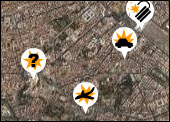
Betting on Terror
"The best day to launch this project was undoubtedly September 11th. The fake institutional tears flowed for the lukewarm memory commemorated a human disaster with a careful selection of morbid images, made to sow the same mediatic terror celebrated in the 'special sections' in the printed and tv media after the main terroristick attacks of the last years. A nodal point of this insane process is the prediction of the next attack, based on many rumours and experts' analisys.
The project Where-next is turning this mechanism over its advocates. It's a game born from the strategic partnership between the Guerrigliamarketing.it and Molleindustria groups. It consists of betting on the next attack, guessing time, place and typology, using the Google Maps API. The game combines two extreme aspects of the contemporary reality: the global legitimation of bets as a tecnique to guess and change our personal future, and the uncertainty caused by terrorist attacks, unbearably amplified by mass media). The authors have constructed this disturbing hybrid, ready to deceive the most incompetent journalists.
On the other side, the game will force everybody else to reflect on how a formalization of the massacre play, ruled by the media on every tragic occasion, trough an online game is triggering complex reactions on the users. In this way the official sources are delegitimized on telling us how the future reality will be made, and then we can repossess the reality imaginery thanks to a sarcastic and playful form. The end result is that the induced terror is played down to an exhilarating game, and the latent panic (as a western contemporary mandatory component) is definitively broken down in pieces." From neural.it.
Posted by jo at 11:22 AM | Comments (0)
Virtually There:
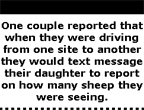
Travelling with New Media
"ABSTRACT: This paper examines the uses of mobile, fixed telephone and Internet–based communication by travellers and the implications of that use for the experience of travel. For most of the respondents, continued communication with their networks of contacts back home were integral to their travel experience, allowing them to maintain an ongoing symbolic proximity or co–presence with people with whom they shared a common history. Travellers make clear distinctions between the uses, benefits and drawbacks of phones, texting and Internet–based communication. The continuation of intense communication between travellers and non–travellers suggests that people ‘back home’ and the travellers are involved in forms of ‘virtual travel’." From Virtually There: Travelling with New Media by Peter B. White and Naomi Rosh White, First Monday, Volume 10, Number 8 — 1 August 2005.
Posted by jo at 10:06 AM | Comments (0)
MusicGrid:

A Case Study in Broadband Video Collaboration
"ABSTRACT: The technical requirements for widespread deployment of broadband video over the Internet are rapidly being met. But a harder challenge remains: how can video–based technologies promote collaboration and learning?
We present a case study: the MusicGrid Project. Running from 2002 to 2004 with partners in several Canadian and international locations, this modestly funded initiative ran over one hundred successful multi–site education and performance sessions. The rationale, development, and operation of the project are discussed, along with general lessons learned. We believe that our experience and the opportunities and issues identified will be useful to all those interested in large–scale, video–based collaboration projects." From MusicGrid: A Case Study in Broadband Video Collaboration by Hassan Masum, Martin Brooks, and John Spence, First Monday, Volume 10, Number 5 — 2 May 2005.
Posted by jo at 09:56 AM | Comments (0)
September 12, 2005
Playing Ethnography:
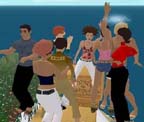
Studying Social Emergence in MMOGs
"Abstract: One of the interesting properties of mmogs is that of emergent social behavior. This sort of behavior can be characterized as activities that evolve outside of the main purpose of the game. For the past 16 months, I have been conducting an ethnographic study, using methods of particiant observation, interviewing and visual anthropology (in- game screen shots) of inter-game immigration patterns. In particular, I have been looking at the Uru diaspora, a group of players who were made refugees when the Myst-based mmog Uru closed in February of 2004. Uru refugees migrated into other game worlds, creating 'ethnic' neighborhoods, bringing the culture, play patterns, and aesthetic of Uru with them. They created Uru-derived artifacts, and over time, began to create original objects inspired by Uru but integrated into the new worlds they were inhabiting. In this talk, my avatar Artemesia will take us on a tour of some of the areas created by members of the Uru diaspora in different virtual worlds, and discuss their relationship to game design. We may also have the opportunity to talk to some Uru refugees during this live 'in-world' demonstration." From Playing Ethnography: Studying Social Emergence in MMOGs by Celia Pearce. [via]
Time: Wednesday, September 14, 6-8pm
Location: USC's Robert Zemeckis Center for Digital Arts (RZC), Room 201 Zemeckis Media Lab (ZML)
3131 South Figueroa Blvd./2nd Floor
Bio: Celia Pearce is an award-winning game designer, artist, researcher, teacher and author of The Interactive Book: A Guide to the Interactive Revolution (Macmillan, 1997), and other writings on game design and culture. She has been affiliated with the University of California, Irvine since 2001, where is currently Senior Research Associate at UC Irvine's Game Culture & Technology Lab, through a research appointment at the Institute for Software Research. She is also an Adjunct Professor in the School of Cinema-Television's
Interactive Media Division at University of Southern California, where she held previous positions as a visiting researcher and adjunct professor. Ms. Pearce's 20-plus year career as an interactive media and attractions designer includes: Creative Director for Iwerks and Evans & Sutherland's award-winning 24-player attraction Virtual Adventures: The Loch Ness Expedition, and Purple Moon Friendship Adventure Cards for Girls. Clients have included: Walt Disney Imagineering, Universal Parks, BBH Exhibits, Lego Toys, and the Jerde Partnership. Recent curatorial projects include: Mapping the Unfindable (Winter 2004), a retrospective exhibition on the work of Norman Klein, and ALT+CTRL (Fall 2004), a festival of independent an alternative games, both at UCI's Beall Center for Art & Technology. She is currently developing an environmental game with the Buckminster Fuller Institute.
Posted by jo at 05:17 PM | Comments (0)
Deconstructing Google Bombs:

A Breach of Symbolic Power or Just a Goofy Prank?
"ABSTRACT: In this study I compare two Google bombs using Melluci’s (1996) social movement framework. Viewing the Google bombing practice as a social movement provides an informative lens from which to analyze the nature and goals as well as the results of this form of online collective action. The empirical basis for this research relies on analysis of the content and context of Google bomb hyperlinking using an approach informed by Beaulieu’s (2005) notion of sociable hyperlinks. From this study I conclude that the Google bombing practice is an online protest technique not unlike the "media mind bomb" developed by the late Bob Hunter of Greenpeace (2004) fame. In the case of Hunter’s mind bombs, sounds and images were used to form alternate constructions of reality in the news media. Similarly, Google bombs are constructed by manipulating the relative ranking of an Internet search term and thereby creating alternate constructions of reality through collective action online." From Deconstructing Google Bombs: A Breach of Symbolic Power or Just a Goofy Prank? by Clifford Tatum, First Monday, October 2005. [via]
Posted by jo at 04:48 PM | Comments (0)
TOUCH ME Festival

ABUSE OF INTELLIGENCE
The international festival Touch Me presents contemporary art production at the intersection of science and technology. Including an exhibition, performances and a symposium, it will tackle the topic of Abuse of Intelligence. This thematic framework arises from the need for artistic and cultural analysis of contemporary forms of violence and systems of control. Starting from the twofold meaning of "intelligence" (implying both information and intellection), the project explores the abuse of information and intelligence, but also the forms of structural abuse brought about by the technological organization of contemporary social processes - abuses relating to information, telecommunications, media, technology, science, the entertainment industry, etc.
Alongside the ethical and political problems of the info-sphere, the festival
explores the abuse and manipulation of techno-scientific discoveries that disrupt, transform or create the living world and environment. The festival takes places within Operation:City.
Posted by jo at 11:38 AM | Comments (0)
glocalmap.to

Digital Turin for the 2006 Olympics
How do urban dynamics change in the digital era? What tools does technology give us to aid the study and design of the territory? A concrete answer to these questions comes from the project by a Turin group of architects and new media experts. Maurizio Cilli, Carlo Infante, Riccardo Mantelli, Filippo Moncelli, Max Paccagnella and Stefano Ruggeri have created glocalmap.to, a digital map of the Turin Olympic area, developed for the Cultural Olympics in collaboration with TOROC, the Games' organising committee.
Global and local, glocalmap.to is an interactive web platform open to inhabitants and tourists alike; for the 42 days of the Winter Olympics in February and March 2006, they will be asked to say what they think of their city. It works quite simply: those wishing to do so can send a message (sms, mms and e-mails with attachments), which will be stored and displayed at a precise point on the map, visible to all via a number of screens. Apart from the play factor, glocalmap.to is intended to represent an experience of participation in urban planning.
For the future they are considering a vectorial version that will allow architects to place their projects directly on the territory. The aim? To trace a new spontaneous map of Turin that will reveal fresh and unexpected geographies. The presentation of the project is scheduled for 6pm today at the Atrium foundation. The speakers are Giovanni Ferrero, Maurizio Cilli, Stefano Boeri and Paolo Verri coordinated by Carlo Infante. Footnote: The Beach club, Turin's urban beach on the River Po, is celebrating its fifth birthday and hosting an open meeting of the Domus editorial team from 8pm onwards.
Torino, Italy
Glocalmap.to
14.9.2005, h. 18
Atrium, via Pietro Micca 21
14.9.2005, h. 20
Club The Beach, via Murazzi del Po 18
http://www.thebeachtorino.it
Posted by jo at 11:19 AM | Comments (0)
Rondo
Interactive and Intercultural Experience
[Posted by Yukihiko YOSHIDA]: Group Motion and Leni-Basso are currently involved in a collaborative multi-media dance project. This project is funded by the Japan Foundation, Dance Advance, Philadelphia, Arts Midwest, Ohio, The US Japan Friendship Commission, Washington, Indiana University of Pennsylvania and Montgomery County Community College, Pennsylvania, WIDE Project, Research institute for Digital Media and Content, Keio University, Yukihiko YOSHIDA.
Rondo will premiere here in Pennsylvania in September of this year and will hopefully be shown in Tokyo in the Fall of 2006 during the 'Dance Selection' Festival where Group Motion also performed in 2003. During our final production week of Rondo, September 14-19, we are planning to have an Internet2 conference in which we will broadcast a rehearsal of the piece live over the internet and have live discussion and interactive exchange with a group of interested people in Tokyo. It will be a wonderful opportunity for performers, critics, and lovers of dance to be involved in an interactive and intercultural experience that is taking advantage of advanced internet technology in a new way as an educational and informational tool.
There will be a designated facilitator and a translator (tbd) on each side. The translator in Tokyo will be Mikari Suzuki.
Date: September 16, 2005
Starting Time: 6:00 a.m. Philadelphia, 6:00 p.m. Tokyo.
Place: Keio University Mita Campus, East Building 6F GSEC Lab
http://www.gsec.keio.ac.jp/
Supportors: the Japan Foundation , Dance Advance, Philadelphia, Arts Midwest, Ohio, The US Japan Friendship Commission, Washington, Indiana University of Pennsylvania and Montgomery County Community College, Pennsylvania, WIDE Project, Research institute for Digital Media and Content, Keio University, Yukihiko YOSHIDA.
Posted by jo at 11:03 AM | Comments (0)
Map-o-matix
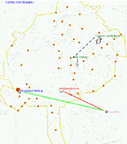
Collaborative Mapmaking
Map-o-matix--by Yves Degoyon, Sergio Moreno, Jaume Nualart and others--is a collaborative environment for creating and editing maps, the maps can contain physical elements (oil resources, telecomunication antennas...) as well as abstract ones (human organisations, web sites, rss, ... ) and relations between these entities. Behind this tool is the idea of editing and publishing tactical maps, maps that are not only physical but also the maps of control structures and of localized social infrastructures. [via]
Posted by jo at 10:49 AM | Comments (0)
Interactive Billboards

What's afoot for advertising?
REDWOOD CITY, Calif. -- This was Matt Bell's idea of fun: Take a semester off from his undergraduate studies at Stanford University, and go to Cambridge to help out with research at the Mitsubishi Electric Research Lab, a group of forward-thinkers who develop innovative display and interface technology. In his free time, Bell would sit in on lectures At MIT's Department of Electrical Engineering and Computer Science.
During one lecture, Bell found his mind wandering, and as the professor walked in front of a screen, the light beam from the LCD projector blanketed his body. Bell wondered whether it would be possible for a person's body to have an impact on the projected image. ''I got this image of waves rippling off of him as he crossed the screen," Bell says. ''I started thinking, 'How would I make that happen?' "
Five years later, having finished his studies at Stanford, Bell is chief scientist for Reactrix Systems, a Silicon Valley company that has attracted $23 million in venture capital funding. In the company's office, amidst the cubicles, Bell stands just outside the edge of what looks like a white plastic dance floor, a rectangle of about four by six feet.
A super-bright LCD projector mounted on the ceiling casts images onto the floor. There's also an infrared camera nestled next to the projector, watching to see who does what on the floor. Suddenly, an image of a soccer field is projected, with the Adidas logo plastered on everything. When Bell ''taps" the image of the ball with his toe, it glides across the floor, and into the goal I'm supposed to be guarding.
There are other games, like Whack-a-Mole and ice hockey, all bedecked with sponsor logos. Some of Reactrix's ''spots" aren't really games, but rather interactive animations. ''Touching" a kernel of Orville Redenbacher popcorn with a foot or hand makes it explode into a puffy white morsel; ''nudging" a Hot Wheels car makes it change direction, sometimes crashing into others on the track.
''Most advertising forces itself on people," Bell says. ''It takes up your time without asking permission. We thought that if we made advertising fun, people will be more interested in it."
And Reactrix's interactive billboards -- floorboards? -- are fun, especially when they lure several people into playing together in a public space. At a moment when people are buying digital video recorders and subscribing to satellite radio to escape commercial messages, this is advertising that people will want to engage.
The next step for Reactrix is to roll out more displays, which it calls Reactors. Chief executive Mike Ribero says 300 will be deployed this fall, in locations like malls and movie theaters. (The closest ones to Boston now are in Manhattan's Times Square, in a Toys ''R" Us store, and in an AMC multiplex.) An advertiser will pay $4,000 a month to have its spot played at a single location, as part of a rotating group of 10 spots.
Ribero says that because users are physically involved, they have a better recollection of the brand names than if they had simply strolled past a poster or billboard. ''Once we get to 1,000 locations, then we'll have a network that can compete effectively against broadcast and cable," he says.
Ambitious goals for a company that was inspired five years ago by a tedious MIT lecture.
Video revolution
Entrepreneur Rob Frasca has been thinking about how to intelligently place ads into online video. He has been holed up at Highland Capital Partners' first-floor incubator space in Lexington, along with three fellow Lycos alums.
Bob Davis, who founded Lycos and was its chief executive, and is now a partner at Highland, offered Frasca the space, but Davis hasn't committed to making an investment in the start-up, I-Video Works.
That's fine by Frasca, who says, ''If you raise capital too early, you give away too much of the company." In the past, Frasca has started and sold companies to Intuit and Lycos.
Frasca notes that more people now have broadband connections than dial-up, which is allowing them to consume more video over the Internet. ''We're working to create tools to get video up on the Web, stream it, put ads in it, monetize it, and manage it," he says.
Of particular interest are tools that will allow users to recommend videos to one another, and techniques for inserting ads based on who is viewing a video, when they are watching, and on what device.
''With a traditional television show, everyone watching sees the same ad," Frasca says. He's thinking about delivering different ads within a snippet of video, depending on whether it's viewed on a PC or a mobile phone, for instance, or whether the video is being seen at noon or midnight.
Veteran firepower
Like Frasca's band of ex-Lycosians, Art Technology Group cofounder Joe Chung has pulled together several veterans of that e-commerce company to work together on a start-up. Allurent, headquartered in the old Wordsworth Books building in Cambridge, is announcing its launch today at the Shop.org trade show in Las Vegas.
The company was started last September in Chung's Cambridge dining room. He says it focuses on helping online retailers ''provide a better customer experience" by supplying a suite of ready-made software modules. The modules will be based on Macromedia's Flash technology, which renders web pages more fluid and interactive. The first releases will be a shopping cart and a check-out system.
Several of the same angel investors who initially backed Art Technology Group are helping to fund Allurent, including Bob Forlenza of Tudor Investments, Jeff Newton of Gemini Investors, Scott Jones of Gracenote, and Bob Maginn of Jenzabar. Media Lab founder Nicholas Negroponte and Teradyne founder Alex D'Arbeloff are also helping to fund the 12-person start-up.
What's afoot for advertising? by Scott Kirsner, @LARGE [The Boston Globe], September 12, 2005.
Posted by jo at 10:30 AM | Comments (0)
Artivistic ::

art.information.activism/e
Artivistic is a transdisciplinary event on the interPlay between art, information and activism. The bilingual event will bring together diverse practitioners and theorists of activist art and communication through performances, art exhibitions, interventions, workshops and roundtables.
The event includes a *benefit* for Steve Kurtz (Critical Art Ensemble) and Robert Ferrell on the evening of the 22nd September, towards the CAE Legal Defense Fund. The artistic and free-form conference asks three overlapping questions in order to consider new + different possibilities: * Why is Activism Associated with the Street? A question here on the notion of space and the politics that underlies it; * Who Owns your Body_Mind? A question for analysing the authority of scientific knowledge in relation to society; * Who is Allowed to Communicate? A question on communications and media, information as a right and vector of freedom.
The event is an independent and interuniversity initiative. It aims to promote open transdisciplinary + intercultural dialogue and research on activist art, to create and facilitate a human network of diverse peoples, and to inspire, proliferate, activate.
For the complete program and for conference registration, please visit: http://artivistic.omweb.org
Inquiries/registration : artivisters[at]graffiti.net
Conference location: 2013 St.Laurent, 2nd floor, t. 514 849 8246
3 days of conference, including workshops, meals/coffee and conference package (excluding special events):
$18 student/unwaged
$40 faculty/waged
--= special events =--
CABARET for CAE (The Upgrade! Montreal / [ctrl] collective) benefit with djs, performance & a silent art auction with Canadian & international artists:
$5-$15 (door, suggested donation)
@ SAT (Society for Arts and Technologies)
1195 St.Laurent, t.514 844 2033
http://theupgrade.sat.qc.ca
Urban Happening with public-active installations, performance, music and live painting:
Free
Location TBA
http://artivistic.omweb.org
http://www.popandpolitics.net
'Volatile Shorts' + closing event with djs, vjs, performance & tactical media screenings (Volatile Works et al.):
$5 suggested donation
@ Café Toc Toc
6091 ave. du Parc
http://www.volatileworks.org
Posted by jo at 09:57 AM | Comments (0)
September 09, 2005
PAUSE

Sonic Hammocks
The sound installation PAUSE is made of 5 hammocks connected to each other at the center by a system of springs. Any movement caused by the presence of a visitor is transmitted to the other hammocks.
When a visitor sit in a hammock or leave it, s/he causes rocking movements which are detected by sensors. The information influences in real time the audio-tactile events transmitted by 9 loudspeakers distributed in the hammocks. The sounds become really audible only for spectators who lie in the hammock and press the hands on their ears. The mechanical vibrations resulting from the transmission of the sounds in the loudspeakers become perceptible on the body itself and the sounds are retransmitted in the inner ear by bone conduction. Each loudspeaker has its own channel so that the sounds, and the vibrations they cause, can move on the body from one source to another. The spectator is thus confronted with different types of movements: the swinging of the hammocks, the vibration of the loudspeakers and the movement of the sounds and their vibrations from one speaker to another.
By Lynn Pook (see also A Fleur de Peau). Pause is part of the Festival Emergences, in La Vilette (close to Paris), Sept. 24 - Oct. 2. Related: Hammock of electricity. [blogged by Regine on we-make-money-not]
Posted by jo at 05:41 PM | Comments (0)
The Urban Lottery:

A Game to Think Through the City
"The game consists of a journey through a series of images, concepts and words that have different meanings for contemporary urban residents. For women, for example, everyday life in the city is a very different experience than it is for men. The gaze of a person who walks through city streets on his or her way to a factory job is different than that of a person who contemplates them from an office in a downtown skyscraper, or who looks out in fear across the heavily fortified fences that protect his or her private space.
The Urban Lottery invites you on a never-ending adventure-to think through the city and to think about yourself in relation to the city that you inhabit. It does not matter what city you live in. What matters are the ways in which you explore, discover and understand that city and your relationship to it. Most important, however, are the ways in which you become involved and participate in building a better, more democratic city in which there is room for all." Part of Translocal Flows: Migrations and Contested Urban Spaces in the Americas. [Posted by Anne on space and culture]
Posted by jo at 02:42 PM | Comments (0)
Ars Electronica
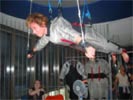
Blog From Ars
Hana Iverson and Sabine Seymour have just wrapped up their extensive report on Ars Electronica. This year's Ars, called "Hybrid: Living in Paradox," was curated by Derrick de Kerckhove, head of the Marshall McLuhan Program at the University of Toronto. A bit about Hana and Sabine is below and their report is after the jump.
New media artist Hana Iverson is currently the Director of the New Media Interdisciplinary Concentration at Temple University. Her work spans digital, video and sound media and has received support from such institutions as the Covenant Foundation, the Memorial Foundation for Jewish Culture, and the New York Foundation for the Arts (NYFA).
Sabine Seymour, Adjunct Faculty at University of Art and Industrial Design in Linz/Austria and founder of the course ‘Fashionable Technology’ at Parsons School of Design, concentrates on on wearable/wireless technologies in sports, healthcare, design, and branding. She co-curated the "Wearable Experience" section at ISEA 2004, recently published Intelligent Wearables, presents at places like Viper and Cooper-Hewitt Summer Design Institute, runs her commercial entity, Moondial and website, Fashionable Technology. Sabine floats between New York and Vienna and is intrigued by the tension the dual continent living is offering. Continue reading at Cool Hunting [blogged by Josh Rubin]
Posted by jo at 09:50 AM | Comments (0)
September 08, 2005
Alvin
![]()
Sonic Incubator
Alvin, by Jamie O'Shea, is a cellular automaton. Eight different cells produce sound. The sound one cell produces is determined by what sound the other cells are making. This kind of interrelated input and output scheme is an artificial neural network; a simulation of a brain. Alvin imitates living organisms in another way, because the sound circuits are actually built and destroyed by one another, rather than just turned on or off. The sound jiggles metal powder just like heat jiggles chemicals in a living cell. It is a way of making dynamic order out of randomness.
The sounds Alvin can make are pseudosine waves between .5 hz and 100 hz. When a cell has only a little input, it is subsonic, and can be seen moving. As it gets more input, the tone increases in frequency. At about 100 hz, it can jostle components for new sound circuits, sending "outputs" to the other cells. Eventually, the cells kill each other and start over. Once a pattern has been started, it can evolve in this way for a long time, changing in complex and unpredictable ways. It is a bit like the sound of a computer dreaming. Alvin will be on view at Circuit #1, September 9 - 10, 2005, Fri-Sat, 12-6pm, Eyebeam, 540 W. 21st St., New York.
Posted by jo at 03:58 PM | Comments (0)
International Conference
![]()
Technologies of Memory
May 19-20, 2006, Radboud University Nijmegen (The Netherlands). The conference Technologies of Memory in the Arts focuses on art as a cultural and technological practice to process and construct the past in the present. Central questions to this conference are: How do art and artistic practices function as technologies of memory? How are cultural artefacts implicated in complex processes of remembering and forgetting, of recollecting and disremembering, of amnesia and anamnesia?
As a shared artistic and social practice, cultural memory links the present to the past. In doing so, cultural memory has strong ethical and political aspects. The arts are continuously engaged in non-linear processes of remembering and forgetting, characterised by repetition, rearrangement, revision, and rejection. In artistic representations new memories are thus constantly constructed, deconstructed and reconstructed by narrative strategies, visual and aural styles, intertextuality and intermediality, representations of time and space, and rituals of remembrance. These complex processes of representation are what we understand by the term 'technologies of memory'.
The contemporary fascination with history and memory is accompanied by developments in media technology that have simultaneously a petrifying and a virtualising effect. Both individual and cultural memory are increasingly mediated by modern technologies, which means that memories are not only recorded and recollected by media, but are also shaped and produced by them. The digital media, in particular, allow for new ways of storing, retrieving and archiving personal and collective memories, as well as cultural artefacts.
The conference Technologies of Memory in the Arts specifically addresses the material construction of cultural memory. It aims to explore procedures of memory in both traditional and new media as well as to investigate the role of digitalisation of art and culture in relation to memory. Generally, its focus is on the materiality of representation and on the relation between the medium and the construction of cultural memory.
Keynote speakers (confirmed):
- Marita Sturken (University of Southern California)
- Ann Rigney (Utrecht University)
We are especially interested in panel and paper proposals on the following topics:
- Mediated memories
- Narrative strategies
- Intertextuality / intermediality
- Music as memory work
- Urban space and spatial dimensions
- Tourism and heritage
- Musical subcultures as memory space
- Representations of memory in the arts
- Amnesia and anamnesia
- Icons of the recent past
- Rituals of remembrance
- Rituals, music and the shape of memory
- Nostalgia and pastiche
- Retro styles as forms of cultural memory
- Rewritings of the classics
- Digitalisation of archives
- Music/sound recordings and the technology of memory
Deadline for proposals: 1 November 2005.
More information and submission:
http://www.ru.nl/comparativearts/research/technologies_of/
Posted by jo at 03:11 PM | Comments (0)
Performance Writing #5

LAURA ELRICK and SUZANNE STEIN
New Langton Arts' award-winning Performance Writing series continues this fall with performances by literary artists Laura Elrick and Suzanne Stein. Laura Elrick’s work explores novelty in language, and the relationships between spoken language and written texts. Her Langton performance consists of multiple voices reading her text Fantasies in Permeable Structures (2004), tackling contemporary ideas of nation, race, rationalism, and resistance. Suzanne Stein discusses and demonstrates poetry’s religious and psychological implications in an exploration of the relationships between the self and the group.
The Performance Writing series brings multi-disciplinary literary artists to Langton to present works that explore language in the context of live performance. The series, curated by Jocelyn Saidenberg and Brandon Brown, earned a 2005 “Best of the Bay” award in the San Francisco Bay Guardian for “Best New Reading Series to Catapult Language Off the Page.”
Thursday September 29, 8 pm
New Langton Arts
1246 Folsom Street (between 8th and 9th streets)
San Francisco, CA 94103-3817
415 626 5416
Artist Biographies
Laura Elrick’s book Fantasies in Permeable Structures is forthcoming this fall from The Factory School Press, as part of the “Heretical Texts” series. She is also the author of sKincerity (Krupskaya, 2003) and is one of the featured writers on Women in the Avant Garde, an audio CD produced by Narrow House Recordings (2004). Recent poetry and essays have appeared in the Poetry Project Newsletter, The Brooklyn Rail, Tripwire, Crayon, and War and Peace. Elrick lives in Brooklyn, New York.
Suzanne Stein’s works have appeared in the publications Mirage #4/Period[ical], Commonweal, Small Town, The Bay Area Poetry Anthology, and at the venues Refusalon Gallery, the San Francisco Exploratorium, the Berkeley Art Center, Outpost for Contemporary Art, and elsewhere. She is the former co-director and film curator of four walls gallery, San Francisco. Stein lives in San Francisco.
Posted by jo at 12:22 PM | Comments (0)
VENUS RISING:

Mobile Technology in the 21st Century
Where is mobile technology taking us in the 21st century?...And do we want to go there?
Cybersalon continues its Venus Rising series of panels in collaboration with the SMARTlab Centre to discuss where mobile technology is taking us this century. With over 75% of the UK population owning a mobile phone, women are a crucial sector of the mobile market. However, most technology is developed by men, so is the feminine perspective being taken into account? Are we considering how mobile technology could help shape the future in positive ways, not just for play and leisure but for social and economic growth, particularly in the developing world?
Tuesday, 20th September 2005, 7-10pm
The Science Museum's Dana Centre, 165 Queen's Gate, South Kensington, London SW7 5HE
Cost: This event is free but places must be booked in advance by emailing
Nearest tubes: South Kensington/Gloucester Road
Venus Rising is a forum that launched at the Science Museum's Dana Centre in April and held a panel on techno-semantics at the Institute of Contemporary Art in July. With this series of panels we pose the question, can we shift the cultural image and language of technology towards the feminine?
Dr Lizbeth Goodman, Director of the SMARTLab Centre at Central Saint Martins College of Art and Design will chair the event featuring Lev Manovich and Emma Westecott.
Lev Manovich is recognized as one of the leading figures in the field of new media culture worldwide and is a Professor in the Department of Visual Arts, University of California, San Diego. Emma Westecott achieved international recognition for working closely with Douglas Adams as producer for the best-selling CD-ROM Starship Titanic (1998, Simon & Schuster) and is currently based at the IFSW, University of Wales, Newport. We are asking the speakers to look through the lens of the feminine to where mobile technologies are taking society in the future.
This public debate is held at the Science Museum's Dana Centre - the UK's only venue for s to discuss contemporary science.
Venus Rising gratefully acknowledges funding support from the Arts Council of England and the Science Museum.
Posted by jo at 10:20 AM | Comments (0)
The Ladder

Cinema as Physical Experience
The Ladder--by John Gerrard--consists of two installation rooms, one containing either a large projected landscape, or depending on installation contexts, a window to outdoors. The main room is empty but for an overlayed virtual character only to be seen through a handheld viewing device. This installation room is plain apart from a window, cut high into the wall and giving a vista, across a space, to the landscape in the next room. The virtual character is most interested in the landscape and continually voices concerns and observations as to its nature from his position at the window, standing on a virtual ladder. This monologue, presented as a 3D soundscape and experienced through wireless headphones can be heard throughout the installation and unites the diverse elements within the piece.
The work exists at the faultlines opening between traditional notions of presence and place, blending spatial, generative and augmented elements, both virtual and real together into a work of contemporary art. The artist views the possibilites within augmented or mixed reality as a most important breakthrough in media art, allowing cinematic type installations to move from the 2D plane and inhabit the gallery. Through these strategies cinema can be recontextualised as an interactive and physical experience. [via]
Posted by jo at 09:52 AM | Comments (0)
FUTURE WIRELESS:
![]()
practical.discourse.creative
Cybersalon and Open Spectrum UK scan the horizon of wireless communications to explore its emerging landscape and ecology and present an investigation into Future Wireless.
Through three parallel strands of programming - practical, discourse and creative - Future Wireless features presentations, demonstrations, practical workshops, artistic interventions and debate to demonstrate and probe the nature, impact and potential of the wireless Internet, mobile telecommunications and other radio-based technologies.
Complemented by the Dana Centre's state of the art technological resources the organisers assemble an international group of cultural commentators, researchers, artists, free wireless network activists and developers to share their insights and speculate on the nature of a 'wireless future'.
Tuesday, 4th October 2005, 12-10pm
The Science Museum's Dana Centre, 165 Queen's Gate, South Kensington, London SW7 5HE
Cost: £5. Email
Members of the press interested in attending or for further information, please contact Lauren Gildersleve at the Science Museum
Nearest tubes: South Kensington/Gloucester Road
Contributors include: Dooeun Choi, curator Art Center Nabi, Seoul, Korea; Peter Cochrane, co-founder Concept Labs (formerly CTO of BT); Bob Horwitz, co-ordinator Open Spectrum International, Prague; Adam Hyde, new media artist from New Zealand, with a special interest in streaming media, in both visual and audio contexts; Francis McKee, research fellow at Glasgow School of Art and part-time Head of Digital Arts and New Media at the Centre for Contemporary Art in Glasgow; and Marc Tuters, researcher in new media, University of Southern California's Annenberg Centre. The programme also features artistic interventions from SOMETH;NG supporting work from MA students at Ravensbourne College, Taxi_onomy and Troika.
Complete with a wired café-bar connecting it to people all around the world, the Dana Centre brings exciting, informative and lively discussion to people who want to talk about challenging and cutting edge topics in science, the arts and culture. Cybersalon aim to web cast elements of the programme live from the Dana Centre, enabling a worldwide audience to engage and interact with the event.
Posted by jo at 08:23 AM | Comments (0)
September 07, 2005
Sonification/Listening Up:
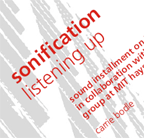
Research Made Audible
Sonification/Listening Up--by Carrie Bodle in collaboration with MIT Haystack Observatory--is a multi-speaker site-specific sound installation on I.M. Pei's iconic Building 54 at MIT. The speakers broadcast audio representations of sound waves embedded in the Earth's charged upper atmosphere, or ionosphere, a region under active radar study by the Atmospheric Sciences Group at MIT's Haystack Observatory. This project utilizes sound as a representation of research at MIT, extending to the public what is normally invisible.
The speaker arrangement on the Building 54's façade recalls an downwards-sloping graph. This is representative of the spectral frequency distribution of the sounds, which vary both by time and in altitude. The broadcast sounds are in fact frequency-scaled versions of ion-acoustic pressure waves within the hot ionospheric gas, which changes state in a complex interaction with the Sun's varying output. Seven different altitude levels in the ionosphere have been used to construct ion-acoustic sounds that will broadcast from seven layers of speakers on the facade of the building.
Time: Daily 12:00-1:00 pm
Dates: Sept 9-16 2005
Location: South facade Building 54, MIT campus [map]
Sound Off (closing event): Sept 16th 5-7 pm
Sonification / Listening Up is done in collaboration with Dr. Phil Erickson of the Atmospheric Sciences Division at MIT Haystack Observatory. Sponsored by the National Science Foundation, MIT Haystack is currently the only observatory located in the Continental United States that uses this powerful ground-based sensing technique to map changes in the makeup of the ionosphere. Such changes, especially during disturbed periods, can affect the precision of GPS technology and other man-made long distance and satellite transmissions. Knowing and predicting the constitution of the ionosphere has become an integral goal for commercial interests as well as a driver of the national Space Weather effort funded by the National Science Foundation, and this project puts a spotlight on nearly five decades of study by the Haystack research group at MIT.
Funded by: MIT Office of the Provost , MIT Vice President for Research and Associate Provost, MIT Associate Provost for the Arts, MIT Department of Architecture, MIT Visual Arts Program, and Council for the Arts at MIT.
Posted by jo at 01:41 PM | Comments (0)
FontanaMixer
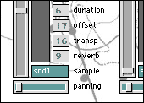
Simulating John Cage with Algorithms
The coding of conceptual works through the programming code is a peculiar form of 'digitalization' that implies an important mediatic shift (from a material medium to an immaterial one), even if at the same time it exalts the ideas in the perennial algorithms' output. FontanaMixer is a generative software based on 'Fontana Mix', a conceptual work by John Cage made in 1958, programmed for the Mac OSX platform by the austrian Karlheinz Essl almost 50 years late. The score was made by 'instructions' expressed as full stops, lines, and graphics and juxtaposed through transparent sheets in a casual manner. It calculated six different parameters for very sonic event, letting the interpreter freely choosing the parameters. This anarchic freedom of interpretation with no apparent order, that Cage connected with the liberation from the personal tastes connecting it to the natural events, is reflected in this software with four autonomous channels and parameters that autonomously modifies under the user's eyes. The work's theatricality is disappeared, and also the equipment presence on stage (four tape recorder) then used by Cage. But this work, commissioned by the Wien Modern, realizes a sort of software 'cover' of an historical performance. It preserves (instead of the common 'musical' covers) the inspiring principles that once motivated and animated them. The vagueness, the opportunity and the silence are here again, calculated by a microprocessor fed by the necessary instructions, and protagonist of the same poetic original automation. [via neural.it]
Posted by jo at 12:56 PM | Comments (0)
Vuk Cosic's File Extinguisher
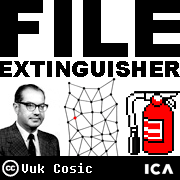
For a Safer Internet
ICA's Digital Sudio, in London, is welcoming Vuk Cosic's XL L M Slovenia, his first solo show in the United Kingdom. Cosic is one of net art's pioneers, having coined early in the 90's the term net.art when referring to artisitic practices that use Internet and its specific characteristics as a creative medium.
The show will be on from September 6th until October 2nd and it will include projections of works forgotten in the artist's computer and done during what is now known as net art's heroic period. Besides these works, a new comission, specifically done to be shown at this exhibition, will be presented, called "File Extinguisher".
The new project, "web's first file extinguisher" as it is said on the site, was first done in 1998 but never shown. After that it was commissioned by Hamaca in Barcelona but that never materialized. And since Cosic had all the files, design and all, he decided to put it up for his show at ICA.
But what is this File Extinguisher all about? It is that, a simple File Extinguisher. Cosic departs from Paul Baran's memorandum on distributed communications network and assumes that this document was published with a tremendous omission. As he says: "Baran insisted that the true last line of defence of any distributed network would be a file extinguisher. However, he indicated this function with a red dot; due to the limitations of 1960s-era black-and-white printing, this key element was not visible in his publication. We can now recognize that today's internet vulnerabilities are a direct result of this tragic mishap."
So there you have it: Baran's model of distributed network, intended to survive an eventual nuclear attack, was published without something very important: the file extinguisher. But Cosic made that final step and created one. Now the internet is finally safe as Baran wanted. So if you have any files or websites you need to delete just use Cosic's new safety tool and extiguish them.
File Extinguisher, Vuk Cosic, 2005
http://www.file-extinguisher.com/
commissioned for
XL L M Slovenia
ICA - Digital Studio
06 September - 02 October
Posted by luis at 08:15 AM | Comments (0)
Celebrating Quixote through new media
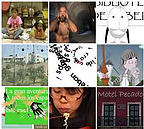
Ingenio 400
You can now visit http://www.ingenio400.com/ to learn the names of the Finalist Pieces in Ingenio 400, the Video Art, Short Film and Net Art Awards organised by the Sociedad Estatal de Conmemoraciones Culturales (SECC).
600 artists were invited to reinterpret D. Quixote through new media, 400 years after being created by Spanish writer Cervantes. A total of 35 works –12 shorts, 13 video creations and 10 net-art pieces- have been chosen as candidates for the Jury and Audience Prizes, which total € 90,000.
Furthermore, until October 3rd, you can vote to elect the winners of the Ingenio 400 Audience Prizes. There are three awards: one for each category –shorts, video art and net art– and they are endowed with € 5,000 each. Enter Ingenio 400 and vote for your favourite pieces among the Finalists. The winners will depend on your votes.
Posted by luis at 05:11 AM | Comments (0)
September 06, 2005
Displacing Identity and Privacy
An Analysis of Jenny Marketou's "Translocal: Camp in my Tent"
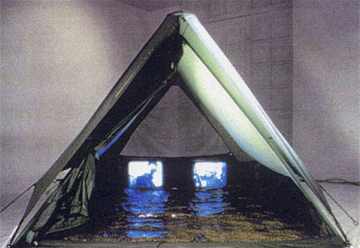
Displacing Identity and Privacy: An Analysis of Jenny Marketou's "Translocal: Camp in my Tent" by Amanda Beattie [PDF] [via Sousveillance]
Posted by jo at 02:25 PM | Comments (0)
Ars Electronica

StrandBeest and the Fossils of New Media Art
I've just come out of a presentation by Theo Jansen of his StrandBeest, huge creatures made out of electrical tubing, cable clips and other cheap materials. Jansen is an engineer/artist who has spent the last 15 years evolving the StrandBeest as wind-powered walking beasts that roam the sand of the beaches where he lives. They are beautiful creations, awe-inspiring in their complexity, and graceful in their movements.
Jansen has used evolution simulation to develop more efficient joints for the creatures legs, and has now developed techniques (using plastic bottles and netting) to store the wind that blows along the beach and use it as power for the StrandBeest. His current research is in developing systems of 'liars' - simple yes/no logic gates powered by air and tubing. He is developing these into networks that are either dynamic, and therefore can drive movement, or are static, and can store information. He believes that the StrandBeest will be able to count their steps, realise when they are approaching the sea, or even pass knowledge on to new generations of beasts.
The presentation was part of this year's Ars Electronica festival, a series of exhibitions and symposia on the theme of 'Hybrid'. I've been to a few of the talks, but much of the interpretation of the Hybrid theme has been far too esoteric and academic, and I don't have the stomach for that kind of debate any more. I caught the end of Neil Gershefeld's presentation via webcam of his FabLabs and Internet 0 projects, which were very inspiring, and perfectly addressed the Hybrid theme by taking digitisation into real production. David Weinberger followed with a very interesting thesis on how we are moving into a third mode of structuring knowledge, away from Aristotlean tree structures and taxonomies, and towards a cloud of dynamically structured (*not* unstructured!) links, tags and conversations.
But the highlight by a long way has been the StrandBeest. I don't know whether it was Theo Jansen's dry wit, the anthropmorphic delight his creatures create, or sheer awe at their technical complexity, but he enraptured the audience, and earned a standing ovation at the end. By taking engineering back to basics (his work is often compared to Da Vinci's unbuilt prototypes), Jansen's evolving working method somehow reminded me of current trends in bottom-up development in software and interaction design.
I didn't expect to find that the most inspiring work at Arts Electronica wasn't electronic at all. In contrast, much of the new media work being exhibited looks tired an old, and could have come from any festival in the last 10 years. The StrandBeest look like they could have come from any time in the last 1000 years, and somehow look more futuristic because of this. By taking engineering back to basics, Jansen's work offers inspiration for new ways of thinking about software and interaction design. Most of the other work here looks like it has reached a dead end, playing out variations on interaction models (stand in front of a screen and wave at something, move things around a table to make music, etc, etc) that don't seem to have moved on for a decade. The StrandBeest might look like fossils, but they've got more life in them than anything else here. [Posted by matlock on test]
Related: Interview with Theo Jansen
Posted by jo at 01:46 PM | Comments (0)
Bamiyan's Laser Buddhas
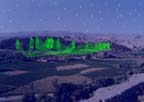
Chance Encounters
Six months before radical islamists affiliated with Afghanistan's Taliban got our attention on September 11, 2001, they outraged the world by blasting 1600-year old Buddha statues off the face of the Bamiyan Valley cliffs. Now California-based artist Hiro Yamagata has plans to put them back.
At the request of Afghanistan's government, he'll install a permanent laser projection system in the valley to superimpose 140 faceless, overlapping Buddhas. To be completed by June 2007, the project will utilize 14 laser projectors powered by windmills and solar panels to create the nearly 200-foot tall images. While Yamagato says "I'm doing a fine art piece. That's my purpose - not for human rights, or for supporting religion or a political statement," the medium of light, a theme in most major religions, seems perfect for illustrating the ethereal and ultimately indestructible nature of what underlies not only Buddhism but most spiritual traditions. [posted by Paul Schmelzer on Eyeteeth]
Posted by jo at 01:14 PM | Comments (0)
Simbabwe

Political Games, Walking A Fine Line
At what point does satire become cynicism? The line between them can be extremely fine, one very dependent upon perspective. But it's an important distinction to make, because one point of satire is to reveal the deceptions at work in public performances (whether they be for entertainment or politics); done correctly, satire makes it much harder to accept these continued deceptions. The revelations of satire make us laugh and hurt at the same time. Cynicism, conversely, often takes the deceptions as a given, and admits their existence while denying that we have any choice in the matter. The revelations of cynicism at best make us seek to escape, at worst make us look for ways to get into the game.
Simbabwe, a computer game put together by The Daily Grind (MacOS X only), walks that fine line between grim satire and cynicism; those of you who get a chance to play it can tell us in the comments on which side you feel it falls. After running through a full game, I'm tending towards grim satire, but am willing to entertain counter-arguments.
Simbabwe is, on the surface, a Monopoly-style game of parcel acquisition, chance events and player backstabbing. Players take on the label of one of the various historical strongmen and dictators that have ruled Zimbabwe (formerly Rhodesia), moving around the board seizing and plundering resource industries, major cities, media outlets, and so forth. Random events range from being put on a human rights watch list, rigging elections, sending opponents to jail, and the like, each combining all-too-familiar events with game effects. Each player seeks to increase both political capital and the destruction of assets, while keeping cronies happy through occasional payoffs.
# Features: Challenging AI
# Sophisticated inflation model: watch prices go up and savings erode every time you print money.
# International reputation model: your actions determine whether you get aid, a travel ban or a slam dunk in the slammer on setting foot outside Zimbabwe.
# Splenetic graphics
# Vibrant sound effects
# Over 60 dynamically triggered events, including adopting Marxism in 1988, the Land Reallocation Act 1992 and Operation Drive Out Rubbish
# Detailed in-game help
# Plumes of smoke
ot actually appear in the game.)
Given that brief description, it would be easy to declare that this game is little more than cynicism with colorful graphics. After all, there are no lessons here, no embedded links to real human rights groups. It's a reasonable argument, but I do see some value in this kind of approach. There's the "history comes alive (in a perverse way)" aspect: a reasonably aware individual playing this game can't help but wonder how much of it is based on real events. There's also the "okay, enough" aspect: seeing that the game elements have a twisted basis in reality can sensitize a player, making him or her more likely to recognize similar events in reality and (ultimately) more likely to support efforts to stop them.
There's also an inspirational aspect here, too. After playing Simbabwe, it's easy to see how a similar game model could be applied to other political figures around the world. In places with reasonable protections of free speech, creating and playing a similar game could easily become a way of undercutting the perceived legitimacy of powerful figures. In a way, it could even turn the cynicism argument on its head: these politicians (or business leaders, for that matter) may think they're accumulating power, but we can see that it's just a child's game of bullying and rivalry.
Imagine, for example, a version of this game where the players are various fossil fuel and energy industry figures -- a mix of ExxonMobil, Enron, Unocal, and the like, trying to acquire properties such as politicians (with The White House taking the Boardwalk slot), media outlets, public utilities, mining/drilling rights, and so forth. Chance events could include kickbacks in the new Energy Bill, having to fund a Greenswash Campaign, or "Breakthrough in Solar Power: Pay $20 Million to Buy It and Hide It," and with every turn around the board raising the cost of energy resources (or reducing the number of working oil fields). There's no Go To Jail, because they never do seem to get sent to jail, but there would be Called In Front Of Senate Hearings, which could serve the same purpose.
Cynical? Maybe. But it would likely do a far better job of delegitimizing those groups than a thousand protesters chanting "hey hey! ho ho!" [Posted by Jamais Cascio in WorldChanging Weekend]
Posted by jo at 01:01 PM | Comments (0)
Capturing the Moving Minds

The Connection Between the War Against Terrorism, Economics and Media-Art
Researchers, activists and media-artists meet on the Trans-Siberian train from Moscow to Beijing September 11th - 20th 2005. The conference Capturing the Moving Minds gathers a pack of people--artists, economists, researchers, philosophers, activists--who are interested in the new logic of the economy, the new form of war against terrorism and in the new cooperative modes of creation and resistance, together in a space moving in time. Spatially moving bodies and bodies moving in time (through the different time zones) creates an event, a meeting that not really 'is' but 'is going on'.
Is this project about economics, is it political activity or a work of art? This "boundlessness" or "indeterminacy", which always characterizes the creation of new, is where the energy of the project is coming: The enterprise expresses and exposes itself the "knowledge economy" in which it exists. It is something the orthodox conceptions about work, action, economy and art are unable to grasp. In this organizational experiment everybody is "alone together" like a pack of wolves around a fire having neighbours to the left and to the right but nobody behind their backs exposed to the desert.
There are 50 participants on the train involving well known media-artists, frontline contemporary thinkers and political activists. The project has been invited to participate in the International ARS2006 biennial at Kiasma Museum of Contemporary Art in Helsinki and to arrange an exhibition at the Villa Croce Museo d"arte contemporanea di Genova during summer 2006.
Press Conference and Opening Seminar Wed 7.9., 15:00-19:00, Hemeentie 33 A, 2nd Floor, Helsinki
15:00-15:20 Intro to the project, its themes and methods (Tuula Karjalainen, Jussi Vhmki, KlausHarju)
15:20-15:40 Launching of the mobile documentation (Minna Tarkka, Adam Hyde et al.)
15:40-16:00 Trans-sib as a work of art (Akseli Virtanen, Anna Daneri, Genova)
16:00-17:00 Questions, interviews, refreshments
17:00-19:00 "Aesthetics of Resistance" seminar with Bracha L. Ettinger (Tel Aviv), Pierre Guillet de Monthoux (Stockholm), Jordan Crandall (Los Angeles), Steffen Boehm (London).
Mobicasting brings the event directly for all: The Trans-siberian conference is documented and broadcasted through an audiovisual mobicasting platform to the internet. The documentarists, photographers, artists and researchers produce discussions, ideas, interviews, texts and films along the route. The documentation will be projected in Kiasma during the journey and it will also be available on several international www-channels. The webpages http://www.kiasma.fi/transsiberia will be opened on September 7th. See also http://trans-siberianradio.org
Further info on the conference and the participants: http://www.ephemeraweb.org/conference
Further info on the mobicasting platform: m-cult, Netta Norro +358 40-561-8004
Further info on the opening seminar: Akseli Virtanen +358 400-302010 akseli.virtanen[at]hkkk.fi
The event is organised by Ephemera, Tutkijaliitto, Kiasma, Frame, m-cult, Helsinki School of Economics and the Chydenius Institute.
Posted by jo at 12:06 PM | Comments (0)
HIVE Networks Workshop + Launch
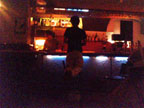
DIY Kit for Ubiquituous Computing and Free Networking
Alexei Blinov of Raylab and a group of collaborators have set out to create an exciting project, HIVE Networks, which promises to change the perception of ubiquituous or pervasive computing. HIVE combines the virtues of free software, free networks and open hardware to generate a framework for virtually any type of networked media application.
The group of independent programmers, artists and electronics specialists imagine swarms of intelligent network devices which all collaborate, facilitate media applications such as audio and video streaming and create clouds of free bandwidth using ad-hoc networking protocols.
The hardware basis currently is a customized Asus wireless hard drive. The firmware has been replaced with Linux and a cross-compilation tool kit has been developed. What this means is that any sort of application can be made to run on the cheap hardware which costs about 50 Euros a piece. For instance, a responsive environment could be built, using sensors, light, audio and video; or points of information exchange using wlan and bluetooth can be installed spread out in urban areas, because the individual units are cheap and replacable.
Blinov is keen to point out that the Asus boxes currently used are only the first step towards creating a framework for HIVE applications. The development is based on a set of key principles. The hardware has to be as cheap as possible and function according to widely used generic standards. The software has to be completely free and open source. Everything else is left to the creative imagination.
Raylab invites media practitioners to participate in application development for HIVE networks. Now that the basic toolkit has reached a phase of stability with increasing maturity, media practitioners - media activists, community groups, artists - are invited to come up with ideas for applications which Raylab will try to facilitate.
Ideally, in the next phase, this should all be done via a web based interface. The media practitioners do not have to get involved in deep technological development. All they need to do is click a few radio buttons to customize their own application which then will be compiled and installed on the device.
With HIVE Networks the traditional role, the artist who has an idea and gets a technician to develop the technical part, gets reversed. Here, creative technicians point out the future developments and offer a unique platform for artists. With HIVE ubiquituous computing takes on a new meaning. As the black box of technology is cracked open and made accessible, virtually anything is possible.
WORKSHOP: HIVE Networks - Swarms of information generating and processing devices
Friday, 09.09., 14.00 - 18.00
chip shop: application customization
Media practitioners, artists and developers are invited to share their visions of future applications for HIVE networks.
Both presentation and workshop are free. Please register if you want to participate in the workshop via email to: hive[at]kunstlabor.at
Posted by jo at 11:51 AM | Comments (0)
Aware Community Portals:
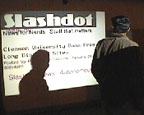
Shared Information Appliances for Transitional Spaces
People wish to maintain a level of awareness of timely information, including presence of others in the workplace and other social settings. We believe this provides better exchange, coordination and contact within a community, especially as people work in asynchronous times and distributed locations. The challenge is to develop lightweight techniques for awareness, interaction and communication using 'shared information appliances'. We have developed an exploratory responsive display projected within a shared workspace at the MIT Media Lab. The system uses visual sensing to provide relevant information while constructing traces of people's activities and shared interests over time. Such 'aware portals' may be deployed in casual workplace domains, distributed workgroups, and everyday public spaces." From Aware Community Portals: Shared Information Appliances for Transitional Spaces by Nitin Sawhney, Sean Wheeler and Chris Schmandt.
Posted by jo at 11:14 AM | Comments (0)
The Wallpaper

One Story, Multiple Viewpoints
In The Wallpaper, various elements of a visual and aural scene (humans, chairs, desks, ambient sounds) are recorded and stored separately from each other in a computer and then recombined in real-time during playback according to instructions in a script. Representing the scene in this way allows the creator of this piece to experiment with changing camera angles and shot selection, swapping characters, and modifying acoustical characteristics based on audience interaction in order to express different subjective points of view of the same story. The piece is also responsive to passive circumstances of its delivery, by showing more or fewer cuts and close-ups depending on the size and shape of the viewing window.
These two MPEG movies [1] [2] are two of many possible playouts of the production. One presents the story from John's subjective point of view, and the other presents Kathy's point of view. You will notice differences in shot composition, close-up placement, backgrounds, ambient sounds, and acoustics. The system is also capable of blending these two "extremes" to produce versions that mix the two story perspectives to different extents. In the actual piece, the viewer has real-time control over the subjective story perspective and the camera position. The Isis object-based media prototyping environment was used to script the entire presentation.
Posted by jo at 11:05 AM | Comments (0)
TeleMurals
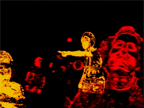
Blending [Distributed] Participating spaces
Telemurals is an audio-video connection where a communication space is created by breaking apart the pixels and speach of the participants at each end and reassembling them abstractly. The initial setup is straightforward. Two disjoint spaces are connected with an audio-video wall. Video and audio from each space is captured. The two images are then rendered, blended together, and projected onto the wall of their respective space. The difference between Telemurals and traditional media space connections are the image and audio transformations that evolve as people communicate through the system and the blending of the participating spaces.
Participation is required for this communication space to work. To reinforce a sense of involvement, we provide the system with some intelligence to modify its space according to certain movements and speech inflections. First, the image is rendered non-photorealstically. Second, words spoken in both spaces are captured, converted to text, and rendered on the screen in blocks left to fade away over time. The immediate feedback of seeing one’s spoken word alter the window lets them know they are adding to and affecting the shared environent. More complicated image manipulations are affected by changes in pitch and volume of the voice.
Much research has been conducted on the benefits and limitations of adding video to an audio communication channel. One of our goals here is to see how using non-photoreastic images influences conversation. Adding video to a communication channel improves the capacity for showing understanding, attention, forecasting responses, and expressing attitudes. A simple nodding of the head can express agreement or disagreement in a conversation. Gestures can convey concepts that aren’t easily expressed in words; they can express non-rational emotions, non-verbal experiences.
Yet these cues are not always properly transmitted. There may be dropped frames, audio glitches. Lack of synchronicity between image and audio can influence perceptions and trust of the speaker at the other end. Other challenges include equipment placement. For example camera placement has long been a reason for ambiguous eye gaze in audio-video links. A large camera offset gives the impression that the person you are speaking to is constantly looking elsewhere.
With Telemurals, we are creating an environment where rendered video maintains subtle cues of expression such as posture and hand motion, yet also enhances other cues. For example, changes in voice volume and pitch may be represented in the graphics of the rendered video. Audio conveys the speach inflections in conversation by altering parameters of the rendering. By adding another layer of abstraction into the video stream, we can enhance cues in a manner that is not possible in straight video streams.
Abstracting the faces is of big concern in the rendering. It builds on the intrigue of how one would appear if transplanted into this filtered space. Caricature and cartooning are such types of abstractions. There are elements of curiousity, humor, and surprise when seeing a caricature yet there is enough resemblance to make a personal connection.
The creation of an abstract environment in Telemurals has some similarities to virtual spaces in online worlds. Examples of fantasy environments for conversation can already be seen in online graphical communities. One essentially puts on a mask and enters an electronic communication space. This element of mediation removes many of the social barriers by allowing one to safely enter a stimulating world. Just as this lack of concrete identity may aid in suddenly and continually confronting new people in virtual environments, it may help in our physical-virtual hybrid. It has the added benefit of mitigating the perception of offset eye gaze and the effects of unsynchronized audio and video.
In this project, the abstraction of person, setting, and feedback provide the social catalyst for the experience. This new wall created by filtering creates an ice-breaker, a common ground for interaction, and a object for experimentation. How will one communicate in this abstracted space? How will their behavior affect their appearance and the appearance of the setting? How different is communication using photorealistic vs. non-photorealistic video? The goal here is to create a new styles of movement and speach interaction by providing a common language across the two spaces.
The first Tele-mural installation will connect two MIT graduate dormitories, Ashdown and Sidney-Pacific. The Tele-mural in Ashdown is located in the lower level in the common reacreation room. In Sidney-Pacific, the Tele-mural will be placed near the main entrance. This connection came about as the under-construction Sidney-Pacific dormitory committee was looking to put public art in its public areas and create spaces to encourage students to gather. Ashdown, the oldest graduate dormitory on campus was similarly undergoing renovations to create public spaces for social gatherings and the two dormitories were open to the idea of linking the older dormitory to the newer one. The sites within the dorms were chosen because they have high levels of traffic, are openly public , and because a large video wall aesthetically blends into the space.
Posted by jo at 10:52 AM | Comments (0)
Tangible Viewpoints
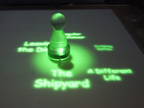
Graspable Surrogates in Multiple Point-of-View Interactive Narratives
Today's story creators have the opportunity to bring digital stories back into our physical environment. Using wireless and tag-sensing technologies, interactive narratives can make use of rich, haptic interactions with physical objects, combining them with the flexibility of digital multimedia content processing and delivery.
The Tangible Viewpoints project explores how physical objects and augmented surfaces can be used as tangible embodiments of different character perspectives in a multiple point-of-view interactive narrative. These graspable surrogates provide a direct mode of navigation to the story world, helping to bridge the gap between the realms of bits and atoms within the field of multimedia storytelling.
Using a system for interacting with a character driven-narrative, the different segments of a multiple point-of-view story are organized according to the character viewpoint they represent, as well as their place in the overall narrative. These segments can consist of various types of media (video, audio, images, and text), and can present character development, action, and location with as much complexity as any scene of a film or chapter of a book.
Posted by jo at 10:26 AM | Comments (0)
Public Anemone
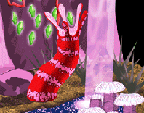
Robot Theatre
Inspired by primitive life, Public Anemone is a robotic creature with an organic appearance and natural quality of movement. By day, Public Anemone is awake and interacts with the waterfall, pond, and other aspects of its surroundings. It interacts with the audience by orienting to their movements using a stereo machine vision system. But if you get too close, it recoils like a rattlesnake.
The anemone starts each day's cycle with a high confidence level and a desire to complete various tasks (such as watering the nearby plants, drinking from the pond, or bathing in the waterfall). It chooses to either continue its tasks or interact with a participant based on their behavior and how much progress it has made with its tasks. If a participant wins the robot's attention, it will respond by orienting toward that person and following their movement.
If a participant gets too close or makes a threatening movement, the anemone may become frightened and recoil from the crowd until it regains its confidence. See Movie (.mov file, 5770 KB). Because the robot makes decisions based on its internal drives and audience interaction, each day is different from the next but follows a coherent theme.
Public Anemone is a collaboration between the Robotic Life and Synthetic Characters research groups at the Media Lab as well as MIT's Artificial Intelligence Lab.
Posted by jo at 10:19 AM | Comments (0)
WatchMe
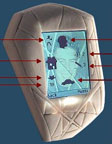
Communication Between Closely-Knit Group
WatchMe, by Natalia Marmasse, and Chris Schmandt, will be a platform for mobile communication and awareness, in the form of a watch, which addresses these limitations.
WatchMe enhances communication for a subset of people with whom we want an open channel of rich communication and for whom we want to be available. These are typically people from our "inner circle" with whom we have an established relationship, some common grounding, and a basis of trust. By sharing personal context information with our "insiders" we can enhance the instances of non co-located communication, and by providing channels of non-verbal communication we can foster more (verbal or non-verbal) communication and increase the existing sense of connectedness. The approach is to provide insiders with updated remote awareness information.
This mutual awareness serves two different purposes. First, it can strengthen the sense of presence of people we care about and may encourage further communication, besides being a form of non-verbal communication in itself. Second, it will provide insiders trying to contact us with enough information to make an informed decision regarding our availability and the most appropriate communication medium.
This project addresses mobile communication and awareness of people in a closely-knit group. It aims to enhance the telecommunication between them by providing relevant telepresence and a mobile platform facilitating various channels of verbal and non-verbal communication. Related: RealPlayer Movie; MPG Movie; UbiComp Paper (pdf).
Posted by jo at 10:08 AM | Comments (0)
Ars Electronica
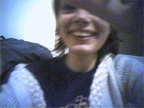
Regine Blogs Ars
TEMPEST is based on the surveillance technology known as Van Eck Phreaking - computer screen content can be reconstructed remotely by picking up the emitted EM-field of the screen. TEMPEST utilizes this technique to transform purely generative graphic into a composition of noise which again is fed back into the image generating process. Several AM receivers are tuned into different frequencies of a screen and plugged into an audio mixer for further sound processing. The graphics on the screen become a means of producing sound and it is only the graphics which determine the different timbres and rhythms. By Erich Berger.
Interface Culture at the Linz University of Art was founded last year by Christa Sommerer and Laurent Mignonneau. The programme deals with human-machine interaction to develop innovative interfaces. Went to see their works yesterday.
SoundToy, by Christina Heidecker, Harald Moser and Timm Oliver Wilks, is a 3D environment you navigate as if you were a racing car driver. During the ride you use the steering wheel to create and compose 3D sounds. You place in the space sound objects assigned to electronic beats. The speed, pitch and volume can be individually adjusted using the steering wheel and the accelerating pedal. The composition is generated by the movement and position of the sound objects with respect to one another but also by the route you select.
Recipe Table, by Istvan Lorincz, Hanna Perner-Wilson, Thomas Wagner and Andreas Zingerle, is an interactive workplace built into a kitchen countertop that enable users to intuitively search for recipes. You place the tins and bottle, vegetable and other ingredients and in return the system makes you recipe suggestions. These culinary suggestions are also depicted graphically as finished dishes on the workplace.
Blow, by Taife Smetschka, is a breath-controlled video installation. There's a microphone and a projection of a clip from Billy Wilder’s film *The Seven Year Itch*, the scene in which Marilyn Monroe stands on the grate above the subway ventilation shaft. At first she is stationary, smiling at viewers from the screen. She doesn’t begin moving until she feels a cool breeze. In *blow!* the breeze has to be provided by the installation visitors who must blow as hard as they can into the microphone. Marilyn’s skirt flutters in the breeze as long as the visitor blows into the microphone.
Mika Satomi's Gutsie is a cyber android filled with “guts.” Peeping into its interior through its eye-like hole, you can observe its intestines in motion. It will show you the places you want to see by tracking your eye gaze, but at the same time, your gaze may infect it. The interior of our body is something very private, often disgusting, and thus prohibited to be seen or to be shown. In media, visual images of our insides are often used to induce feelings of violence or disgust. Ironically, this is something that is stuffed inside everyone’s body without exception.
The G-Player (Global player), by German artist Jens Brand, works like a CD-player. But instead of playing CDs, it plays the globe. The device knows the postion of more than a thousand satellites and enables you, by the use if a virtual 3D planetary model, to listen to an imaginary trace of a selected flying object. Like a needle on a record, the satellite follows the Earth's surface. The G-Player transforms the different elevations units course directly into sound. The simple display shows the selected satellite's name, type, altitude and position over the planet (thus the latitude and longitude). Topographic data are interpreted as audio data. "Noise sounds" result from the high density of the data. Pictures.
[via we-make-money-not]
Posted by jo at 08:45 AM | Comments (0)
September 05, 2005
Boots as Instruments
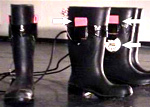
Cultural Gateway
Cobi van Tonder is a South African composer, producer and performer who specializes in interactive electronic music and other digital media.
Her interactive project Ephemeral Gumboots “uses sensor-equipped rubber boots to explore digital variations of a traditional South African dance form. This project was inspired by the desire to take historical or traditional art forms (in this case Gumboot Dance) and transform it into the Digital realm, creating a gateway between old and new and enabling dialogue between these two worlds.”
Ephemeral Gumboots is a human/computer-dance/music interactive system. Real-time rhythmical input from a dancer into a program ‘humanises' electronic beat-driven music while at the same time the dancer is exposed to a complex and diverse palette of prepared musical samples. The gumboots become musical instruments played by the dancer.
She outlines the dance, musical implications and technical aspects. For a thorough discussion of the project and research read her thesis on Music Composition and Performance in Interactive Computer/Human Systems.
Posted by michelle at 05:05 PM | Comments (0)
Pervasive Clue
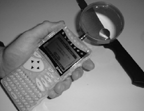
Live-Action Roleplaying
"How to Host a Pervasive Game Supporting Face-to-Face Interactions in Live-Action Roleplaying--by Jay Schneider, Gerd Kortuem (Ubicomp 2001)--describes an ubiquitous computing gaming environment that supports live-action roleplaying. The point of this is to enhance liveaction games and thave "a testing ground for our sociability enhancing mobile ad-hoc network applications." The game they present is called Pervasive Clue, it’s a "live-action roleplaying game based loosely on Hasbro’s classic board game Clue augmented with short-range radio frequency (RF) PDA devices."
The goal of Pervasive Clue is to discover who killed the host, Mr. Bauer, where it was done and what was the murder weapon. Solving the murder is done through the discovery of clues, when a player feels they can solve the crime they are allowed to make an accusation. If any of the crime facts (murderer, location or weapon) are incorrect the player is eliminated. [via pasta and vinegar]
Posted by jo at 02:10 PM | Comments (0)
September 02, 2005
Digital Photography Hack:

A Hands-Free Shooting Rig
"...The rig I came up with uses Mac OS X, and depending on the accessories you already have, will cost you from zero to a few dollars. Mac OS X is perfectly suited for this project, as it offers powerful standard tools, such as AppleScript. These tools have helped me think about new ways to record images, not to mention that the Mac platform is easy to work with. In fact, it only took me about an hour to design this system. Before describing how I built it, let's take a look at the final result.
This rig allows you to take photographs by saying "Take shot" into the microphone of a Bluetooth headset. The picture itself is taken by an iSight fixed on my shoulder. As voice recognition is not always perfect, especially in a noisy environment like a city, you'll hear "Picture taken" in the headset if everything went fine. Both the headset and the iSight are connected to a 12" PowerBook tucked into the backpack..." From Digital Photography Hack: A Hands-Free Shooting Rig by Romain Guy.
Posted by jo at 03:40 PM | Comments (0)
Olafur Eliasson
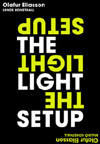
Partners in Image Generation
The light setup, the autumn show at Lund Konsthall, will present a wide spectrum of works by Olafur Eliasson from the years 1997-2005. Some 40 pieces – light installations, objects, models and photographs – interact to create a strikingly intense atmosphere.
Throughout his artistic practice, Olafur Eliasson has worked with natural phenomena like light, water and temperature. By inserting these into artificial surroundings Eliasson challenges us to sharpen our senses and to reflect on our relationship with and our understanding of the physical environment that we occupy in our everyday lives.
At Lund Konsthall various experiments employing ingenious technical solutions will turn the exhibition space into something reminiscent of a laboratory or artist’s studio where visitors can not only study the techniques involved but even experiment themselves. Presenting the constructions as an important aspect of the works is a way of deliberately demystifying the phenomena that the visitor encounters and helps to break down their seemingly sensational aspects. Eliasson thus invites visitors to be aware of their own vision and to take an active part in creating and experiencing the works. We become partners in creating the images that are generated.
Olafur Eliasson’s artistic practice is characterized by the serious study that underlies it. In this regard his approach is similar to other types of research illustrated in various ways through the series of photographs, models and light experiments that will be on display at Lund Konsthall. In the manner of a visual inventory the series of photographs document phenomena like melting ice flows, deep pools and horizons. They are grouped according to subject types and presented in accordance with a strict grid pattern. However, in a work like Room for one colour the careful examination of the wavelengths of light is given a playful framework which results in all the colours in the room being subordinated to the yellow nuance and being seen as a scale consisting of shades of black and white. This playful inventiveness is highly characteristic of Eliasson’s art.
The two exhibitions featuring Olafur Eliasson to be shown this autumn are being jointly organized by Lund Konsthall and Malmö Konsthall. They can be seen as a single entity offering a unique opportunity to engage with Olafur Eliasson’s wide-ranging oeuvre. The Lund exhibition illustrates the breadth of Eliasson’s artistic investigations, while at Malmö Konsthall the experiment has been enlarged into a giant format which shifts the focus from the experimental aspect to how we experience the results of the experiment. Examination of the light is a central aspect of the new work that fills Malmö Konsthall. The two exhibitions complement and enrich each other and point to the complexity underlying all of Olafur Eliasson’s work; the interplay between experiment, experience, a work of art and “reality”.
Olafur Eliasson was born in 1967. He is currently based both in Berlin and Copenhagen. Among his recent exhibitions and projects we may mention: Minding the world at the ARoS Kunstmuseum in Århus, 2004, Your lighthouse at the Kunstmuseum Wolfsburg 2004, The weather project at Tate Modern in London 2003, The blind pavilion, the Danish pavilion at the Venice Biennial 2003, as well as public commissions in Denmark and Sweden including a candelabra for Copenhagen’s new opera house 2004 and Movement meter for Lernacken by the new bridge in Malmö 2000.
Welcome to the opening!
Lund Konsthall Friday 9 September 5-7 pm
Malmö Konsthall Friday 9 September 7-9 pm
Posted by jo at 03:35 PM | Comments (0)
NOTE TO SELF
Skin Problems
"...Tomorrow night, artist Mary Coble will subject herself to a marathon tattoo session that could make a career Marine wince. Beginning at 6 p.m. and likely continuing until dawn the next day, a tattoo artist will etch 400 names into the artist's back, legs and arms. And we're all invited to watch. The 26-year-old Washingtonian's show at Conner Contemporary Art is a rare opportunity to see performance art locally -- not to mention the chance to witness an artist literally spill blood for her cause and craft. It's open to the public from 6 to 8 p.m., and viewable for its duration via a live Webcast." From An Artist Pricks Her Skin and Our Conscience Over Hate Crimes, by Jessica Dawson, Special to The Washington Post, Thursday, September 1, 2005; Page C01. [via Rhizome]
Posted by jo at 03:25 PM | Comments (0)
FALLING LIFE
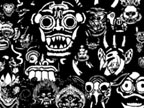
Crashing Ars
Falling Life is an ongoing project that was introduced for the first time in Berlin in August 2005. This urban screening project doesn’t need a curator or a gallery; it doesn’t need a fixed place or access to electric power. The artists are equipped with a car, a laptop, a compact light powerful projector and a small power generator. With this very mobile equipment the artists are able to have an instant presence in the urban landscape. They use facades of buildings that can be immediately changed into a projection screens. What makes the project exciting is the variety of possible buildings as a projection surface: the more uneven and in relief they are the more magic they look. Without any preparation and without any permits the artists are operating in a kind of projection guerrilla style.
Michael Bielicky and Kamila B. Richter are using a minimalist language of white constantly appearing and disappearing pictograms. The moving icons represent the collective reality of our interconnected globalized world. With the help of an algorithm the combination, amount, size and speed of the objects is permanently changing and so the image is never the same. The artists don’t reduce only the form of the displayed objects but also the color absence results in a pure white light. It is fascinating that the whole movie with a 25 different sequences can have a size of 250KB!!!
The next public appearance of Michael Bielicky’s and Kamila B. Richter’s light projections will be in September at the Ars Electronica festival in Linz. The (not invited) artists will apply the theme of this year festival - “Hybrid – living in paradox” on the Ars Electronica itself: Ars Electronica is living in paradox. The artists use the same hybrid strategies Ars Electronica aims to discuss as they create their own hybrid Ars Electronica layout by copying and recombining some of the language and pictorial units used for this year Ars Electronica’s promotion material. Michael Bielicky and Kamila B.Richter: x[at]avu.cz. Also see Locomotion.
Posted by jo at 10:52 AM | Comments (0)
Unusual Encounters

Chance Encounters
Unusual Encounters is a three-part, web-based art project in which Jean Paul Gaultier has had the pleasure of participating and which is a mixture of creative sophistication and the latest technology, unique in the world, viewable at this address. Designed by the film director David Mileikowsky, under the artistic direction of Jean Paul Gaultier, the Unusual Encounters site proposes 3 original modules, offering 3 unique meeting experiences:
On September 9th, an on-line artistic improvisation will be organised for 500 trendsetters around the world and we have the pleasure of inviting you to take part in this exclusive venue. On that day, "Zhang will meet Veng" and for the first time ever, the unusual encounter between two unrivalled virtuosos, Maxim Vengerov and Zhan Yimou, the Russian and the Chinese, the violinist and the film director: two meteors of the Modern Arts will be brought together online in a live artistic performance, somewhere between China and Germany. Some 9000 km apart, the amazing duo will perform on-line, in unison. The first showing is scheduled for September 9th, at 12:00 exactly (Paris time).
You might also like to try Tango Painting, available as of today! For the first time ever, this multi-user graphic application allows user pairs to simultaneously draw up, from a distance and in an entertaining way, multimedia forms, regardless of their skill level. Their work can then be complemented by creations from artists such as Jean Paul Gaultier and Jean-Baptise Mondino, then shared with others on the web.
Finally, on September 10th, The Perfume Alchemist will be presented in an on-line world premiere. This visionary manga by Alain Escalle (director) tells a story of a child, a little prince of the streets, in a high-rise megalopolis, who decides to create the perfume of his dreams. Thanks to "Manga Maker", an on-line video editing platform, every user can participate in the adaptation of the course of the story and then pass the modified story on to his/her soul mate. An extract of this manga is available here.
Posted by jo at 10:25 AM | Comments (0)
Bondage
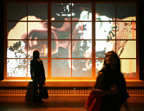
Bound by Pixels
Bondage creates music using pictures of Japanese women made by Japanese photographer, Nobuyoshi Araki. The photo was scanned and projected onto a shoji – the traditional Japanese rice paper wall with sliding doors. The photographs are fed into an image-synthesizing program, scanned and analyzed to become the harmonic spectrum of the sound to be arranged and mixed. Visitors reveal hidden layers of photographs that are projected onto a paper surface. With their movements in front of the installation, they scan the image and modify it, which simultaneously activate the installation’s sound environment. Created by Atau Tanaka. Metasynth processing by Eric Wenger. [blogged by Regine on we-make-money-not]
Posted by jo at 08:42 AM | Comments (0)
URBANtells
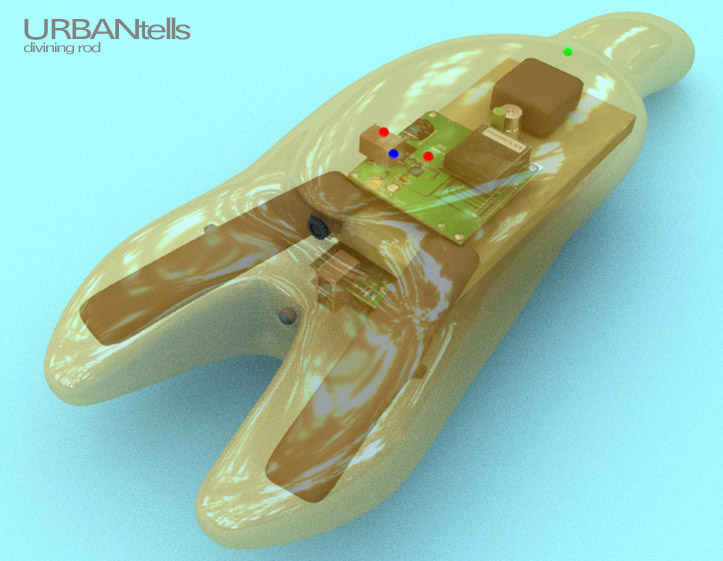
Exploring the City with Digi-Diviner
URBANtells is a mobile sound installation in which the user explores a neighborhood on foot, "data-diving" with a handheld device called digi-diviner. Participants will provide their cell phone and email address to an attendant at a kiosk. In return, they will be given a digi-diviner to walk and explore the neighborhood. A minute or so after they go outside a real time mix of sound art and verbal information triggered by their location will start to play through an earbud attached to the diviner. The information is a mix of recordings of residents and historians, text-to-speech synthesis, recitations, musique, and other processed sound. The information will address the complex layers of personal and collective histories and experience in urban environments, and the degrees to which these acoustic "tells" influence behavior and development within a community similarly to traditional, physical structures.
Users will be able to upload sounds, text, and still images they capture with the diviner en route. This information will be available to other users. Upon returning to the kiosk, participants will receive an interactive Google map of their specific walk via email, containing buttons to play sounds and view images they may have uploaded during their trip. Urbantells, a project by James Rouvelle, Joe Reinsel and Steve Bradley, opens June 2, ‘06 at Art Interactive, Cambridge, MA. [blogged by Regine on we-make-money-not]
Posted by jo at 08:30 AM | Comments (0)
Interface #4 / TFT tennis V180
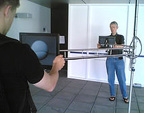
Laptop Racket
In Interface #4 / tennis V180 two people play tennis using comtuper screens as rackets. The installation bridges the gap between an actual game of tennis and popular computer games like "Pong." You have to place your screen like a racket in front of the approaching virtual 3D ball. You hold the screen in your hands and move it from left to right or flip the sides The flip rotation determines the angle and thus the trajectory of the ball after impact on the screen. The position of the steel arms and the "flip" rotation between the screen and the arm influence the perspective of the 3D field which each player sees while playing the game.
On the four rotating points of the installation sensors are placed which detect movement and determine the status and position of the installation. Quite addictive. There were people queuing to try the game and it was hard to give my place to someone else. By Dutch artist Dirck Eijsbouts. Images. [blogged by Regine on we-make-money-not]
Posted by jo at 07:47 AM | Comments (0)
Hacking your Xbox

Authorship<<>>Ownership
What is an Xbox? The answer seems pretty obvious… A game console...?
Apparently not. Those responsible for the Xbox Linux Project state that "The Xbox is a legacy-free PC by Microsoft that consists of an Intel Celeron 733 MHz CPU, an nVidia GeForce 3MX, 64 MB of RAM, a 8/10 GB hard disk, a DVD drive and 10/100 Ethernet. As on every PC, you can run Linux on it. An Xbox with Linux can be a full desktop computer with mouse and keyboard, a web/email box connected to TV, a server or router or a node in a cluster. You can either dual-boot or use Linux only; in the latter case, you can replace both IDE devices". It is possible to hack your Xbox and turn it into much more than a plain product for playing games.
What was done here, the modification of an Xbox so it can work as a personal computer running Linux operating system, is one of many examples of an increasingly frequent activity, the personalization of technology. Actually it can be thought of a cultural activity within digital culture. Gameboys as musical instruments, personalized AIBOs, the list could go on forever…
Electronic products using computer technology are open to modification and such activity has become very interesting to observe. These products are now seen more as processes than plain objects and thus, easily transformed into something different of their initial purpose, something that suits better their owner’s purposes.
This meaningful use of technology allows the development of communities and a political involvement of its members. It is stated on the Xbox Linux Project: “Welcome to your Xbox. For the first time the box you paid for can do what you want it to do. As the owner you are where you should be – in control”. This last sentence also points to another aspect of user-personalized technology: being an author as part of owning the technology. Authorship in the sense that the object has been transformed into something different, the raw material is the technology before the author’s action upon it and the finished product (“the work”) is the user-altered, hacked, technology.
So if you’re the proud owner of an Xbox and are tired of playing the same games over and over again, go on, visit the Xbox Linux Project and transform your console into a Linux operating computer. Own it to the limit.
The Xbox Linux Project
http://www.xbox-linux.org/wiki/Main_Page
Posted by luis at 07:43 AM | Comments (0)
September 01, 2005
Scrapple
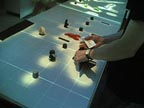
A Physical Score Table
Scrapple: A physical active score table, by Golan Levin, is a physical version of the screen-based Audiovisual Environments (AVES) devised for the Scribble performance in 2000.
In Scrapple, object placed on the table become sound-producing elements that determine the score's rhythm and pitch. They are interpreted as sound-producing marks in an active score: flexible shape-holding curves allow for the creation of melodies, a group of small toys and other moving objects yield ever-changing rhythms. Video projections on the table turn the installation into a simple augmented reality, in which the objects are elaborated through colorful and explanatory graphics. [blogged by Regine on we-make-money-not]
Posted by jo at 06:12 PM | Comments (0)
Jumping Rope
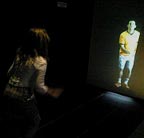
Action Driven Narrative
Jumping Rope is the classic children's game of jump rope transferred into the digital world. Your skill at jumping an invisible rope determines the course of a film narrative. You have to stand between two projection surfaces that each display a different figure holding a jumping rope. You can see on the screen how they are turning the rope but you have to mentally see the rope in order to jump on time. Your talent at jumping is evaluated by a video camera equipped with motion-tracking technology.
If you're good at it, the characters are encouraging and play with you. There are three different scenarios played by three different couples. The installation offers a simulated life situation in which you, as an adult, suddenly realise that your behaviour is pruned through a haunting invisible rope by the people around you (your parents, colleagues, boss, etc.), that you might be "trapped" between two characters or still be dancing to someone else's tune.
In Jumping Rope, the participant becomes a part of the cinematic situation and their jumping enables the scenario to progress and the plot to develop. A work by Portugaly Orna, Talithman Daphna, Younger Sharon (who also made Heartbeats). Video. [blogged by Regine on we-make-money-not]
Posted by jo at 06:00 PM | Comments (0)
Six Degrees of Smoking

The Secret Lives of Lost Lighters
Have you ever wondered what happens to your cigarette lighter when you lend it to someone and don't get it back? Six Degrees of Smoking is a global artistic collaboration to delve into the secret lives of lost lighters. Lighters are handed out or posted to those who wish to be involved. The recipient then photographs themselves smoking a cigarette and submits it via MMS or email. He then passes the lighter on to a fellow smoker (either a friend or a stranger) and the process is repeated. Each lighter is numbered and so they can be tracked on their travels. [Remember Traces of Fire?]
Posted by jo at 05:11 PM | Comments (0)
Guest Blogger
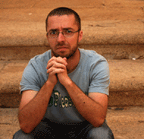
Luís Silva
Luís Silva is the curator of Portuguese Netart 1997 | 2004. He studied Social Sciences and is now completing his MA on Communication, Culture and Information Technologies. Silva is finishing a research project concerning the transformations on the contemporary art worlds caused by the use of digital tools in creating art works. He has written several texts addressing the issues of art and technology. Silva has also developed his activity producing contemporary art shows since 2003, mainly of Portuguese contemporary artists. Visit his blog Source Code. Welcome Luís!
Posted by jo at 01:08 PM | Comments (0)
Spot On:
Virtual Gaming's Elusive Exchange Rates
"MMORPG assets are being traded for real-world money. Are these virtual economies giving gamers their fair share?...
...While it may be hard today to arrive at accurate exchange rate data, many think this dynamic will change over time, mostly because the overall value of the market will one day be too big for real-world governments to ignore.
"Eventually, there's going to be a portfolio of these synthetic currencies," said Castronova. "Cyberspace nations that are issuing these currencies are going to be under legal obligation to report sales and volumes and transactions, because in worlds where those currencies can be freely liquidated into dollars, there are clear tax implications..." From Spot On: Virtual Gaming's Elusive Exchange Rates by By Daniel Terdiman, News.com.
Posted by jo at 12:14 PM | Comments (0)
Behind the 8-Ball:
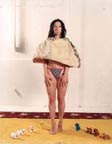
Sarah Michelson
"Yesterday, winding my way through the new Walker, I witnessed what must’ve been choreographer Sarah Michelson’s dancers rehearsing for the performance of Daylight (For Minneapolis). As Michelson is notoriously tight-lipped about revealing details on her performances beforehand, I can’t give anything away. But expect surprises (and perhaps a stone-still dancer with a Walker Shop bag over her head). Still, as the description of her September 15-18 performances leaves just about everything to the imagination–”a dance/installation experience inspired by the design of the Walker’s new building”--perhaps a look at her earlier works can offer an inkling.
In a 2003 performance at the Kitchen, typical audience/performer relationships were reversed. Viewing bleachers were on stage, facing out, and when the performance began, the house lights went up, not down. Artforum describes what happened next: “[T]he doors to the Kitchen swung open instead of shut, and all the way, across the street, two spotlit dancers in bright yellow tunics walked in unison down three steps of the building opposite and danced, in small side-to-side motions, into the performance space itself.”
For Part I of Daylight, presented at PS 122 in June, she placed “the audience in a kind of box, with the musicians behind them, and leaving a performing space that was only about twelve feet deep,” wrote Joan Acocella in The New Yorker. “This show was one of the strangest things I have ever seen. The four dancers entered through an upstage passageway that looked like something from Dr. Caligari's house. They then launched into a carefully rehearsed, largely unison dance that was traditional in one sense--it was done on the music--and in no other.”
And in a choreographic commission for Baryshnikov and his White Oak Dance Project, Michelson “costumed the ballet legend in Velcro handcuffs, gold chains and an ankle-length, see-through Chanel skirt, and set him to dance on a stage carpeted in bubble wrap. Such is her eclectic idea of elegance, never too pristine,” wrote Art in America.
Or maybe her personality, or as much of it as comes through an eight-question artist questionnaire, can offer some ideas about what to expect. In the September issue of Walker we ran our usual 8-ball Q&A with her. Here’s another eight:
What's the last (or favorite) book you read?
Experience by Martin Amis
If you could throw a dinner party for anyone in the world, who would you
invite?
Tonight? Parker Lutz [a dancer in Michelson’s company].
How do you like to unwind/relax?
Bath, sleep.
If you could change one thing about yourself, what would it be?
Cellulite. My bank balance. My loneliness.
What artists are you most interested in at the moment?
How does one answer a question like that?
What is your favorite euphemism?
Bathroom.
Who is your favorite villain of fiction?
Keith Talent [Protagonist in Martin Amis’ London Fields]
What question do you wish we asked you?
The answer is: grace is crucial.
No closer to understanding? Me neither. I guess we’ll have to show up and see for ourselves…" [blogged by by Paul Schmelzer on Off Center]
Posted by jo at 12:04 PM | Comments (0)
UNESCO Online Seminar
![]()
Art, Design and Technology Master Classes in the Arab States
Creative Thinking, Writing and Design UNESCO Online Seminar, CALL FOR APPLICATIONS [in cooperation with Lebanese partner universities ALBA, AUB and LAU and Finnish Media Lab, UIAH]. The course will focus on the intellectual linkage of art, design and technology. Students will also be presented with a range of criteria to analyse the context of creative practises in new media. 50 students will be selected to participate in the first online phase of the course.
Course Content, Part 1: Introduction to Art and New Media in the Arab States, with a case-study of Lebanon; Arabic typography and design culture; Typographic Landscape in the Arab world.
Dates of the Course
- Applications/pre-registration: 01 September 2005
- Application close: 14 October 2005
- Programme starts 31 October 2005
- Programme finishes 28 February 2006
Online application open to students :
- From the Arab States with Bachelor's degree in design (graphic, industrial, furniture, fashion, etc.), architecture, arts (fine arts, music, etc.), computer sciences, media (journalism, video/film, etc.), humanities (history, political sciences, social sciences, history, languages, psychology, education)
- With good computer skills and have creative interest
- With an online portfolio
More information and registration online at:
http://moodle.uiah.fi/unesco
Posted by jo at 11:52 AM | Comments (0)
A Furthernoise.org Real-time Event

The Point @ Furthernoise's Visitors Studio
Welcome to a collaborative event between The Point Community Development Corporation, based in New York and Furthernoise.org who are based in the UK. The first invited guest Chris Vine will be mixing live from Londrina, Paraná, Brazil. The second guest Mark Francombe will be mixing live from his home in Oslo.
Those in New York can visit the centre in the Bronx, and those who are not in New York around that time can also visit the Visitors Studio, event live online, via the Internet. Physical event: Live Broadcast in the Theatre of The Point Community Development Corporation, Hunts Point, The Bronx, New York.
Date & Times:
Sunday 4th September. 4 - 6pm BST. from 11 am to 1pm.
Time Zone Converter: http://worldtimeserver.com
Visitors Studio: http://www.furtherstudio.org/live
The event will last for 2 hours with the individual performances lasting 45 minutes each. Chris and Mark will also be available online afterwards to chat about their work with others using the 'Visitors Studio' chat faciltiy. The studio will then be re-set, open again for everyone to mix collaboratively.
Chris Vine - 4 to 4.45 pm
Mark Francombe - 4.45 to 5.30 pm
Open mixing for all to close event.
Residents of New York can watch the event broadcast live in Theatre of The Point Community Development Corporation Hunts Point, The Bronx, New York from 11 am to 1pm.
[[[Warning the event may contain strobe lighting effects]]]
Information about the 2 guest artists:
Chris Vine - Associated with the 'Downtempo' jazz scenes in New York and Washington DC during the 1980's working with composers such as multi-instrumentalist Elliott Sharp & drummer Bobby Previte and then guitarist with Ted Miltons UK cult punk jazz group Blurt during the 90's, Chris Vine is an innovative musician, composer and artist. He is also a founding member of the Canton Opera Company which collages baroque arias with abstract soundscapes and is currently touring Brazil performing a live score with dance theatre company Verve Companhia de Dança. He will be mixing live from his home in Londrina, Paraná, Brazil.
Mark Francombe - is a composer, performer and artist with a well heeled reputation for experimental electronic and improvised music. A founding member and guitarist of the 1980's UK indie band Cranes he recorded and toured extensively throughout Europe before moving to Norway in 1997. He composes & performs with modified, heavily treated, baritone guitar and releases his music through small independent CDR labels including his own Synch Non Synch label. His recent album Ear, Nose & Throat is released through Oslo based Synesthetic Recordings and is featured in the current edition of Furthernoise where he also contributes as a reviewer. He will be mixing live from his home in Oslo.
enquiries: roger[at]furthernoise.org
http://www.furthernoise.org
Info about Visitors Studio.
Posted by jo at 11:23 AM | Comments (0)
UpStage
![]()
Open Session & Improv: September 7
The next open session in UpStage will take place on Wednesday, September 7 at the times below. This time we will divide into two groups, with a beginners' session happening on the Introduction stage while those who've already learned the basics will go to another stage to improvise a short performance for an hour. In the second hour, we will invite everyone to watch and interact with the
performance.
Wednesday 7 September: California: 2am; New York: 5am; UK: 10am; Western Europe: 11am; Finland: 12 noon; Australia (NSW/QLD): 7pm; Aotearoa NZ: 9pm. Check http://www.worldtimeserver.com/ for your local times. If you want to come and learn, email me for a log-in. come to http://upstage.org.nz:8081/ to log in, then follow the link in the top right hand corner to the Introduction stage.
If you want to come & improvise a performance, you still need to email me (in case we run into double-ups with guest log-ins) & we'll also meet at the introduction stage, then move to another stage to work. I'm proposing the theme of "water" as a starting point (given recent floods in Europe & the global problem of the growing lack of fresh water in the world) so you can think about backdrops & avatars that relate to that theme. If you upload any graphics, assign them to the Virtual Tourist stage & we'll use this one for the improv.
If you'd just like to come to watch the performance, you don't need to log in. Come to the Introduction stage towards the end of the first hour of the session, & when the performers are ready you will be led through to another stage.
Any questions, email me, & i hope to see you next week.
helen varley jamieson: helen[at]creative-catalyst.com
http://www.creative-catalyst.com
Posted by jo at 11:06 AM | Comments (0)
Miragraphy

RFID Enabled Mirror
Hitachi announced yesterday a new mirror that functions as a computer display. It will be available for purchase in Japan on September 30. It combines a half mirror and a diffusion film to directly display digital information (text, photos, video, tv shows, websites, flash movies etc.) on a mirror surface using a LCD projector. This technology, called Miragraphy, also integrates sensors, RFID readers, barcode readers, cameras, etc. So, the mirror can automatically respond when people are around and personalize digital contents based on their sensed identities.
The Miragraphy device could potentially be used at restaurants, bars, hotels, trainstations, airports, sports clubs, show windows, designer clothing shops, and accessory shops. [blogged by konomi on RFID Japan]
Posted by jo at 10:38 AM | Comments (0)
Sonic Fabric 2
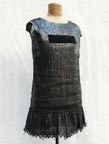
Sacred Sounds
Sonic Fabric is Brooklyn-based artist Alyce Santoro's venture that weaves textiles from recycled audio cassette tapes recorded with sounds she considers sacred. The fabric emits a melange of sound when swiped with the head from a tape player and can double as a musical instrument, like when Jon Fishman of Phish wore Santoro's "Sonic Rhythm Dress" and gloves fitted with tape heads in concert. Partly inspired by Tibetan Buddhist prayer flags printed with blessings activated by blowing winds, Santoro sells silkscreened flags, an over-the-shoulder Monk/Messenger bag, swatches, and flags made with the custom sound collage from Fishman's dress on the Sonic Fabric site. You can peruse her other work, including the Silence Dress (pictured above), which is "black sonic fabric with black velvet patch of silence" on her personal site. In the future, look out for sonic fabric handbags that she's currently having produced at a women's craft co-op in Nepal. [blogged by Ami Kealoha on Cool Hunting] [Related]
Posted by jo at 09:25 AM | Comments (0)


